
K sher Entertainment THE PURIM ISSUE


ד"סב





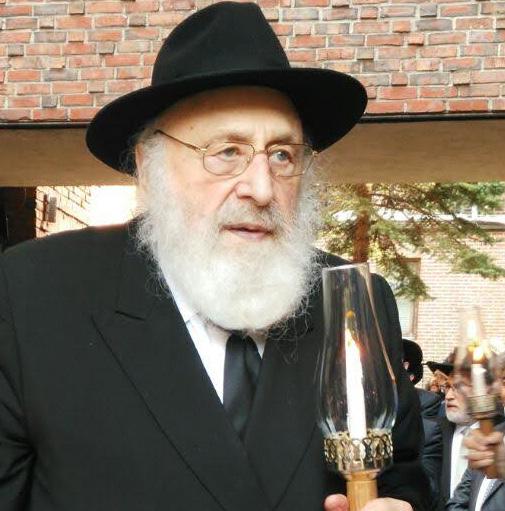
Message for Purim
A LETTER FROM THE REBBE FOR PURIM
From Haman to Hamas RABBI
Photographing the Rebbe MARC
Rabbi Dovid Schochet’s
Kosher Entertainment
A Dangerous Farbregen DOVID
Is Your Single Malt Kosher?
TZEMACH
Designing a Tznius Brand DANIT
Curating the Golden Path
TZEMACH
Soulful

YEHUDA CEITLIN
ASNIN
FELLER
Legacy TZEMACH
RIVKAH KATZ
ZAKLIKOWSKI
FELLER
SCHUSTERMAN
FELLER
ZAKLIKOWSKI 46 14 הכרבה תא 'ה הוצ ןאכ .ד"סב 6 10 12 14 20 26 32 38 42 46 20 26
17 ADAR II 5784 MARCH 2024
Stam DOVID
ISSUE
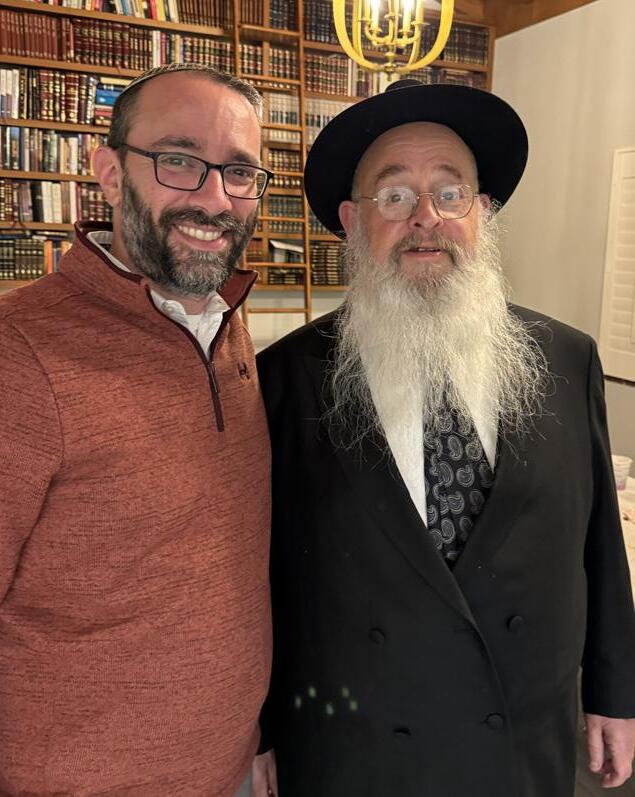






Purim with the Rebbe PRESENTED BY JEM Chinuch Matters The Fish that Saved the Jews ASHARON BALTAZAR Meet the Author RABBI YAAKOV KRASNIANSKI If there's a Will... Business Digest ZEV GOTKIN My Take on Psychedelics Baby Bites Shoshanas Yaakov RABBI YOSSI LIPSKIER
Inside Track SRULY MEYER
Corner
Ancient Cherem RABBI SHRAGA HOMNICK Kids Korner Costume Conundrums MORDECHAI SCHMUTTER Then and Now 529 EMPIRE BOULEVARD 52 58 62 66 68 70 72 74 76 78 82 86 88 92 94 42 78 82 32 86 94 38
The
Food
The
Publisher
Mica Soffer
Editor
Yehuda Ceitlin
Associate Editor
Mendy Wineberg
Contributing Writers
Asharon Baltazar
Tzemach Feller
Zev Gotkin
Dr. Avraham Gottesman
Rabbi Shraga Homnick
Libby Herz
Rivkah Katz
Sari Kopitnikoff
Rabbi Yossi Lipskier
Sruly Meyer
Esther Rodal
Mordechai Schmutter
Danit Schusterman
Daniel Schonbuch
Dovid Zaklikowski
ADVERTISING
ads@COLlive.com
718-427-2174 ext. 2
EDITORIAL INQUIRIES OR SUBMISSIONS
Editor@COLlive.com
718-427-2174 ext. 1
COLlive Magazine is published in print periodically by the Collive Media Group Inc. and is distributed free in Brooklyn, NY. COLlive does not endorse any products or services reported about or advertised in COLlive Magazine unless specifically noted. The acceptance of advertising in COLlive Magazine does not constitute a recommendation, approval or other representation o quality of products or services, or the credibility of any claims made by advertisers including, but not limited to, the kashrus or advertised food products. The use of any products or services advertised in COLlive Magazine is solely at the user’s risk and COLlive accepts no responsibility or liability in connection therewith.
From the Publisher
Some 10 years ago, we featured on COLlive.com an interview with Chaim Hershkowitz, the filmmaker behind the now-staple children’s videos such as Mitzvah Blvd, Bella Brocha, and Wonders of Hashem. Chaim was working on his latest production: a video about the Rebbe’s niggunim.
The video, released on DVD at the time, cleverly weaved a story of grandchildren finding a record player and asking their zaidy about its function. He proceeds to play tracks on the record - beautiful melodies the Rebbe taught Chassidim - and explain their background and meaning.
Chaim told us: “With all the attractions and distractions that are available for kids, I knew that it was time for something that reinforces who we are as chassidim.”
“But I must tell you,” he added. “I could not have imagined the positive effect it has had on my family. While I’ve been working on this project, my 8-year-old son has been walking around the house singing these nigunim! Similarly, I believe it will ignite the Chabad spark in many of our kids.”
Indeed, it has. Chaim has since released a part 2 and went on to level up the quality and availability of frum entertainment for children. Today, he oversees the Toveedo video streaming platform that keeps children glued to the screen while instilling educational messages.
Today, almost every English-speaking Lubavitcher can cite lines from those videos - either because they remember them from childhood or have heard their children watching them on those endless loops during car rides and downtime before Shabbos.
But what most people - and certainly the young viewers - don’t know, is how much effort is invested in creating meaningful content. “It's a long process,” he told us back then.
“In general,” he said, “there are a lot of ways to approach any topic; rather than to commit to the first thing that comes into my mind, I write down lots of random thoughts, then I review them hundreds of times. I eliminate a lot of ideas because they could take too long or cost too much or produce. Once I’ve found the strongest idea, I start developing a script.”
All that is before casting, staging, filming, editing, graphics, choosing music, marketing, and more. And paying subscribers expect new videos to be released regularly - and for it to hold up to the standards of “kosher entertainment.”
It is truly a hard act to pull off, but Chaim has been doing it. We feature him as our cover story of this magazine in recognition of his dedication and success in bringing joy to Jewish children worldwide. He also reveals the plan for his upcoming project, geared specifically to Chabad children.
We look forward to continue covering his endeavors.
Sincerely,
MICA SOFFER
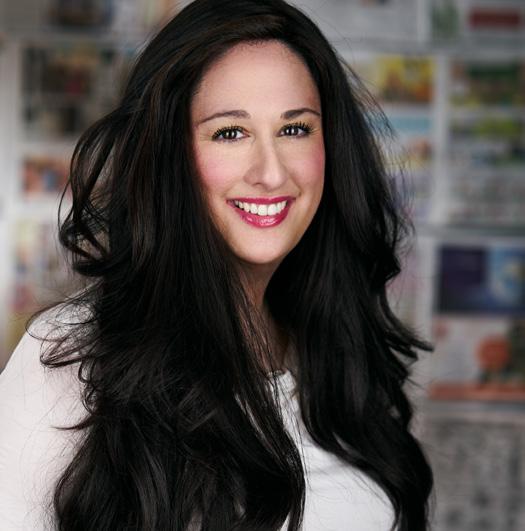
718.679.9450

FIND US ON SOCIAL MEDIA: @COLlive @COLliveOfficial
















PlumbersHaven.com | (718) 604-1300 516 Empire Blvd Brooklyn, NY 11225 @plumbershaven Your home is your haven. FULL LINE OF: Vanities Shower Systems Whirlpools Faucets & Coordinating Bathroom Fixtures
A MESSAGE FOR PURIM
No one is too important to engage in Jewish Education

7 Adar, 5712
Brooklyn. N.Y.
Sholom u’Brocho:
In connection with the forthcoming days of Purim, I wish to call the attention of my fellow Jews to a significant event connected with the miracle of Purim, an event which has a profound and timely message for all of us.
Our Sages relate that when the terrible decree of annihilation of the Jews, planned by Haman became known, Mordechai went out into the streets and gathered 22,000 children, whom he taught the Torah and with whom he prayed for G-d's mercy. He imbued them with the spirit of self-sacrifice. so that they declared unanimously: "In life or in death we will not part from thee." By this action the heavenly decree for the Jews was rescinded and reversed from death to life, and from mourning to gladness - physically, as well as spiritually.
Let us remember that Mordechai was one of the heads of the Sanhedrin, the greatest Jew of his time, "like Moses in his generation." Nevertheless, he went out in person to teach the holy Torah, with piety and mesiras nefesh, to small children.
8 COLLIVE MAGAZINE ADAR II 5784

The lesson for everyone of us is clear: No matter what one's station in life, or how important one's activities seem to be, one must, first and foremost, dedicate at least some part of his time and efforts to the most important of all causes - saving our young generation by implanting into them devotion to all that has been holy to us ever since our ancestors received the Torah at Mount Sinai and we became a "Kingdom of Priests and a Holy Nation”, devotion to the point of self-sacrifice. Only in this way can we make sure that the young generation will be ours, and, as a matter of course, ensure the existence of our people. And great is the merit of this work, for therein lies our strength against all Hamans and our security under G-d's protection.
It is well to bear in mind that the education of the young is very much like the planting of a seed. A slight defect in the seed, the like of which in the grown tree may be of little or no consequence, assumes major proportions in respect of the whole growth that is to come from the seed, to the extent of crippling it. Similarly must the utmost care be taken to ensure the proper education and upbringing of our children, boys and girls. A slight deflection from Torah-true education may have a crippling effect, G-d forbid, upon the whole future of the child and generation to come.
May G-d grant you success in your work for kosher Jewish education, and especially in increasing manifold the number of children under your care, and may he bless you to enjoy "The good attributes of the Holy One Blessed Be He, which come in abundance, fruitfulness and multitude".
With Purim greetings and blessings,
/Signature/




from

TO COUNTER HATE
 By Rabbi Yehuda Ceitlin
By Rabbi Yehuda Ceitlin
10 COLLIVE MAGAZINE ADAR II 5784
The name of Haman, the adversary of the Jewish people in ancient Persia, brings to mind the current villain in the Jewish narrative, the Hamas terror apparatus in Gaza. And it’s not just their names that sound similar.
Haman sought to “destroy, kill and exterminate all the Jews, young and old, infants, and women, in a single day,” the Book of Esther recounts. Hamas sought to do the same on October 7, 2023. Following their 1988 charter, Hamas acted in accordance with its belief that “the Day of Judgement will not come about until Moslems [kill] the Jews.”

It is only natural to look to the story of Purim to draw inspiration from how the Jewish leader Mordechai and his heroic cousin Queen Esther dealt with the antisemites of the Persian Empire, as we face those who want to destroy the Jewish people today.
1. Hate Proliferates
The Persian Prime Minister Haman was furious that Mordechai refused to bow to him. Despite this, he did not want to punish Mordechai alone, as he considered it beneath him. Instead, Haman decided to plot the destruction of all the Jews in Ahasuerus’ kingdom. Hate starts with one individual yet quickly spreads to encompass an entire group of people.
2. Start With Spiritual Support
After King Ahasuerus approved Haman’s plot to annihilate the Jews, Mordechai “cried a loud and bitter cry,” and led the Jews to engage in “fasting, weeping and lament.” They understood that their transgressions had given the green light for this threat to materialize. So they began by repenting to make good with G-d.
3. Tell the World
When Esther sent a chamberlain to report on what was transpiring, “Mordechai told her everything that had happened to him.” When there are atrocities about to happen, this isn’t the time to mince words. It is the time to sound the alarm and tell “everything.”
4. Stand Up for Others
While the plot was against the entire nation, Mordechai referred to it as something that “happened to him.” That’s because he had a deep level of empathy and responsibility. He could have been spared from the decree due to his associations, yet he made the plight of others his own. When even one Jew is under threat, we all feel under attack.
5. Utilize All Connections Available
Mordechai could have just lobbied the king as leader of the Sanhedrin, the Supreme Court of ancient Israel. Instead, he begged Esther to “come before the king to appeal to him and to plead with him for her people.” When she hesitated, worried about appearing before
the king uncalled, Mordechai said: “Perhaps you have attained your royal position for just such a time.” Use any connections you have to save lives.
6. Unite the People
Before embarking on her critical visit to the king, Esther asked Mordechai to “go and assemble all of the Jews.” Haman’s original claim was that the Jewish nation was “spread and scattered.” Esther recognized that in order to storm the heavens into annulling the decree, unity was needed and insisted on bringing together everyone. A united front is critical to facing an enemy.
7. Take the High Road
Even after Haman was eliminated, the decree against the Jews remained in effect, and the antisemites of the day were more than eager to carry it out. So the Jews fought to “avenge themselves on their enemies.” The king even allowed them to “plunder their possessions,” but the Jews didn’t take a thing. They were here to defend their right to exist.
8. Don’t Let the Job Go Unfinished
The king had originally granted the Jews one day to defend themselves. But in the capital city of Shushan, there were so many days that another day of fighting was needed. The Jews petitioned for another day of fighting so that they could finish the job, which they did.
9. There Will (Continue) to be Hate
“Upon Esther’s request, this account of Purim was rectified, and it was canonized in the scriptures.” Esther wasn’t looking to aggrandize her name. “These days will be remembered and observed in every generation,” the verse says. It wasn’t just the holiday that she was granting the future generations, but the reminder that antisemitism will continue to haunt the Jewish people. The secret to Jewish survival is to remain proud and Jewish.
10. Believe in Miracles
Things looked bleak for the Jews of the Persian Empire. But in almost no time at all, the tables turned completely. Their arch-enemy was dead and the Jews were free to live and prosper the words of the Megillah, “It was reversed, the Jews should rule over their enemies.”
May it happen today. Amen!
Rabbi Yehuda Ceitlin, Editor of COLlive.com and COLlive Magazine, is the outreach director of Chabad Tucson, and Associate Rabbi of Cong. Young Israel of Tucson, Arizona. He coordinates the annual Yarchei Kallah gathering of Chabad Rabbonim and Roshei Yeshiva.
COLLIVE MAGAZINE ADAR II 5784 11

Marc Asnin/Hasidic Archives
Photographing the Rebbe
A New York Times photojournalist recalls his visits to 770 shortly before 27 Adar I 5752
By Marc Asnin
When the New York Times Magazine asked me to photograph Rebbe Mendel Schneerson, I did not exactly understand what I was getting into. It was explained that he was an Orthodox rabbi and leader of a group of missionary Jews, and I knew that I had a relative in the neighborhood who was a scribe.
In my childhood, I did not have positive Jewish experiences; the Orthodox Hebrew school I went to did not foster in me much Jewish joy or pride. I was chosen by The Times to cover Rabbi Schneerson not for my connection to the community, but for my photographic style.
By that time, I was known for the photos of my Uncle Charlie with Schizophrenia. This body of work has received recognition from such foundations as the W. Eugene Smith Foundation, the National Endowment of the Arts, and the Robert F Kennedy Foundation for Human Rights. The Times wanted intimacy for a rabbi who was understood to be larger than life. Before going to Crown Heights, I read the draft of the story. It was clear that Rebbe Schneerson was an important Chassidic leader, not just for his Brooklyn neighborhood but around the world.
When I arrived, the first thing I saw was how an elderly rabbi, near a car in the driveway, was interacting with a small child. The young chipper, who Chabad paired me with, explained to me that
this was Rabbi Schneerson. Before going, I was expecting that a man with that importance would have a circle of bodyguards, and I did not expect him to have the time to interact with small children. It was a moving scene.
I spent over a month in Crown Heights and was embraced by the community. There was nothing missionary about them, and surely nothing of the Orthodoxy I knew. What I did find was an energy like no other. Intimacy, connection, love, and devotion all folded into an organized chaos, which made moving photos.
As I stood inches from Rabbi Schneerson, photographing him during prayers, he did not flinch. It was enough that it was surprising that no one held me back, but that he was engrossed in his prayers as if I did not exist, was moving.
He was leading the prayers, I was explained, for the anniversary of the death of his wife. When it came time to hold the Torah scroll, he moved with such energy and speed that I was taken aback that he was soon to be ninety. It is that energy that kept me coming back to 770, which gave me the opportunity to create even more great photos.
Marc Asnin is an award-winning documentary photographer; his images of the Rebbe will be published in a forthcoming book, The Oracle.
COLLIVE MAGAZINE ADAR II 5784 13
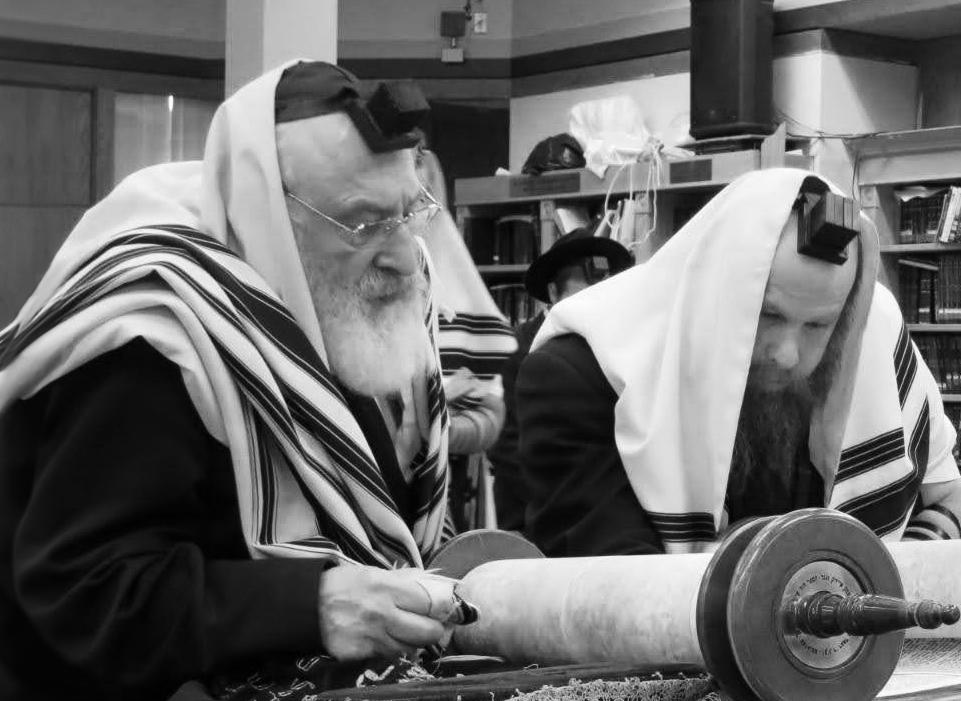
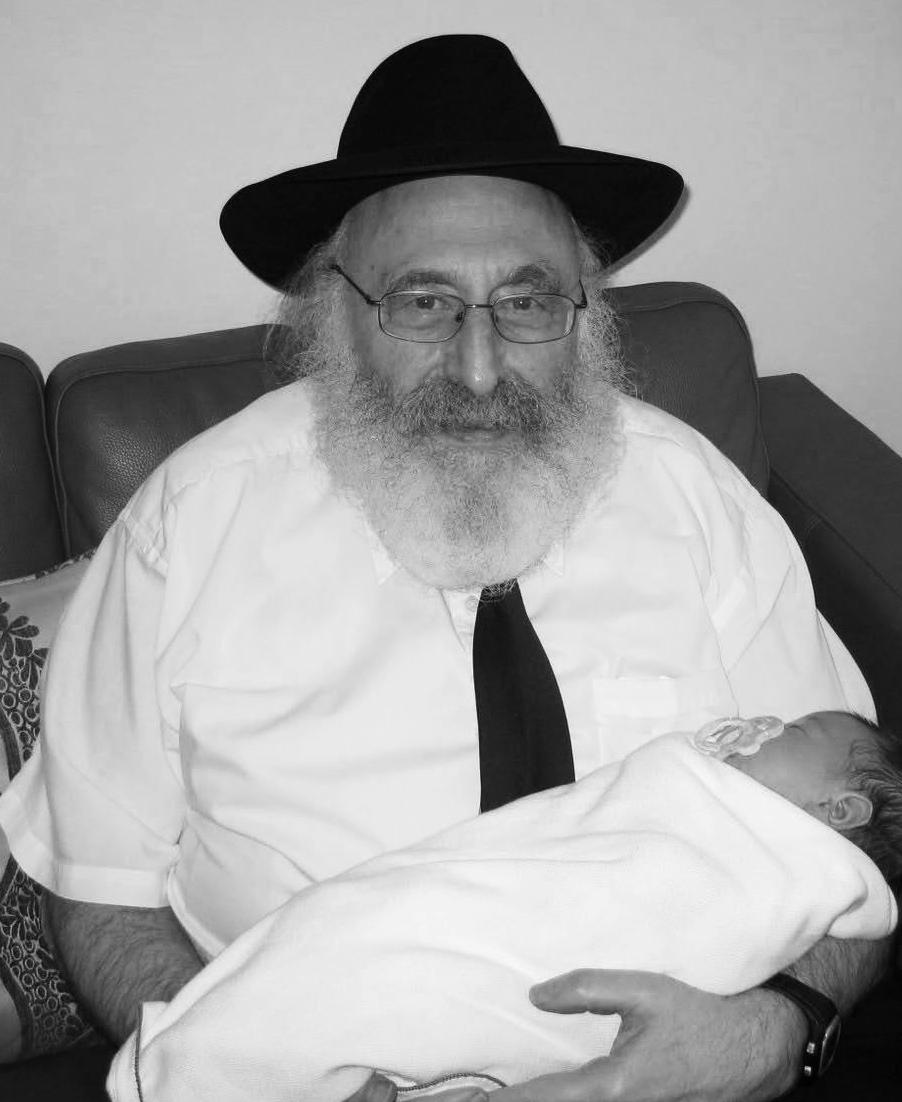

Rabbi Dovid Schochet’s Legacy
Remembering the humble giant of Toronto
By Tzemach Feller
Two months ago, hundreds gathered at 770 Chabad Gate, the central Anash shul in Greater Toronto, to honor Rabbi Dovid Schochet, who served as the rov of the Chabad community for over sixty years. His impact was profound: saving marriages, mentoring rabbis, and guiding countless individuals.
For six decades, he led with wisdom and humility, ensuring the continuity of Torah. Stories of his selflessness and erudition flooded the shiva and continue to surface, painting a portrait of a beloved leader and devoted family man who dedicated his life to helping others.
A Final Kindness
It was a dark and stormy night as the Schochet family headed down the New York State Thruway towards Crown Heights to be by the Rebbe for Sukkos. The fog moved in, and then the car broke down. Luckily, there was a brightly lit motel a short distance away. Soaked to the bone, they quickly checked in, grateful for shelter. Within a few minutes, everyone was

asleep except for Rabbi Schochet. Something compelled him to step outside into the chilly air. He was surprised to discover a military cemetery in the gloom behind the motel. He found one marker with a magen david on it at the end of the second row. He realized that Divine Providence had led him to this place so that he could daven for this poor Jewish soul.
A few years later, on yet another trip to New York, an unexpected snowstorm caused the Schochet
family car to break down once again. Upon checking in to the closest motel, Rabbi Schochet realized that they were strangely in the exact location where their car had broken down previously. He understood that this was no coincidence. An act of kindness was required, chessed shel emes. The rov contacted an attorney friend who could assist with the legalities. The only ones who could apply for disinterment are the nextof-kin, he was told. After several
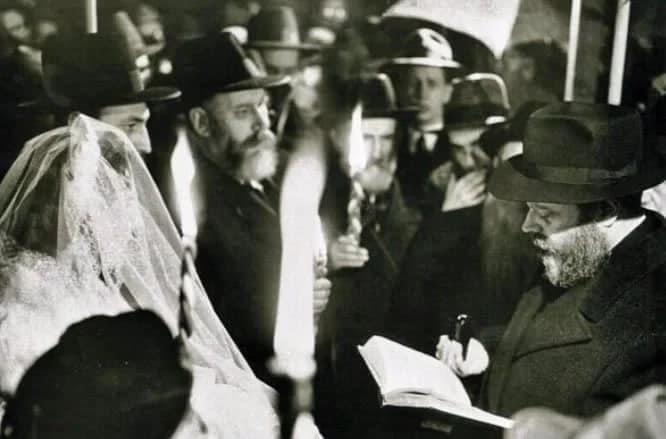
COLLIVE MAGAZINE ADAR II 5784 15
The Rebbe officiates at Rabbi Dovid and Betsheva Schochet's wedding in 1957

months, he found a great nephew. It turned out that the family had lost contact; they were unaware of where this man was buried, and they were happy to cooperate. An official request was submitted and quickly approved.
A few weeks later, the body was brought to a Jewish cemetery in Queens. As Rabbi Schochet and a few others supervised, a lost Jewish soul was welcomed home and finally laid to rest as a Jew.
An Urgent Intervention
A 19-year-old bochur from Toronto once approached the Rebbe with a list of questions he had. Ask Rabbi Schochet, the Rebbe advised—and the bochur did. He would regularly visit Rabbi Schochet and pour out his heart, seeking answers to
his heart’s deepest inquiries and finding them in the kind eyes and erudite intellect of the rov
But one morning, as he walked in, Rabbi Schochet burst past him at a sprint.
“Call 911,” he told the astonished young man. “I’m running.”
A woman in crisis had called the rov. She was struggling with depression and feeling hopeless. Her last call before attempting to take her own life was to the one person she trusted—the rov. And he succeeded in saving her.
Uncommon Wisdom
“Many are well versed in the four chalakim—the four sections of Shulchan Aruch. Rabbi Schochet was such a person,” said Rabbi Moshe Bogomilsky of Crown Heights, a member of the Vaad
Rabbonei Lubavitch, of which Rabbi Schochet was a senior member.
“But he was also blessed with the fifth chelek—the fifth section— common sense; understanding, feeling, and sympathy, which is crucial when making decisions and dealing with halachic issues.”
Justice and Fairness
An elderly frum woman once took her nephew, an attorney, to beis din over an inheritance she felt she deserved.
“Uncomfortable, I arrived at the Beit Din on the morning of the arbitration a few minutes after my aunt,” the nephew related to Mrs. Batya Lisker, Rabbi Schochet’s daughter. “It was your father who took the lead on the ruling. He afforded me the same respect as
16 COLLIVE MAGAZINE ADAR II 5784
Rabbi Dovid and Batsheva Schochet pose at their wedding with Rabbi Schochet's parents, siblings and other relatives in 1957
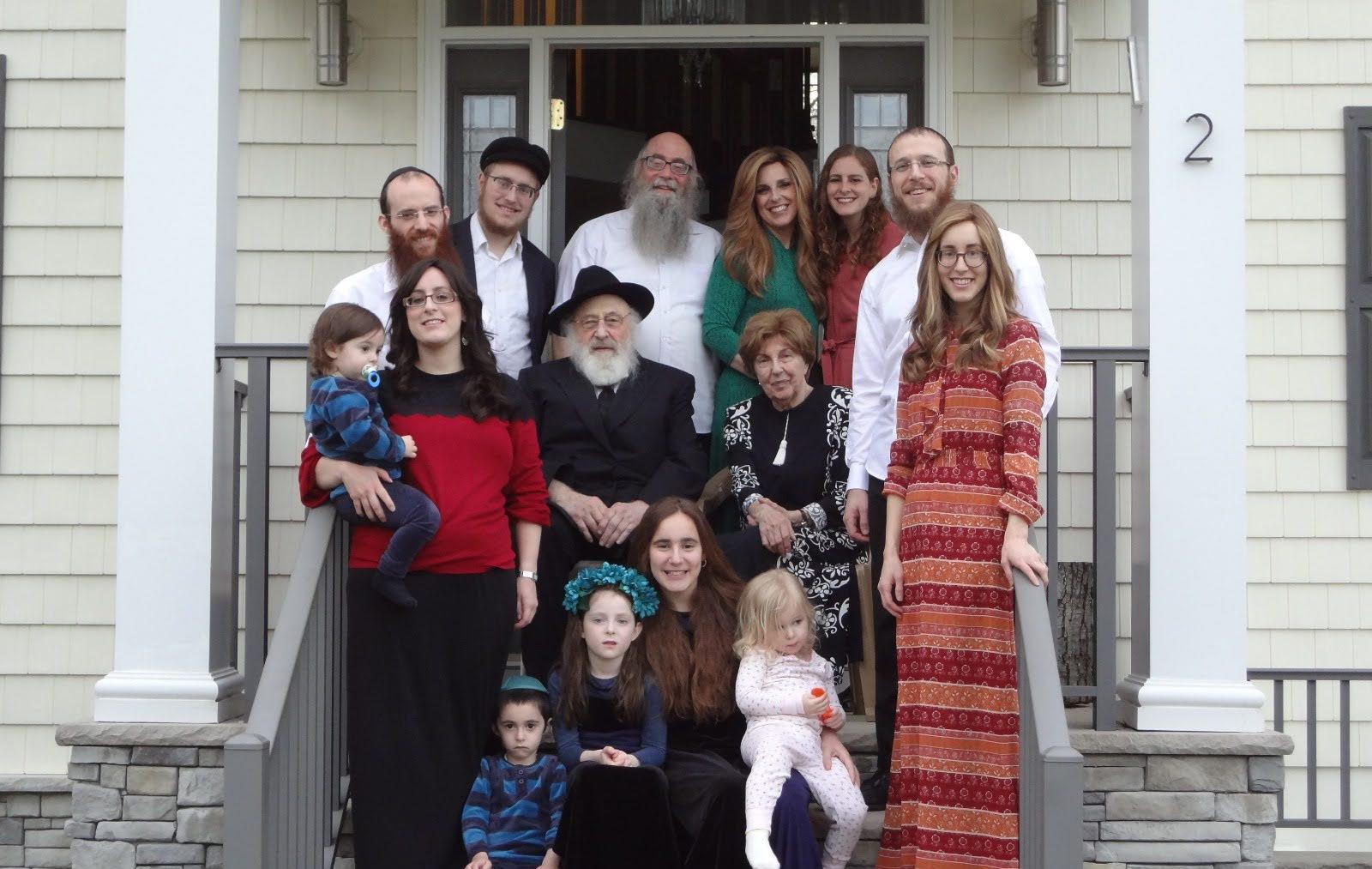
my very religious aunt. Relying strictly on the truth of the facts, he was not swayed by emotions. It was extremely reassuring to know that I got a fair shake. I was not judged by my appearance or level of religious observance. Your father upheld emes and ruled in my favor.”
“I thanked your father for his integrity and fair dealing,” he continued. “When I told him I wanted to make a large donation to Chabad out of gratitude, he adamantly refused. He took me off to the side and said there was absolutely no need for thanks since justice was served. Further, he explained that if I made a donation, it would look like a payoff, and therefore, it was completely inappropriate.”
“His obvious righteousness left me inspired and motivated to deepen my connection and progression in
Judaism that had started with your grandfather.”
Unplugging the Blockage
“It was 20 years ago,” related his daughter, Mrs. Batya Lisker. “I was teaching Gemara a few mornings a week to my son’s sixth-grade class, filling in a role for a teacher. Two weeks in, I sensed the students, for the most part, had a disconnect with the thought-provoking material, despite all of my efforts.”
“My father, Rabbi Dovid Schochet, had suggested different resources that I could use for my preparation. He was so proud that his daughter was a gemara teacher and was very interested in following my progress with the boys. I discussed my dilemma with my father. He was quiet for a minute and then stated
simply, ‘I wonder if they wash negel vasser.’ I protested, ‘Daddy, it can’t be. This is a school for boys from Torah-observant homes. They’ll be bar mitzvah next year!’”
“But the next morning, as the teacher exited the classroom and my 19 students respectfully stood to greet me, my father’s wise words echoed in my mind. ‘Good morning, boys,’ I said. ‘Please remain standing for a minute. Can I see a show of hands from those who have not yet washed negel vasser today?’ My heart sank, my stomach turned, as I watched 75 percent of the boys raise their hands. Without missing a beat, I smiled and nonchalantly continued, ‘Let’s line up at the sink and wash negel vasser before we start learning today.’”
“That night, I made sure to call my father. He was not surprised
COLLIVE MAGAZINE ADAR II 5784 17
Rabbi Dovid Schochet with his daughter and son-inlaw Chana and Rabbi Isser Weisberg and their children and grandchildren
at all by the events I related. He explained that when one does not wash negel vasser, it is as if the electrical plug is not plugged in. Therefore, despite all the efforts to turn on the light by flicking the switch in the most creative ways possible, there is a blockage to holiness.”
Divine Assistance
Rabbi Avrohom Plotkin, Director of Chabad-Lubavitch of Markham, Ontario, studied with Rabbi Schochet for an hour each morning. “The phone never stopped ringing, and he never missed a call,” Rabbi Plotkin related. “He would get a variety of shaylos—from the biggest rabbonim in the city and community leaders from around the world to a woman who had put the wrong spoon in her soup.”
“He engaged in each question and answered on the spot, always. ‘A rov has siyata dishmaya (help from Heaven),’ he’d say. Sometimes he’d doubt himself—had he answered correctly on the spot?—but we would look it up and he’d be right. ‘That’s the siyata dishmaya of a rov,’ he would say.”
Conversations of Torah
“Every conversation we had with him was based around Torah,” said his grandson Rabbi Dov Yehuda Diena, Menahel of Yeshivas Ner Yisroel of Toronto. “Whenever we visited, the first question was, ‘What are you learning?’
“Two weeks before he passed away, I went to visit him. At that point, he was delirious, half asleep. They had warned me that he wouldn’t be able to understand what I was saying and that I wouldn’t be able to communicate with him. I said to him, ‘Sabba, it’s

Dovi.’
“He turned his head towards me and he said, ‘vos lernstu’ — ‘What are you learning?’”
Hospital Lecture
“It was Thursday, Shiva Asar B’Tammuz - July 6, 2023. My father’s unfocused eyes fluttered open,” Mrs. Lisker related. “Still under the effects of anesthesia from the major surgery he had just undergone, he was understandably disoriented and did not recognize his surroundings. We were in room 1501, on the 15th floor at Memorial Sloan Kettering Hospital on Manhattan’s Upper West Side.
“The nurse entered the room a few seconds later to assess my father’s post-op recovery by estimating the residual effects of the anesthetic agent. After monitoring his vital signs and checking his pain level, she asked the classic question, ‘Rabbi, do you know where you are?’ Peering at his face and noting
his color, she waited patiently for his answer.
“In a hoarse, weak voice, my father whispered, ‘That is precisely the question that G-d asked Adam HaRishon, the first man, “Ayeka? Do you know where you are?” And that is G-d’s perpetual call to every human. Do you know where you are in the world? What have you accomplished? You have been allotted a certain number of days, hours, and minutes in which to fulfill your mission in life. What have you achieved?’
“The nurse was not impressed and certainly not amused. Efficient and professional with a no-nonsense style, she insisted on a proper answer and repeated her question, ‘Rabbi, do you know where you are?’”
“The narcotics that were administered had knocked out my father’s awareness. ‘Brazil, South America,’ he responded.”
“The nurse turned to us and stated,
18 COLLIVE MAGAZINE ADAR II 5784
Rabbi Dovid Schochet with his daughter Batya Lisker and grandson Doobie Lisker at Doobie's engagement to Mushka Groner in 2013
‘It is obvious that his cognitive function has not returned to normal yet.’”
“A family member challenged the nurse’s opinion. ‘Let me ask him a question!’”
“He then proceeded to ask my father a complex question that required proficiency in a few different areas of halacha. Without any hesitation, despite his dry mouth and sore throat, my father broke through his haze and summoned the energy to answer it instantly, correctly, and comprehensively.
“Not knowing where he was, why he was there, and unable to fathom the reason for the tears of relief coursing down our cheeks, my father knew precisely what the halacha was.”
Stories Never Shared
“He never spoke about the marriages he salvaged, the lives he saved, the calls he got from Rav Yosef Elyashiv’s Beis Din,” said Rabbi Isser Zalman Weissberg, a son-in-law of Rabbi Schochet. “But during the shiva, people kept sending me messages: your shver saved my community, your shver saved my marriage, your shver saved my life.”
Lasting Impact
Rabbi Moshe Mordechai Lowy, Rov of Agudas Yisroel Congregation in Toronto, sat on the city’s Beis Din alongside Rabbi Schochet. “All these years,” he said, “we never had a single dispute.”
“Toronto lost a person who carried the yoke of the city,” he said. “Besides being the rov of the Lubavitch community, he was the rov of the Toronto community. Rabbi Schochet lifted up every person— his duty, he felt, was to care for every person. He was a true gadol.”
As the shloshim ceremony concluded, the community lingered in the shul. Cousins reminisced about their sabba; shluchim spoke about their mentor. Soon, a minyan maariv began, the familiar refrain of Barchu sounding as it had thousands of times before. But this time, an empty chair sat on the stage in front of the room.
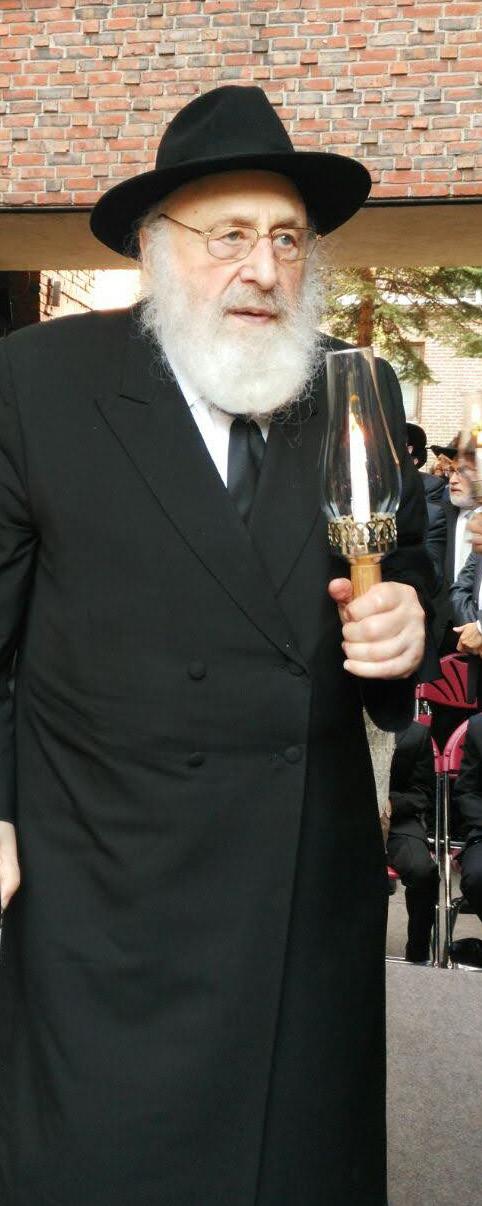
COLLIVE MAGAZINE ADAR II 5784 19
Rabbi Schochet stands at the chuppah during the wedding of his granddaughter Shira (nee Weisberg) and Sholly Bluming in 2017


K sher Entertainment
The inside story on how Toveedo, the number one online platform for Jewish kid’s media, came to be.
By Rivkah Katz
20 COLLIVE MAGAZINE ADAR II 5784
It’s a Friday afternoon and you are busy trying to prepare for Shabbos. Your little ones are home from school already and there is still so much to do. When play-time is exhausted and the weather turns rainy, you realize that you are fast running out of options for things to keep them busy. Sound familiar?
For some families, the happy ending to that story is having a subscription to Toveedo, the number one online platform for Jewish kids’ entertainment. With a vast array of options and hundreds of videos, Toveedo provides a steady stream of kosher entertainment to its thousands of loyal subscribers.
The visionary behind it is Chaim Hershkowitz, a father of five who was born and bred in Crown Heights. Apparently, he has always dabbled in entertainment. “As a kid I was always one to partake in different entertainment gigs,” he says in an interview. “I told stories in camp, was night activity director, and I never missed taking a role in the many plays and scavengers. I even had a radio show one winter, Jewish Kids Radio, with weekly entertainment.”
Though a go-to hero for parents and kids alike, Toveedo, as it is today, was not always Hershkowitz’s vision.
When Inspiration Strikes
In 2009, the Hershkowitz’s journey changed course when instead of embarking on shlichus as they had planned, the family ended up staying in Crown Heights. After settling his family in their redirected reality, Hershkowitz produced the famous Mitzvah Boulevard DVD.
“My son was walking around the house singing non-Jewish songs,”

Hershkowitz recalls. “He learned them from a kids’ entertainment Youtube classic that he watched.” Necessity being the mother of invention, Hershkowitz challenged himself to create Jewish content that would speak to his child. A puppet order and a creative dad were the solution to creating Jewish content for his child and the onset of the ever popular and career launching Mitzvah Boulevard DVDs, resulting in enthusiastic response from both parents and children.
While Hershkowitz’s talents were exercised as a side hustle, he felt drawn to maximize his skill and take his interest in Jewish media a step further. “I wanted to create something of my own, using my own talents and two hands.” This
propelled Hershkowitz to leave his position at Merkos 302 as the Moshiach Campaign creative director and more in pursuit of a startup of his own.
Fueled by the outpour of positive feedback from Mitzvah Boulevard One, Hershkowitz produced a second edition to the series. Video two was followed by a third, Wonders of Hashem, a video about Hashem’s creation gleaned from his son’s fascination with animals. “I tried to pinpoint the need, and that is what I sought to produce,” Hershkowitz explains. Looking to create variety and maintain his audience’s interest, Hershkowitz wanted to add a feminine storyline to the mix. One day, Hershkowitz bumped into Chanale Fellig, a music composer and performer,
COLLIVE MAGAZINE ADAR II 5784 21

who, at that time, lived around the corner. The meant-to-be encounter brought about the wonderful Bella Brocha series. These videos prompted Hershkowitz to venture into DVD sales, with the hope of generating sufficient income from residuals to sustain ongoing production. But as technology’s advancement accelerated, people were moving even deeper into cyberspace, and DVDs were phasing out.
Torah Treasure to Toveedo
In the DVD age, anticipation accompanied each DVD purchase, as parents whispered a silent prayer that the DVD served its value before cracking or getting too scratched up for use. “I’d say DVDs had a six month life span and then the waiting game began until a new DVD was on the market,” Hershkowitz jokes. “When we were kids, we watched the same Miami Boys Choir VHS on repeat and waited approximately two years
until the next one debuted. But things have changed.”
“I didn’t want all my hard work to go to waste just because DVDs weren’t making the cut. I just had to think of how to make my work relevant.” In 2017, Hershkowitz uploaded his DVD collection, which consisted of 7 installments, onto an online platform, which he named Torah Treasure. “This was the first Jewish media subscription model created, but slowly, people were catching on.” First offering a monthly subscription and then updating into an annual subscription for optimal use, Torah Treasure was taking off.
“While the words Torah Treasure encapsulated the media and goals of the platform, our site was constantly confused with Judaica stores carrying the same name.” The multiple Judaica inquiries and packages inadvertently sent to Torah Treasures media and the fact that unique, one-word titles were taking the stage as the key to compelling branding,
made Hershkowitz choose to rebrand. “If you think of popular platforms, websites, and forums, they are generally one word,” notes Hershkowitz. “Think Facebook, Spotify, Instagram. Such branding keeps companies sleek, impactful and memorable. I knew I had to rebrand, but my mind was blank.” As with the many twists and turns and random bouts of inspiration catapulting Toveedo, lived experience brought about the name that Jewish kids worldwide beg for. In fact, children’s slang sharpened the title.
“I was rocking my baby one night, and I was thinking of the message behind my brand. Essentially, we are sharing Torah through videos. Playing Babbleon in my head, I repeated the phrase in different variations.” Hershkowitz liked the message of Tov Video, capturing the ideas of tov, good, along with Torah and videos. “I was toying with the various mutations and combinations when I hit Tovideo.” When he saw that the domain was available but cost a pretty penny,
22 COLLIVE MAGAZINE ADAR II 5784
Filming "Shamiels Nigun" for The Rebbe's Niggunim
he asked his wife her opinion. “She was game for me to buy it, but encouraged me to get a bit more original and tweak the title for a cheaper domain.” So they kept probing for other ideas until Hershkowitz’s wife Nechama hit on the jackpot. “My kids, when they were toddlers, would call videos veeos. I think most kids do.” So, with a small tweak, it became Toveedo.
With Toveedo airing live, the opportunities for advancements of all kinds abounded. “What outsiders may not realize is that producing a DVD comes with limitations. For example, no one is going to buy one for $20 unless it is at least 30 minutes long. But in a subscription based platform, the options are much more vast.”
Behind the Scenes
Building something big demands utilizing resources effectively and being goal oriented, both strengths of the Toveedo operations. “I have a creative streak, and I enjoy the creative process immensely,” Hershkowitz acknowledges. “But my wife, co-founder of Toveedo, is the ‘get things done’ kind of person who keeps the wheels oiled.”
Hershkowitz recalls a conversation with music artist Shmuli Marcus as they hashed out a creative idea. “At the end of the call, I laughed. I’m full of ideas, and if you open your eyes and let curiosity lead the way, there are ideas to infinity and beyond. But, implementation is key. And for that, my wife and cofounder gets all the credit.”
In his early days, Hershkowitz single-handedly managed the content, voice recordings, and production of the Mitzvah Boulevard series, but since then

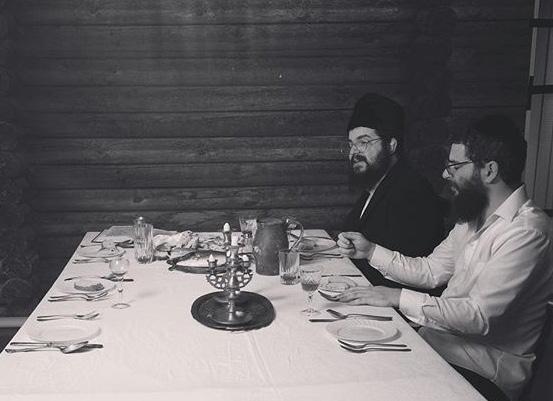
the company has since grown into a larger operation. “After the Mitzvah Boulevard series, I realized that I couldn’t be the singular voice behind the characters if I wanted each video to feel original and unique. Besides,” Hershkowitz reflects, “I didn’t have time to devote solely to recording audio.” Hershkowitz decided to enlist the help of writers, ensuring top-notch quality, while keeping scripts entertaining and compelling.
Hershkowitz allowed time to shape the growth and trajectory of his business. With the rapidly advancing digital age and the infamous Covid-19 pandemic, the primary kind of content people are looking for was brought to fore. “People want a constant flow of fresh and entertaining content.”
The media audiences almost prefer quantity over quality. “Obviously, it’s a fine balance to tread, but at Toveedo, our team has expanded
COLLIVE MAGAZINE ADAR II 5784 23
Filming "Asader L'sudosa" with Benny Freidman for The Rebbe’s Niggunim
Filming with a puppet for Mitzvah Boulevard

so we can deliver a steady stream of new, Jewish, quality content.”
The Toveedo team works round the clock creating new videos and content which they dubbed the “oven” stage. “It wasn’t always like this, but because the platform has built itself over time, we baruch Hashem have enough content uploaded that we have works in what we call the “oven” and readyto-go-content in the “warmer” to be debuted as needed.”
“We have a hardworking and amazing team. Raizel, Esther Rochel, Leeba, and my wife keep Toveedo running from our headquarters, and we collaborate with people all across the globe for ideas, scripts, and lyrics. But of course, to maintain Toveedo quality in both content and standard, my wife and I oversee each production.”
Staying in-the-know in this digital age is a job of its own as Hershkowitz works on developing content, implementing video creation, and bringing his vision to life. While some might feel overwhelmed with the myriads of updates and seas of new ideas, Hershkowitz, drawn by his curious
nature, gets a thrill from keeping his finger on the media pulse. “It’s like following the stock market. Your eyes and ears have to be focused.” Using the world as a framework, Hershkowitz and co transform popular classics into Jewish themed informational and entertaining media. “We look at the world, but then we level it up using our creativity, Jewish insights, and childhood media.”
Upward and Onward
Toveedo has come a long way, but Hershkowitz is not complacent. “For me this is just the beginning. This is ten percent of what I hope to get to.” When Hershkowitz says that, you can tell he means it. Perhaps one of his kind, Hershkowitz can’t remember a time where he experienced burnout. “I suffer from boredom, not burnout. I am always looking for the next thing and how to expand.”
In line with his vision, Chaim Hershkowitz is spearheading the development of a new subscription-based Chabad Kids’ exclusive website, tafkid. com. “Over the years, I received
numerous requests to feature Chabad-specific content on Toveedo, such as school plays,” he explains. With just one-third of our subscribers hailing from the Chabad community, Hershkowitz was inspired to create something tailored specifically for Chabad children, offering more Chabadspecific content and in greater variety. “The many requests encouraged our soon-to-be released tafkid.com.” The domain name, tafkid, brims with symbolism and intention. “Tafkid means purpose, and we aim to create an educational and warm hub for Chabad kids to enjoy.” The word taf, children, can be extracted from the word tafkid. “The dual meanings capture the vision of this website. We are catering to taf, children, who have a special tafkid, role, in bringing Moshiach.”
And there’s no doubt that this is one of the many avenues of Toveedos exploration. With the desire to impact, innovate, and educate, Toveedo’s name truly reflects what it does. It brings the goodness of Torah via Jewish media to children world wide.
24 COLLIVE MAGAZINE ADAR II 5784
Filming "Stav Ya Pitu" with Shlomo Simcha for The Rebbe’s Niggunim
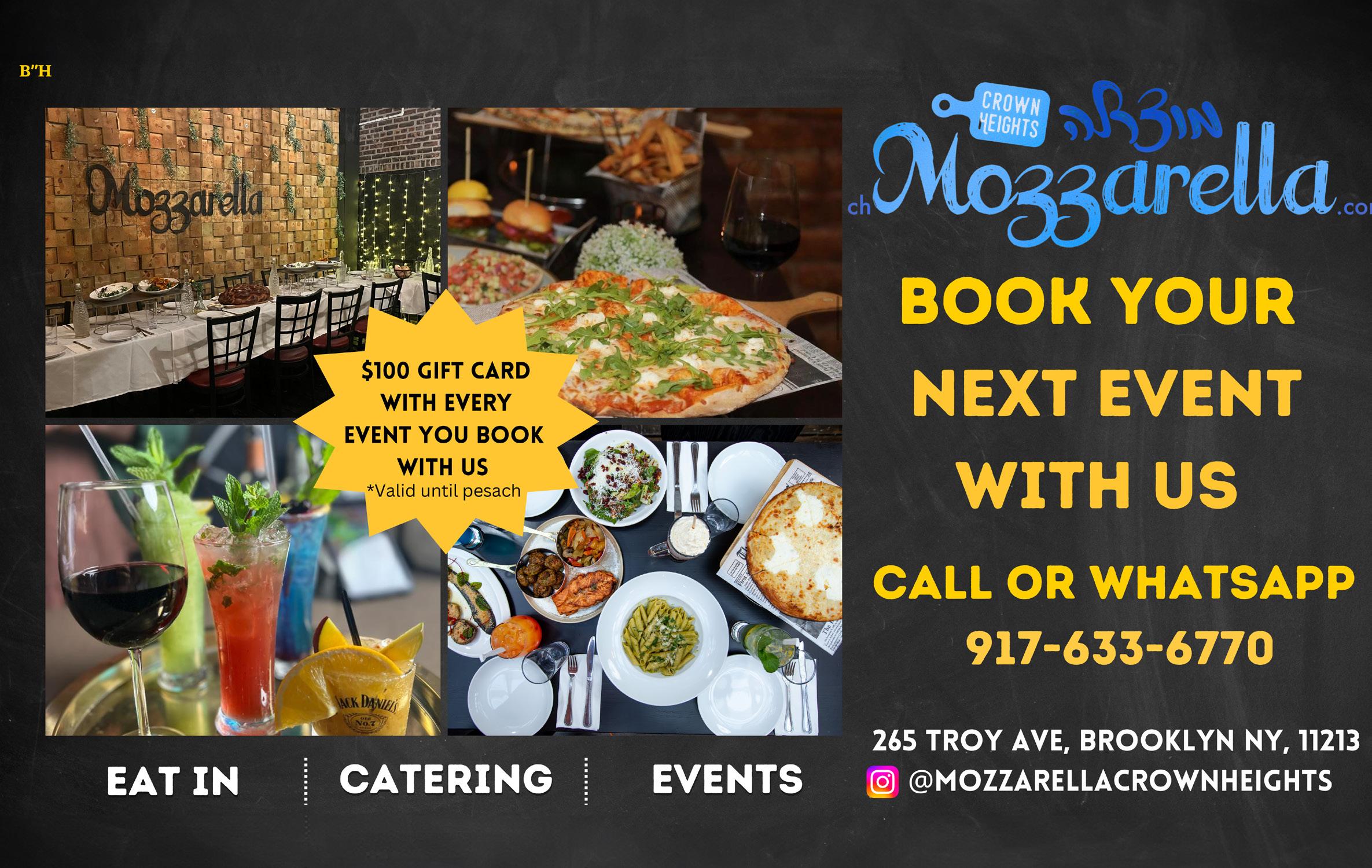







F R O M A S L O W A S $ 9 . 9 9 ! G E T Y O U R S H A L A C H M A N O S D E L I V E R E D
to their door! K E T T L E A N D C O R D . C O M / P A G E S / P U R I M F R E E S H I P P I N G T O A N Y W H E R E I N T H E U S ! EXPLORE OUR G R E AT SELECTION Email purim@kettleandcord.com for bulk or corporate orders
right

A DANGEROUS FARBRENGEN *
The story of a fearless Chassidic gathering in Moscow 1927
 By Dovid Zaklikowski
By Dovid Zaklikowski
Albert Lvovich Fuchs and Lirov Litvakov met on a winter day in 1927. The two members of the Moscow Jewish elite had shared interests in literature, politics and culture. Fuchs was a well-known Moscow lawyer who handled high-stakes cases, such as for the American and British embassies. Litvakov was the editor of the socialist Yiddish newspaper Emes. It was after the revolutionary groups overthrew the Czarist Empires that a tumultuous decade of civil war commenced. In 1923, the Bolsheviks seized complete control of the Russian Empire, calling themselves the Communist Party, and set about the establishment of a Socialist state.
Jewish life was among the first casualties of this “great experiment.” The Yevsektsiya, a group of Jewish socialists, primarily members of what was formally known as the Bund, despised Jewish religious practice. They raged a campaign in the Yiddish press, including their Emes newspaper, and harassed, and found every way to persecute religious Jews. However, practicing Jewish religion is not outlawed. “Rebbe Schneersohn organizes and supports rabbis,” Litvakov told Fuchs in disgust, “shochtim, roshei yeshivahs and teachers.” He said that it is not only in White Russia but across the entire Soviet Union. Even in the far corners of Georgia and Turkestan, he said, “You could find his representatives and those who follow Rebbe Schneersohn’s instructions to support religious organizations.”
He told of one person who traveled from city to city preaching that religion was permissible according to Soviet law. “His appearance and speeches had a lasting effect,”

Litvakov continued, “and it brought a renewed religious enthusiasm.”
Fuchs could not understand what the fuss was all about, telling him that the law permits practicing religion, and that they could support religious institutions. “What did Rebbe Schneersohn wrong with his broadcasting the law of the land?”
The editor angrily told Fuchs that they had informed the Joint State Political Directorate (OGPU), the Soviet intelligence and security forces, “About the sins of Rebbe Schneersohn that they have
gathered. We decided to totally uproot his activities.”
A ‘STRONG‘ INHERITANCE
Fuchs had been called two weeks earlier, in early February 1927, to a meeting at the Moscow offices of the OGPU secret police agency (later merged into the NKVD). In addition to being a lawyer, Fuchs was also a member of the leadership of the Moscow Jewish community. He was a regular at the Soviet police office, but usually, it
COLLIVE MAGAZINE ADAR II 5784 27

was just procedural, seemingly to instill fear against him for furthering Jewish religious causes. But now it was about what the Rebbe Rayatz was doing in Moscow.
Fuchs told them that surely the Rebbe Rayatz had done nothing against the law, “but I have no clue what he is doing in the city.” He quickly arranged a secret meeting with one of the Rebbe’s aides and suggested that they immediately leave Moscow. The Rebbe Rayarz didn’t want to hear anything of it. “As if the OGPU does not have ways to follow me and spy on my doings in the farthest corners of the country,” he said.
A few days later, on Thursday night, Fuchs was surprised to see that the Lubavitch shul was packed and lit with many candles. “There were so many people that you could not get
in,” he later recalled. He stood outside looking in and asked someone what was going on. They told him that the Lubavitcher Rebbe was giving a talk because that night was Purim Katan, and afterward, there would be a festive meal.
Fuchs was shocked, “My body began to shake,” he said. Remembering the Rebbe Rashab, he thought: “This man inherited the strong will of his elderly father who placed his life in danger for the good of the Jewish people during the last regime.”
The lawyer, and his friend, now made an effort to enter into the shul and pushed their way in and listened to what the Rebbe Rayatz was saying. “Besides for what he was saying,” Fuchs said, “the Rebbe Rayatz’s passion was palpable. He disregarded the
challenges and danger that was becoming after such a talk. And watching the Rebbe and crowd intently listening made a great impression on me.” With that, something caught his eye, causing him to immediately leave and miss the rest of the proceedings.
ON tHE WATCH LIST
While the Yevsektsiya could not stop the Rebbe Rayatz from bolstering religion, the yeshivahs he was supporting were scandalous. The Communists passed a law separating Church and school, and all religious schools were shuttered, including Jewish ones. They wanted to replace theology with socialist ideas, and uprooting religious education was a good start.
28 COLLIVE MAGAZINE ADAR II 5784
Moscow, 1927
“Religious studies are in a sad condition in the U.S.S.R.,” read a mid-1920s report by the board of rabbis of the Soviet Union, under the direction of Rebbe Rayatz. “The legislation forbids teaching religion to little folk [children] and the embarrassing economic situation does not allow for the possibility of supporting these studies.”
But the Rebbe Rayatz circumvented them and made every effort to raise funds from abroad that ultimately allowed his underground network of schools to continue. This especially evoked the fury of the Yevsektsiya, and the Rebbe Rayatz was placed at the top of their list of “enemies of the people.”
In 1924, the local branch of the Yevsektsiya began to terrorize the Rebbe Rayatz at his home in Rostov-on-Don. While they were not an official organ of the government and had little Jewish support, these few Jews worked to uproot any clandestine Jewish schools by pressuring and reporting to government officials.
Through the efforts of Rebbe’s admirers and acquaintances, the local municipality agreed not to arrest him on condition that the Rebbe Rayatz leave the city. Thus, the Lubavitch court moved to Leningrad (now S. Petersburg), where the Rebbe Rayatz continued his work to bolster education.
The month of Adar 1927 was an especially difficult one. Lubavitchers were being arrested, including one of the Rebbe Rayatz’s personal aides. Some were in jail for a short period. Others were given forced labor, and some no one knew their fate.
It was a difficult time for the Rebbe Rayatz, and on the of Purim Katan in Moscow, he wrote in his diary, “I felt very tired, and I almost could not leave my bed. After resting another
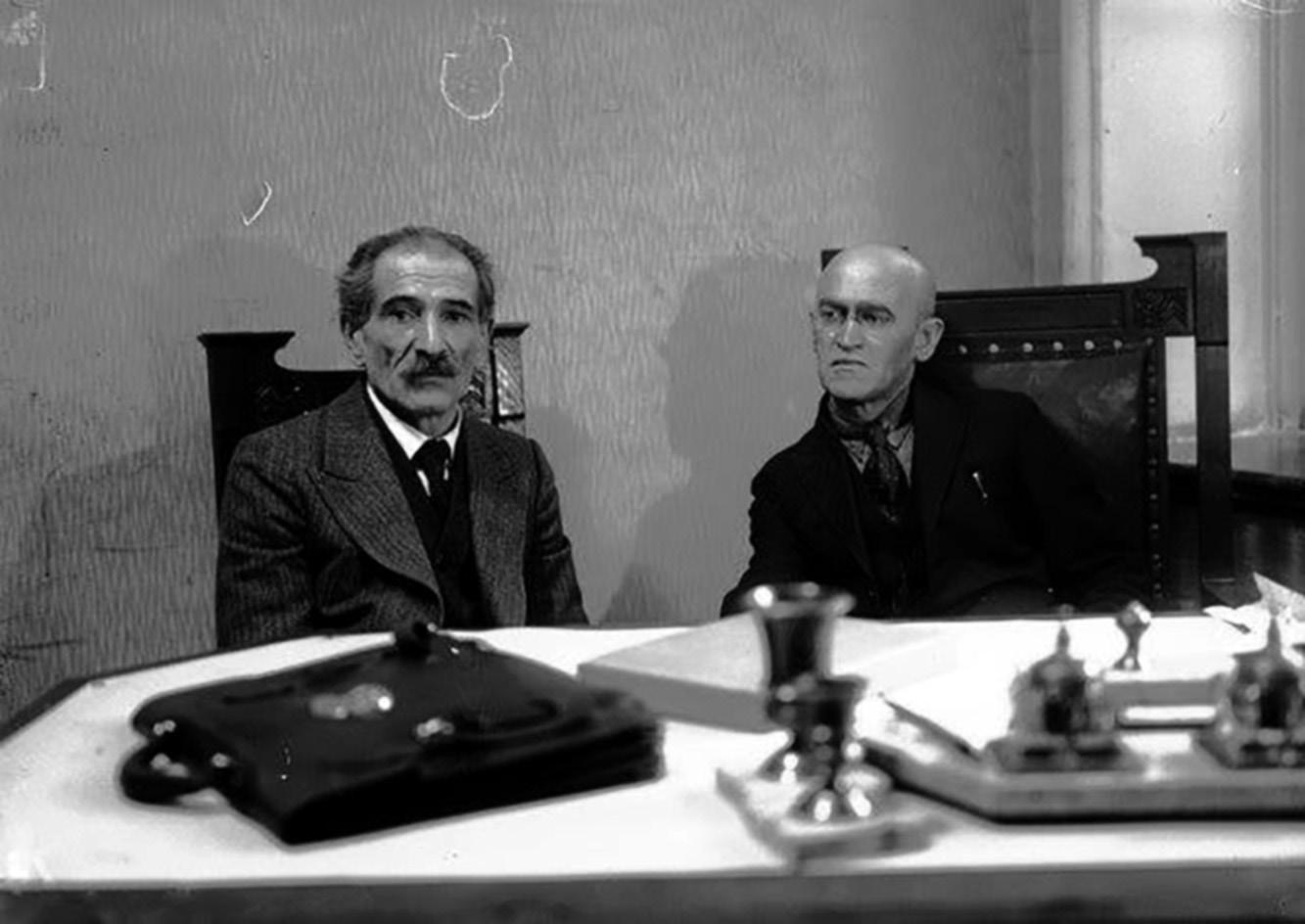

hour, I got up.” He learned that officials had already come to search the place he was staying at. It was just another warning that danger was imminent. Despite this, when Rabbi Yaakov Landau, the director of the local Tiferes Bachurim and later the chief rabbi of Bnei Brak, asked that the Rebbe Rayatz come farbreng with his group of thirty students, he agreed.
“I found it a good idea to fulfill their request” to talk to the group of
young men who worked or studied at the university during the day and took the time to study Torah afterward, the Rebbe Rayatz wrote.
At the Lubavitch shul, Fuchs reported, the Rebbe said that the miracle of Purim came about because the Jews withstood the test of assimilation. They were saved, the Rebbe said, because when it was prohibited to study Torah, the children said that they were with Mordechai and they
COLLIVE MAGAZINE ADAR II 5784 29
A group of students of the clandestine Lubavitch yeshivah in Berdichev
Lirov Litvakov (right), editor in chief editor of Yevsektsiya’s Emes newspaper, 1929, with another writer of the Yiddish paper
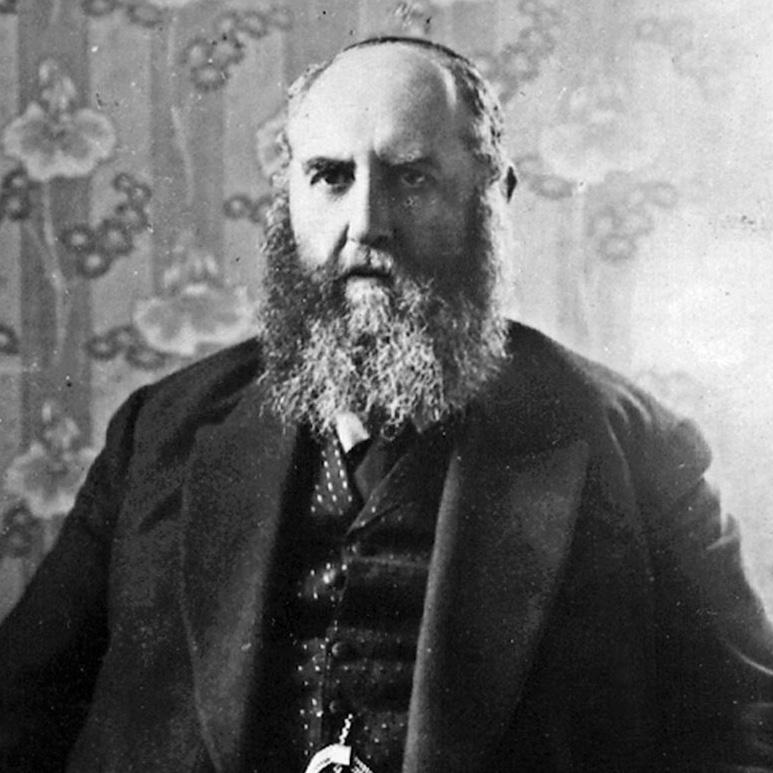
would continue. “The spiritual battle is everlasting, and in every generation through children studying Torah, the enemy is defeated,” the Rebbe said.
Canvasing the room, Fuchs soon noticed members of the Yevsektsiya in attendance, and he knew that he had to leave. But while he felt imminent danger, the Rebbe Rayatz did not stop. People believe that the government created the Yevsektsiya, the Rebbe Rayatz said, or that they are an organ of the regime. It is not the case, he told the gathered. They are just “a group of Jew-haters,” he fearlessly declared.
The Rebbe Rayatz said the Yevsektsiya were liars and merciless swindlers and, “Without a doubt, one day they will be disgraced when their thefts and embezzlement will be revealed.” Each of them will turn on the other
to reveal the truth, the Rebbe Rayatz continued, and they will bring each other down from their pedestal. “But until then, they can, G-d forbid, destroy the religious fabric of the country.”
The Rebbe said that all the gathered needed to join together and proclaim to the Russian Jewish community the truth about Soviet law and the Yevsektsiya. That talk led even more ferocious OGPU surveillance and visits to the Rebbe at his residence in Leningrad. But it did not deter the Rebbe or his Chassidim. Fuchs later recalled that the conversation as they were leaving the shul on that Purim Katan night was that surely the chassidim will take every word seriously.
The friend who was with him told Fuchs, “The talk will have a great effect. As chassidim do, they will repeat its words, discuss its ideas
and dissect every word the Rebbe said. Then they will write it down and publicize it to even more people.”
It is said that the Purim Katan talk was the catalyst for the Rebbe Rayatz’s arrest and death penalty a few months later (ultimately to be nullified under international pressure). But it never deterred the chassidim. In a 1984 audience, his successor, the Rebbe, said that chassidim should recall and restudy the discourse from that day every leap year.
The Rebbe said that when they arrested the Rebbe Rayatz in the first interrogation, they recalled the talk from Purim Katan. “Then you needed to have self-sacrifice. Today, we do not need to have actual self-sacrifice. We are living in a time when one can freely observe Judaism, in all of its hidur.” This is surely the case when it comes to giving children a Jewish education. In life, when there are challenges from the outside, the Rebbe said—invoking what the Rebbe Rayatz said then about the fallacy of the Yevsektsiya—they should be ignored. When you do, “You can see that they are not as powerful as they claim to be.”
Dovid Zaklikowski is an acclaimed researcher and journalist, and the author of over 20 books. Born and bred in Crown Heights, he began his writing career at the age of 16 and since then he has written thousands of articles, with a focus on Jewish history.
His books are available on hasidicarchives.com
Sources: Sefer Hasichos 5727, p. 154; Hatomim, vo. 2, p. 672 and 712; Igros Kodesh Harayatz, vol. 1, p. 431; Toldos Chabad Berusya Hasoveyetis, p. 99; Jews and Jewish Life in Russia and the Soviet Union. With appreciation to Rabbis Aaron Raskin, Nison Ruppo and Sholem Kubitshek, for all of their assistance.
30 COLLIVE MAGAZINE ADAR II 5784



Mordechai Bendon has been enjoying whisky for a long time. So it was only natural that, sometime in the 1990s, he and his family visited the Cardhu distillery in the Speyside region of Scotland. As they toured the distillery, a delivery took place, altering the trajectory of Bendon’s life.
“A large lorry drew up filled with fresh sherry casks, straight from Spain,” Bendon recalled. “And when they opened the back doors, the smell of that wine was simply overpowering.”
As distillery workers unloaded the casks, Bendon followed the carts into the warehouse and began asking questions. What he heard profoundly transformed his understanding of the kashrus of the drink he so enjoyed.
“I had always assumed that all whisky is kosher and that the issues of stam yeinam—nonkosher wine—were sorted out 100 years ago,” Bendon said. “When I was in that warehouse and witnessed the overpowering and dominant smells of those sherry casks, I started asking what influence this had on the bottled whisky.
“The workers all said to me, ‘Do you think we would spend so much money to custom-order a sherry cask from Spain if it didn’t have a dominant flavor influence upon the whisky?’”
From that moment on, Bendon took upon himself the mission to inform and educate the kosherkeeping public about the kashrus concerns that exist in whisky, particularly single-malt scotch whisky. Together with his wife of 31 years, they have visited more than 70 of the 140 or so distilleries that dot Scotland, traveling to every region and every island where whisky is produced.

But why, indeed, did it take until the 90s for the alarm bells to ring about non-kosher sherry in scotch whisky?
How scotch whisky is made
To understand the kashrus concern, it is necessary to review how scotch whisky is produced, as explained by Bendon, who is considered a world-renowned expert in the field today and shares his findings on his blog (rebmordechaireviews.blogspot. com).
For scotch whisky to be worthy of the title, the drink must be made from malted barley and distilled in pot stills. The resulting whisky, called new make spirit, must be aged in oak casks for at least three years in Scotland. But there’s a problem with aging whisky in oak casks. Virgin oak has sharp tannins, which impart an undesirable bitter flavor to the whisky. So Scotland’s distilleries have always wanted to age their spirits in used casks—historically from American bourbon distilleries and Spanish sherry wineries, or
bodegas.
Bourbon must be made from new oak barrels, charred over an open flame to remove the tannins. Since bourbon barrels can only be used once, there is a glut of used barrels, which are sold to Scotland’s distilleries cheaply—about $100 each. The other source of used casks was a byproduct of Britain’s once-strong interest in sherry—a family of wines produced in the Sherry Triangle in the Province of Cadiz in southwestern Spain. Until about 50 years ago, sherry was made in Spain and shipped to Britain in cheap European oak transport casks to be bottled, labeled, and exported. These transport casks were first seasoned for a few months with cheap young sherry and then filled with expensive drinking sherry. Once emptied into bottles, the casks had little use, so the distilleries purchased them cheaply to use for whisky.
While technically wine casks, these casks held wine for months, not years, and were used and reused by the distilleries—as many as five or six times—to mature whisky.
COLLIVE MAGAZINE ADAR II 5784 33
A cask is charred at the Golani Distillery in Israel.

The distilleries had relatively little interest in the flavor the wine could impart. Instead, the advantage of these used casks was the lack of bitter tannins.
Around the 1970s and 1980s, more and more people became interested in single malts rather than the previously popular blends, and the distilleries began bottling and selling their own whiskies in larger and larger quantities.
Spanish Decree
But then a crisis struck.
In 1986, the Spanish government decided to take the sherry industry back into their own hands and they made a law that Spanish sherry had to be bottled in Spain; casks would no longer be allowed to be exported. Overnight, the scotch whisky industry lost a huge percentage of the casks it was using to mature whisky—these cheap sherry transport casks.
Many of the distilleries using sherry transport casks substituted them with bourbon casks. But customers began to complain that their scotch didn’t taste the same—something was missing. The substitution
of bourbon for sherry casks was readily apparent, so the distilleries embarked on several experimental projects.
One was to take old sherry casks and, under high pressure, inject them with a concentrated wine product called Paxarette, created from concentrated, boiled sherry. This practice was soon banned in 1992.
Now, the distilleries had no choice but to go directly to the sherry wineries in Spain and custom-order sherry casks for the scotch industry, and so began a brand-new industry in Spain.
Today, the overwhelming majority of sherry casks produced in Spain—80% or more—are made exclusively to be shipped, empty, to Scotland in order to mature scotch whisky.
“You can understand that the situation on the ground has dramatically changed within the last 40-50 years,” Bendon concluded. “Today, there are no more cheap Spanish bodega transport casks that only held sherry for a few months. Today, we have customordered high-quality sherry casks.
Companies will have their own sherry cask manager constantly going to Spain to check their stock.”
The sherry casks of today are not just a way to get rid of tannins, Bendon explains. They bring a richness of flavor to their journey from the vineyards of Spain to the Scottish moor.
The type of wine, type of oak, and size are selected, and the barrels are seasoned with cheap sherry for 6-24 months.
“Now comes the interesting bit,” Bendon continues.
By law, in Spain, you can only export empty sherry casks. But there’s a gray area in what is called “empty.” The seasoning sherry is poured out and the barrels are sent back to the cooperages in Spain for quality control. Then they are sent back to the sherry bodega, where the casks are refilled with 5-20 liters of highquality sherry—said to stop the cask from drying out during the transport from Spain to Scotland.
Bendon posits, however, that this is absolute nonsense.
Primarily, they’re putting this highquality sherry into the casks to keep and maximize the sherry flavor. The sherry casks arrive at the distillery in Scotland, and to get the maximum flavor transfer, they are usually filled within a few days or weeks.
When they add the new make spirit into the cask, there are remnants of the sherry still in the cask—and that’s in addition to the 20-60 liters of sherry impregnated into the wood.
Yes, they’re not allowed to pour wine into the cask, but the regulators turn a blind eye to these liters of sherry conveniently kept in the casks by many distilleries.
“I have personally witnessed this,” Bendon said. “On top of that, I have interviewed distillery managers and warehouse managers and asked
34 COLLIVE MAGAZINE ADAR II 5784
Pot stills at the Golani Distillery in Israel.
them directly: ‘Do you pour out the sherry?’ They say, ‘Are you crazy? We haven’t spent all that money on these very expensive casks just to pour it out!’”
Wine Casks in Halacha
In truth, the reuse of wine vessels (klei yayin) for other beverages did not begin with the creators of scotch whisky. For millennia, jars, barrels and casks have been used and reused. This posed a potential problem for the kosher consumer: if you bought a cask of beer, for example, would it be rendered nonkosher if that cask had once stored stam yeinam—non-kosher wine?
Rabbi Sholom Ber Hendel, the Executive Rabbinic Coordinator of OK Kosher and member of the Executive Vaad HaKashrus, explained that the permissibility of scotch whisky today is different than it was even several generations ago.
The 1957 ruling of the Minchas Yitzchok (1902-1989) was accepted as the mainstream approach to sherry casks. He permitted the whisky for two reasons: Firstly, he wrote, there’s certainly six times (a number applicable to wine), and maybe even 60 times, as much kosher liquid as there is wood that absorbed the non-kosher wine. Secondly, he writes, the flavor of the wine is not tasted in the whisky; it’s a new flavor that is a combination of the wood, the wine, the air, and the grain, and therefore it can be considered zeh vzeh gorem—the kosher and the nonkosher flavors combine to create a taste; the wine is not generating the flavor on its own. If you can identify the taste imparted by the wine, then the wine—however little of it there might be—is considered a milsa d’avida letaima—something whose purpose is to add flavor, and

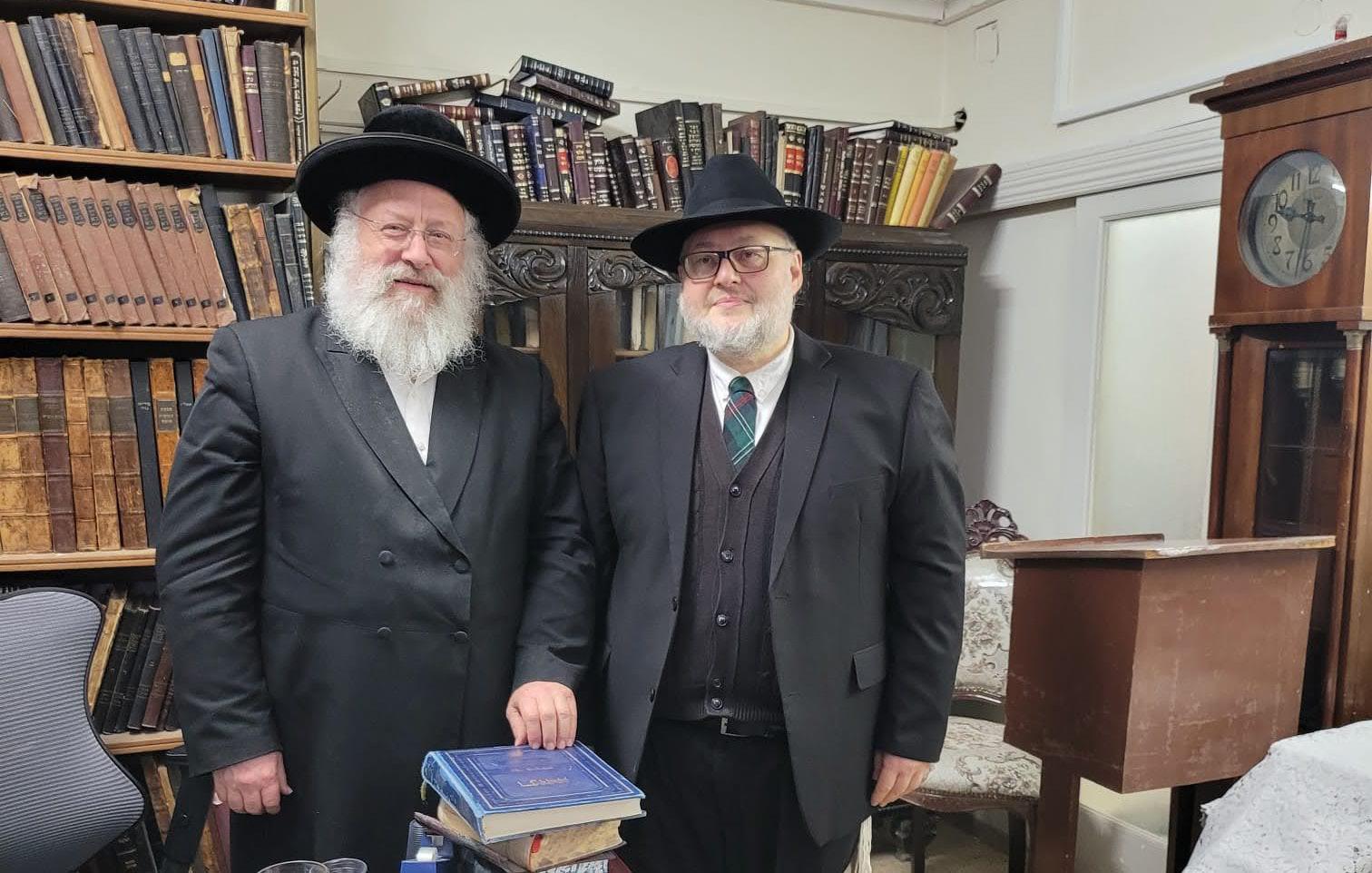
it would never be batul, even in 60 times as much kosher liquid.
In recent years, however, there have been questions about the ruling of the Minchas Yitzchok and whether he was provided with an accurate picture of whisky production and aging methods. Understanding the history of whisky production can put these questions to rest.
In the time of the Minchas Yitzchok, almost all scotch whisky available was blended scotch whisky. Single malt scotch, which is highly sought after today, was not available during that time. Even if some of the whisky in a
blend was aged in sherry casks, it would be a very low percentage of the blend and there is almost always more than 60 times as much kosher liquid as the small percentage of sherry in the small percentage of sherry-aged whisky in the blend.
In comparison, single malt scotch would typically have a much higher percentage of scotch aged in sherry casks. It is not a ratio of 60:1 kosher to non-kosher, and it might not even be a ratio of 6:1. The casks are thick, and the average volume of wood for a 500-liter cask is 136 liters. The whisky is typically diluted upon maturation
COLLIVE MAGAZINE ADAR II 5784 35
Rabbi Sholom Ber Hendel at a distillery in Scotland
Reb Mordechai Bendon with HaRav Chaim Yitzchak Aizik Landa, rav of Bnei Brak
with an additional 250 liters of water to reach 40% alcohol, but even 750 total liters is not six times greater than the volume of the wood. Single malt scotch is often matured in smaller casks, such as hogsheads and quarter casks, and those have an even higher ratio of wood to liquid.
The manufacturers of single malt scotch aged in sherry casks specifically tout the benefits imparted to the whisky from the sherry and are clearly looking for the sherry flavor. Therefore, it is very clear that both aspects of the Minchas Yitzchok’s ruling still apply to blended whisky but not to single malt scotch aged in sherry casks.
So what should we do?
“The recommendation of OK Kosher is to always buy koshercertified whisky; this way, you know that you have no kashrus issue,” Rabbi Hendel said. “When that’s not an option, don’t use whisky where nirgash taam hayayin—the flavor of the wine is recognizable.
“Practically, one should avoid whisky when the label mentions sherry, port, oloroso, madeira, or any words that represent aging in wine casks such as, double matured, finished, European oak— all of those things may denote the use of wine casks. The company is advertising and charging a premium for these features. If those phrases are not mentioned, the assumption is that it does not contain whisky matured in wine casks in a great enough quantity for concern.
Even though it is not the norm, blended whisky may contain a large amount of whisky matured in sherry casks, so the label should be checked, just as one would do for single malt scotch.
Finally, Rabbi Hendel has another
recommendation, one shared by Bendon: try one of the number of excellent kosher-certified wineaged whiskies that are made using strictly kosher ex-wine casks.
Kosher
Alternatives
The kosher consumer who wishes to enjoy wine-aged whisky has a variety of options today. Kosher Spanish sherry casks are being produced, and kosher wine casks are being used to age whisky in Scotland.
David Zibell is one producer of kosher, wine-aged whisky. He was born in France and grew up in Montreal, Canada, where he learned in Yeshivas Tomchei Temimim Lubavitch.
“As a young man, I became passionate about whisky and decided to go out on a venture and make my own when I moved to Israel 10 years ago,” he said.
In 2016, he released Israel’s
first-ever whisky. Today, Zibell has two distilleries: Yerushalmi, in Jerusalem, which produces peated single malt whisky; and Golani, in the Golan Heights, which produces single malt and single grain whiskies. The spirits are available for shipping to the US at golanispirit.com.
“All of our barrels are sourced from wineries or distilleries in Israel, using red wine, white wine, and dessert barrels,” Zibell said. “It’s all kosher wine, and we are using all types of wine and beer barrels to age our whisky.” And the whisky is certified kosher by the OK.
In tribute to the heroes of October 7, Zibell recently released “Golani Chai,” a single cask, single malt whisky matured in Ex-Shani Portstyle wine casks. Each label tells the story of one of the heroes of October 7, and for every bottle you purchase, Zibell donates one to an injured soldier, pairing strict kashrus, tzedakah, and excellent flavor in every dram.


36 COLLIVE MAGAZINE ADAR II 5784
A wine-cask aged kosher whisky made by the Golani Distillery in Israel.

779 East New York Ave | 718.260.4670 • Pediatric & Adult Medicine • Podiatry • Brand New Facility • State-of-the-art Equipment • Open 8a.m. - 8p.m. Care made personal. We merged ER Medical and Crown Medical into an empire of healthcare:
Designing a Tznius Brand
A behind the scenes conversation with three fashion designers
By Danit Schusterman

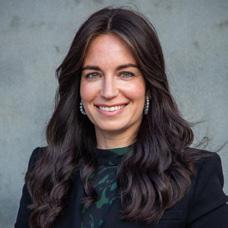


Sarah Feldman of Sarah Feldman Clothing
Chanchy Schmukler of Damigella
Sarah Haller of Solika
Tznius fashion is a growing industry, with many new brands opening in the last few years. And behind each brand, there is a person and a story. We held a panel discussion with three entrepreneurs about their work process, challenges, and advice they have for others.
What inspired you to start your own fashion line?
Feldman: People frequently asked me to be their personal shopper because women needed help trying to dress tznius. It opened my eyes to the reality that many women want to look good but struggle with the lack of tznius options. With this realization and Hashem’s guidance, I launched my brand.
Schmukler: I had designed a beautiful gown for my sister’s wedding, and after the wedding, I received multiple requests from women asking to rent it from me. I rented it out several times to women around the world, from Israel to Europe and throughout the U.S. This prompted my husband to suggest that I create a line of gowns to rent out, which I did. I named it Damigella, which is Italian for Bridesmaid. Eventually, it evolved into a full-blown clothing brand.
Haller: I grew up with my friend and business partner Chaya Israeli in Los Angeles, and we always bonded over fashion. In 2013, we came up with the idea to build a clothing brand that would fill the gap in modest clothing. It inspired us to start and continues to be our guiding light today.
Starting a new business couldn’t have been easy. Can you describe some challenges you faced and how you got past them?
Feldman: Starting my own fashion business with no formal education
in fashion was an extremely risky endeavor. I only succeeded thanks to the people I met along the way who guided me through every step of the journey.
Schmukler: Beginnings are always hard and require a lot of perseverance and hard work. Something that helped me overcome those difficult moments was people’s honest feedback. Whenever I felt beaten and ready to give up, I’d get a message saying, “Thank you for creating such beautiful pieces” or “You’ve helped me appreciate the mitzvah of being tznius.” Also, the excitement and pride in my daughter’s eyes
whenever she speaks about “my mommy’s store” is priceless and something that keeps me going.
Haller: There were some tough decisions that we made along the way, which really made us question our judgment and business direction. As our business began to grow, we moved our manufacturing from overseas to here in Los Angeles, which brought along a host of unforeseen challenges. Additionally, right before Covid struck, we transitioned our business from wholesale to directto-consumer. Market fluctuations and consumer preferences seriously upended how things had
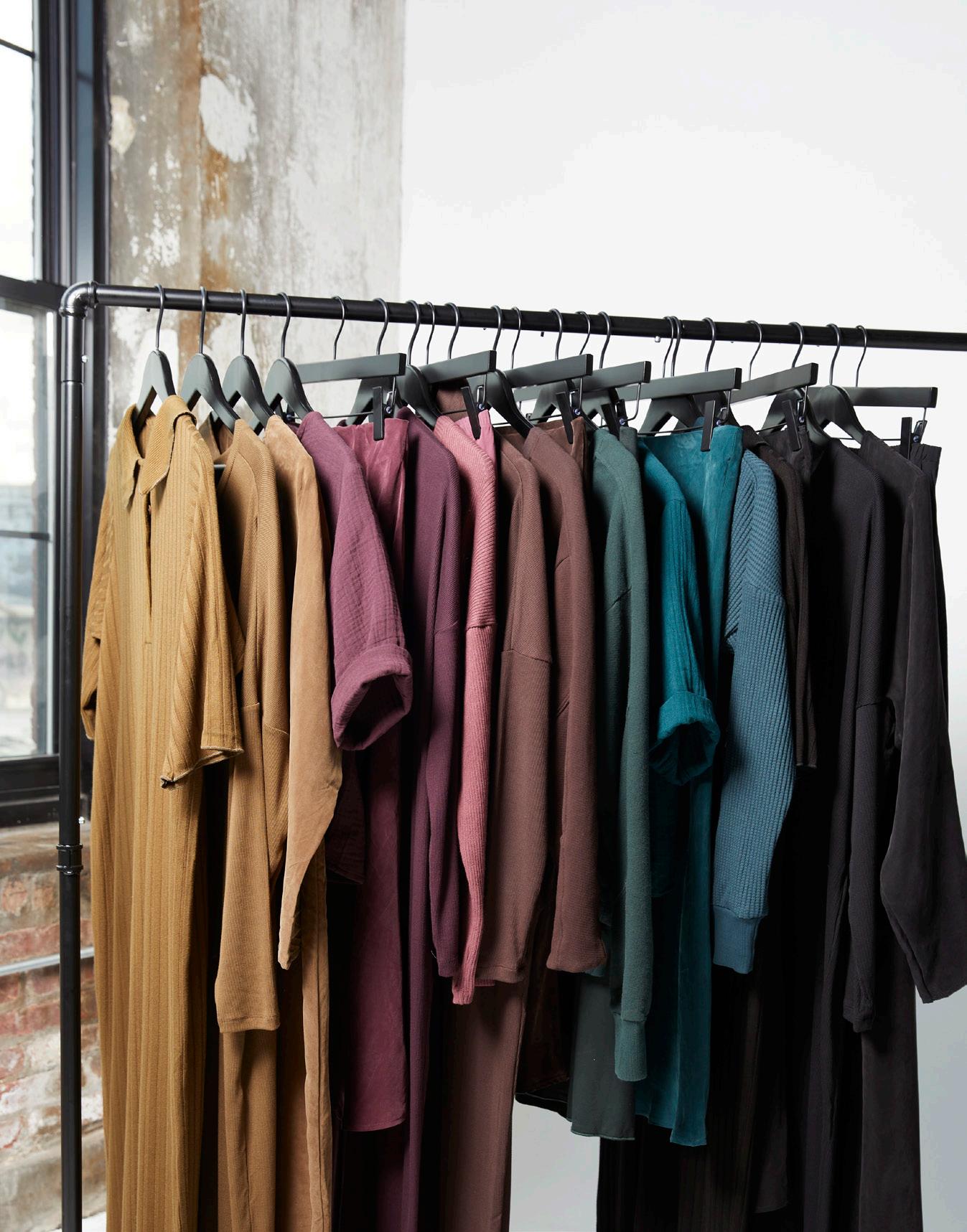
COLLIVE MAGAZINE ADAR II 5784 39
A variety of Solika dresses on a rack. Founded in 2013, the company is based in Los Angeles, California.

been until then, leaving us in quite a lurch. With lots of bitachon and Hashem’s help, we managed to push through.
Take us through the process of how something is made, from the design to the finished product.
Feldman: I envision designs with all body types in mind, working closely with a pattern maker to bring them to life. After fine-tuning the sample, it’s off to production, where quality checks ensure top-notch results. Finally, a photo shoot showcases the design on our website.
Schmukler: From the idea to a sketch to factory collaboration,
each step refines the design. Sample trials ensure perfection before bulk production begins. With meticulous attention to detail, we finalize the colors and fabrics and then present the finished product through a website photoshoot.
Haller: We draw inspiration from various sources and then sketch our ideas. As we create the designs, we think about what it would be like to have them in our closets – Are they pieces we would love? Are they styles that are comfortable, flattering, and easy to wear time and again? Once our designs are confirmed, we go
through sourcing fabrics, choosing colors, and testing the garment on a model who meets our standard measurements before heading into production.
What makes your fashion brand unique?
Feldman: My products are made in South Africa from natural fibers. The designs are really timeless and can be dressed up or down. Recently, I added accessories, expanding my brand to be a broader fashion experience, including leather bags, belts, and phone clutches.
Schmukler: I was born and raised in Italy, where I grew up around the beauty, elegance, and taste of Italian design. Using those ideas, I create stunning, classy designs that are tznius to the fullest extent.
Haller: Our products are proudly designed and created in Los Angeles. We prioritize comfortability, soft fabrics, and attention to detail to produce modest clothing that our customers will want to reach for again and again.
Starting a new business can be all-consuming. How do you balance life, being a mother, and also being an entrepreneur?
Feldman: Cleaning help around the house allows me to manage my business efficiently. Prioritizing family, exercise, and good sleep, along with Hashem’s guidance, contributes to my balancing act.
Schmukler: I learned to prioritize myself and my family before everything else. With that uncompromising approach, I am able to balance the rest.
Haller: Staying organized helps me efficiently manage both my business and personal life. I also try to be fully present wherever I am. If I am at work, I’m 100% there, and if I am at home, I am totally focused
40 COLLIVE MAGAZINE ADAR II 5784
A Damigella pop-up shop on Kingston Avenue in Crown Heights
on my family.
What role has social media played in promoting your business?
Feldman: Living in Cape Town, it can be challenging to have your products seen and recognized around the world. But with social media, we have managed to do just that. I have successfully done popup shops in Sydney, London, Israel, and New York because of my social media following.
Schmukler: I mostly promote my business through social media. As my brand grows, there is a lot of word of mouth as well as many returning customers, but social media plays an outsize role in bringing in new customers.
Haller: Social media has connected us with many great people; our customers, brand partners, and even some of our Solika team were found through social media. We also use social media to build brand awareness, showcase our products, and engage with our



customers.
What challenges do you face in trying to design clothing that also fits the standards of tznius?
Feldman: Tznius clothing requires a lot of fabric, and operating from South Africa with slow shipping speeds can mean that by the time I manage to test a fabric and send it back for mass production, it’s already sold out.
Schmukler: Fabrics are a big one. In the summer, we all love white and breathable fabrics, but these can often be too thin. The challenge is to find a lining that is thick enough, yet still gives the movement and life of the fabric that I’m looking for in that design.
Haller: It can be challenging to design modest sleeves and neck styles, but it is also an opportunity to get creative.
What advice would you give to other women looking to start their own business, in clothing or otherwise?
Feldman: Ask yourself why you want to open this business. If the answer is that it’s what you are passionate about and you feel that it’s your calling, go for it!
Schmukler: Work hard to do your part and trust that Hashem will do the rest. Believing in yourself is important too. When you begin to truly believe in yourself and your brand, the results will surpass your wildest dreams.
Haller: Put your vision on paper and ask yourself why you want to do this. Once your goal is clear, create a plan of how you will get there. Building a dream is not easy, but it’s very rewarding. There will be challenges, so try and look at them as an opportunity to learn and grow. And always remember that the brocho comes from Hashem.
code WELCOME for 10% off @sarah_feldman_capetown damigellashop.com
code COL15 for 15% off @damigella.milano solika.com @solika__
sarahfeldman.co.za Use
Use
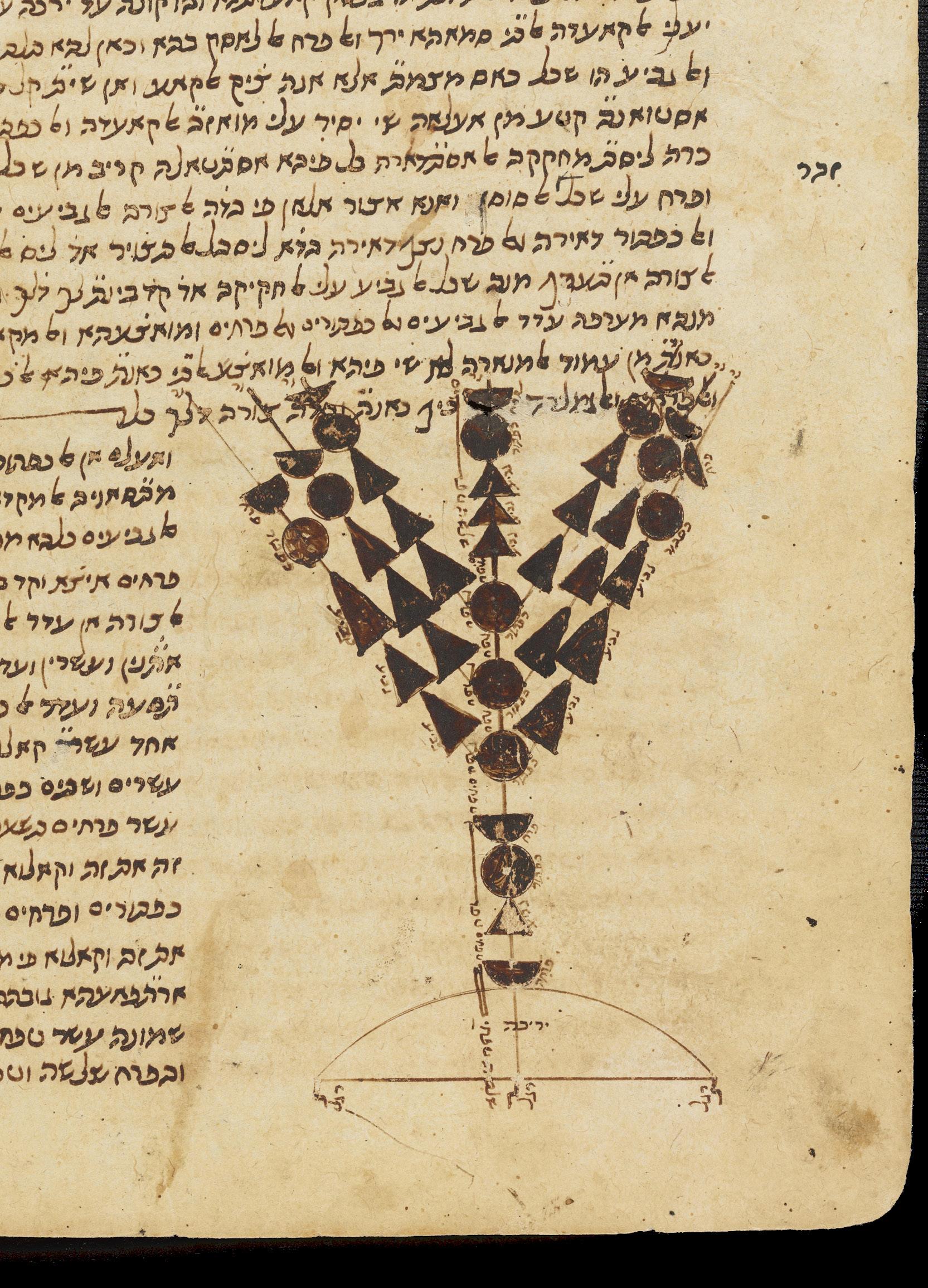
Curating
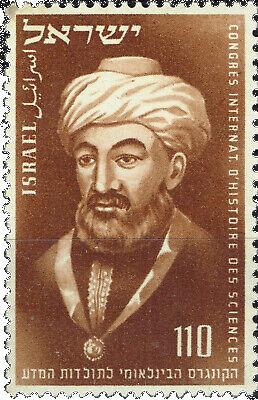

 By Tzemach Feller
Dr. David Sclar turned a private collection into Yeshiva University’s landmark exhibit
By Tzemach Feller
Dr. David Sclar turned a private collection into Yeshiva University’s landmark exhibit
More than eight centuries after the passing of Rabbi Moshe ben Maimon, known as the Rambam or Maimonides, his legacy continues to reverberate. Shuls, schools, hospitals, societies and stamps bear his name and likeness, while his teachings on Judaism, philosophy, medicine, and more influence the lives of many around the world.
Next month, on March 26, 2024 (17 Adar II 5784), thousands of people from around the world will complete the 43rd daily study cycle of the Rambam’s’ Mishneh Torah, a 14-volume compendium of the totality of Jewish law, culled from Torah, Gemara, Midrash and the teachings of Chazal
So what about the 12th-century Rambam cemented him as such an authoritative figure, one whose words resonate with communities from Yemen to Brooklyn?
“Arguably, no other individual has had a more pervasive or enduring effect on Jewish religious life over the last millennium,” says Dr. David Sclar, who curated the landmark exhibition—and authored an accompanying book—titled,”The Golden Path: Maimonides Across Eight Centuries” at the Yeshiva University Museum.
Rambam lived between 1138 and 1204, the descendant of a long line of rabbis, judges, and scholars, Sclar writes. At a young age, Rambam suffered persecution in his native Cordoba with his family, eventually arriving in the Moroccan city of Fez in 1160. He pursued studies in rabbinics, science, and medicine and began to earnestly put his own ideas to paper.
In 1165, he traveled to Eretz Yisroel, residing there for five months before settling in Fustat (now part of modern-day Cairo).
Over the next four decades, Rambam led the Egyptian Jewish

community and served as a court physician to the political elite of the Fatimid and Ayyubid dynasties, which ruled much of North Africa and the Middle East between the tenth and thirteenth centuries.
All the while, Sclar notes, Rambam produced masterpieces in halacha, philosophy, science, theology, and ethics, guiding Jewish communities worldwide with his expansive knowledge, deep wisdom, and innovative thought.
“We have more source material from or about him than possibly any other medieval Jewish figure, and more has been written about him than perhaps any other Jew in history,” Sclar writes. “The reception of Rambam’s texts and ideas, and the personal and collective evaluations of Rambam the man, have served as Jewish constants through incessant change.”
Interestingly, Sclar’s journey to becoming an expert on Rambam was different from what he planned or expected.
Born and raised in suburban S. Louis Park, Minnesota, Sclar had an affinity for history from a young age. He channeled
that interest in history at the University of Arizona. Sclar went on to Yeshiva University’s Bernard Revel Graduate School of Jewish Studies, where he received his Master’s Degree in Jewish history. His doctorate followed at CUNY Graduate Center, where Sclar wrote his doctoral thesis on Rabbi Moshe Chaim Luzzatto—also known as the Ramchal—a noted Italian scholar and poet.
Sclar’s expertise was quickly noticed, and he was hired by the Library of The Jewish Theological Seminary, which houses one of the most significant collections of Judaica in the world. Sclar began co-curating exhibitions with the Library’s Curator of Jewish Art, Sharon Liberman Mintz.
Then, Sclar was introduced to Robert Hartman, a Chicago-based businessperson and lay leader. Hartman has spent some twoand-a-half decades painstakingly collecting and preserving rare manuscripts and printed material pertaining to the Rambam, but until now, very few had ever laid eyes upon his collection.
“Mr. Hartman initially hired me to write a catalog of manuscripts and to serve as a private curator
COLLIVE MAGAZINE ADAR II 5784 43
Dr. David Sclar leads a tour of The Golden Path exhibition.
of his collection,” Sclar said. In 2019, Hartman decided that his collection was too precious not to share with the world. Sclar recommended that the exhibition be offered to the Yeshiva University Museum in the Center for Jewish History, a Smithsonian Institution affiliate on 16th Street in Manhattan.
Hartman knew just the person he wanted to curate the exhibit: Dr. Sclar. Together, they would create “The Golden Path” exhibition.
As Sclar prepared to embark upon this bold initiative, he reached out to Rabbi Yossie Shemtov, his mentor from his days at the University of Arizona. Rabbi Shemtov, Executive Director of Chabad Tucson, has been an avid learner of Rambam’s teachings. In fact, he presents a daily insight from Mishneh Torah after Shacharis each morning.
“Chabad was very influential to me, and Rabbi Shemtov in particular,” Sclar said. As each work of Sclar’s was prepared for publishing, he had sent them for Rabbi Shemtov’s review and comments, and now, he reached out once more.
“David felt he couldn’t put the exhibition up without talking to the Lubavitchers,” Rabbi Shemtov humbly explained. That’s because the Rebbe, when he introduced the daily study of Mishneh Torah in 1984, created a movement that catapulted the work from a reference book better known to scholars to a book studied by thousands each day.
The Rebbe explained that studying the work of Rambam is a singularly ideal way to gain knowledge of the entire Torah—something Rambam himself writes in his introduction to the work—as Mishneh Torah is a concise compendium of all of halacha
Reflecting this, the exhibition
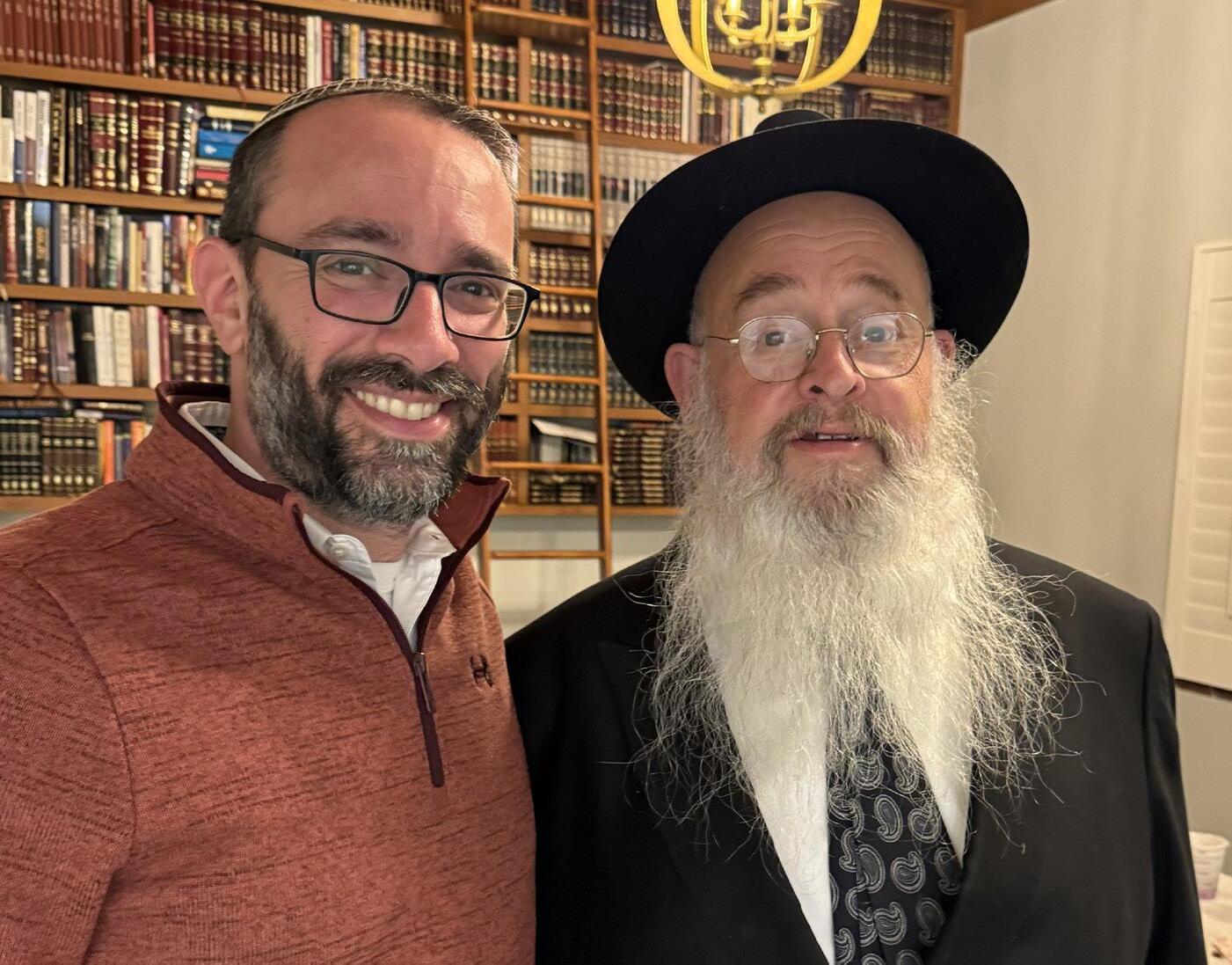
contains a reproduction of a 1986 New York Times article written on the occasion of the second Siyum HaRambam—celebrating the conclusion of the yearlong study cycle that sees the entire Mishneh Torah studied at the rate of three chapters a day.
“The people praising him were centuries removed from the life of Rambam, who was born 851 years ago in Cordoba, Spain. Yet, after intensely studying his work this last year and applying his teachings, they gathered yesterday to celebrate the wisdom of the sage known to them as Rabbi Moshe ben Maimon, the Rambam,” the Times wrote, going on to quote the Rebbe, who said that “One of the principal elements in the study of Rambam is the unification of Jewry.”
That unification of Jewry from around the world is seen throughout the exhibition. One striking example is a Yemenite manuscript dating back to the end of the 16th century, hundreds of years after Rambam’ passing. And yet, remarkably, the manuscript depicts the Menorah in the Holy Temple—with straight, diagonal
arms. Rambam himself was one of the prominent proponents of the school of thought that posits that the Menorah in the Beis Hamikdash was of this shape, and the exhibition demonstrates that his teachings continued to influence Jewish communities many hundreds of miles away for many hundreds of years.
“This shows that Yemenite Jews are careful to copy Rambam’s work,” Sclar explained. “This scribe would not have seen the drawing attributed to the Rambam, but his teachings were passed on for generations—there are at least a dozen instances of straightbranched menorahs in historical Yemenite manuscripts.”
The Menorah is also, Sclar explains, a striking example of the timelessness of Rambam’s teachings up until and including the modern era. “At this point, the single most common shape of a menorah in the world is what Chabad ultimately uses—the shape taught by Rambam.” Today, Chabad places an estimated 10,000 public menorahs worldwide, and Rambam’s iconic, straightbranched Menorah illuminates

44 COLLIVE MAGAZINE ADAR II 5784
Dr. David Sclar and Rabbi Yossie Shemtov, Executive Director of Chabad Lubavitch of Tucson, AZ
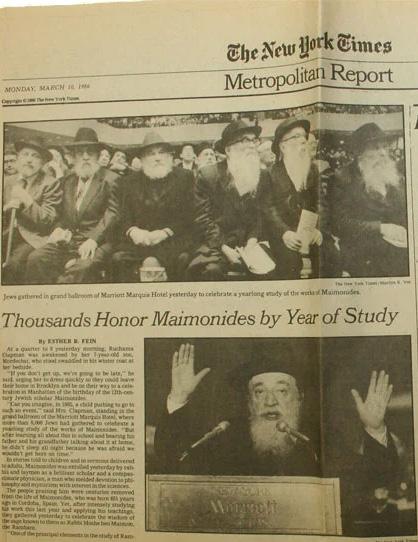
more than 100 countries.
“The Golden Path” book authored by Sclar contains a detailed catalog of the Hartman collection, as well as a collection of 11 essays from scholars and experts in their fields. Both the book and the exhibition contain rare gems, including fragments from the Cairo Geniza in Rambam’s hand, including writings on the importance of Pidyon Shevuyim, the redemption of hostages — “unfortunately far more relevant than it should be,” Sclar says.
What’s next? Sclar says he’d love for the exhibition to travel, to enable as many people as possible to benefit from this unique look into the life and legacy of a Jewish giant—but he acknowledges that that’s a challenging undertaking. Regardless, Dr. David Sclar’s scholarship and Robert Hartman’s collection will continue to shine a light on the individual who, as the Rebbe said, gathered all of Jewish law—and in doing so, created a framework for the unification of Jewry.
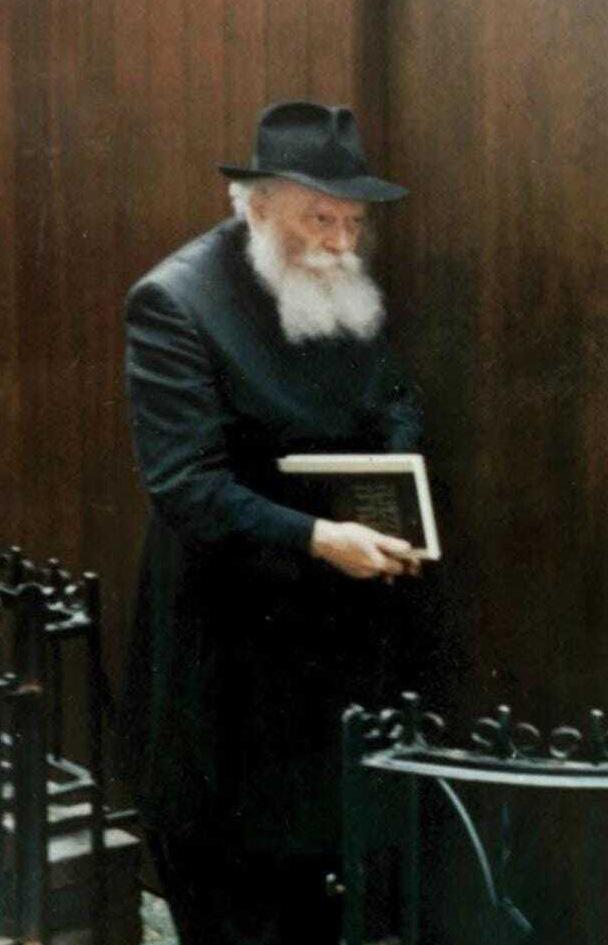
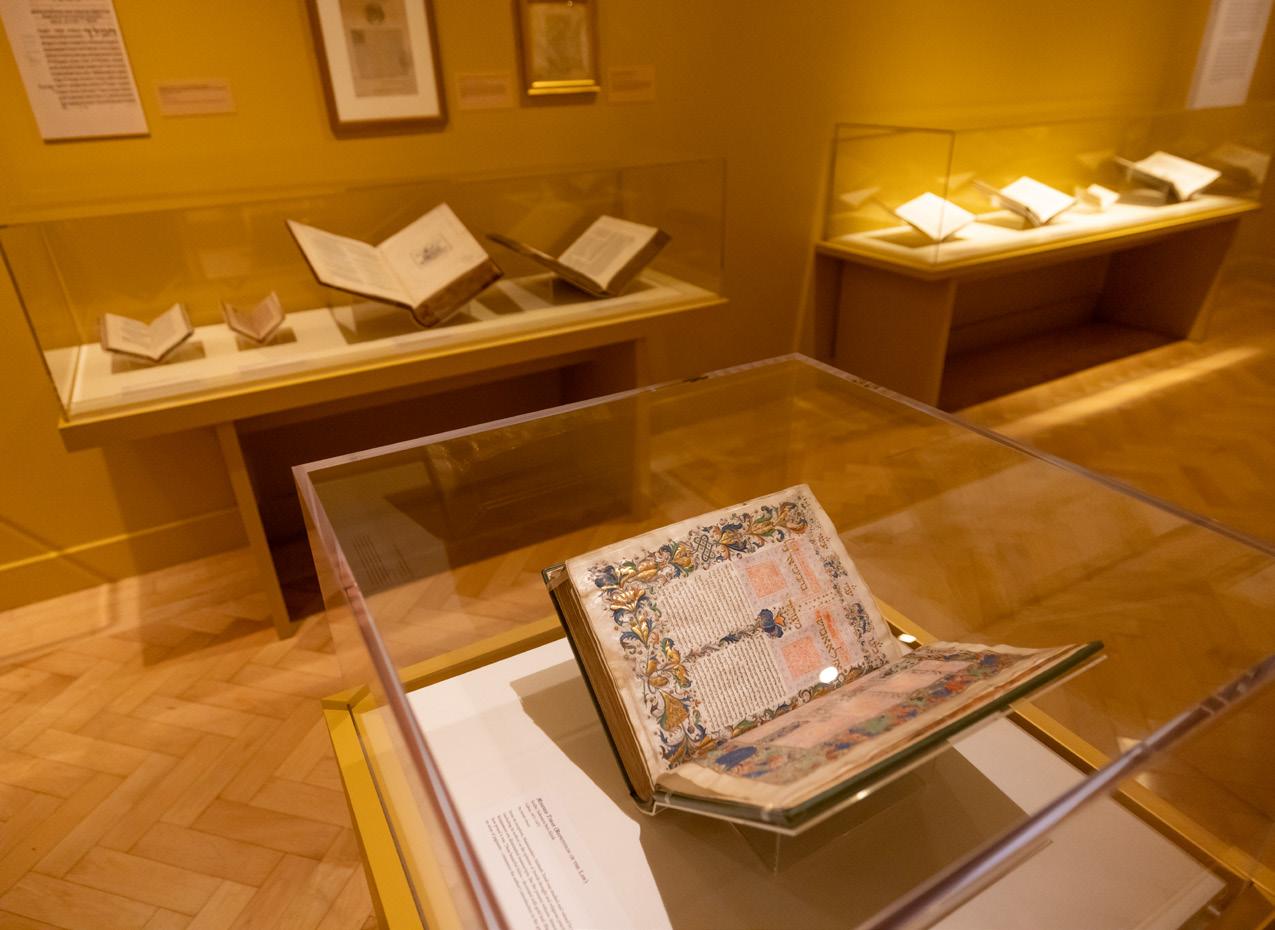
COLLIVE MAGAZINE ADAR II 5784 45
The Rebbe returns to his office from the Sukkah holding a Rambam on 17 Tishrei, 5750
Part of the exhibit at Yeshiva University.

The story of longtime Crown Heights sofer Rabbi Yehuda Clapman
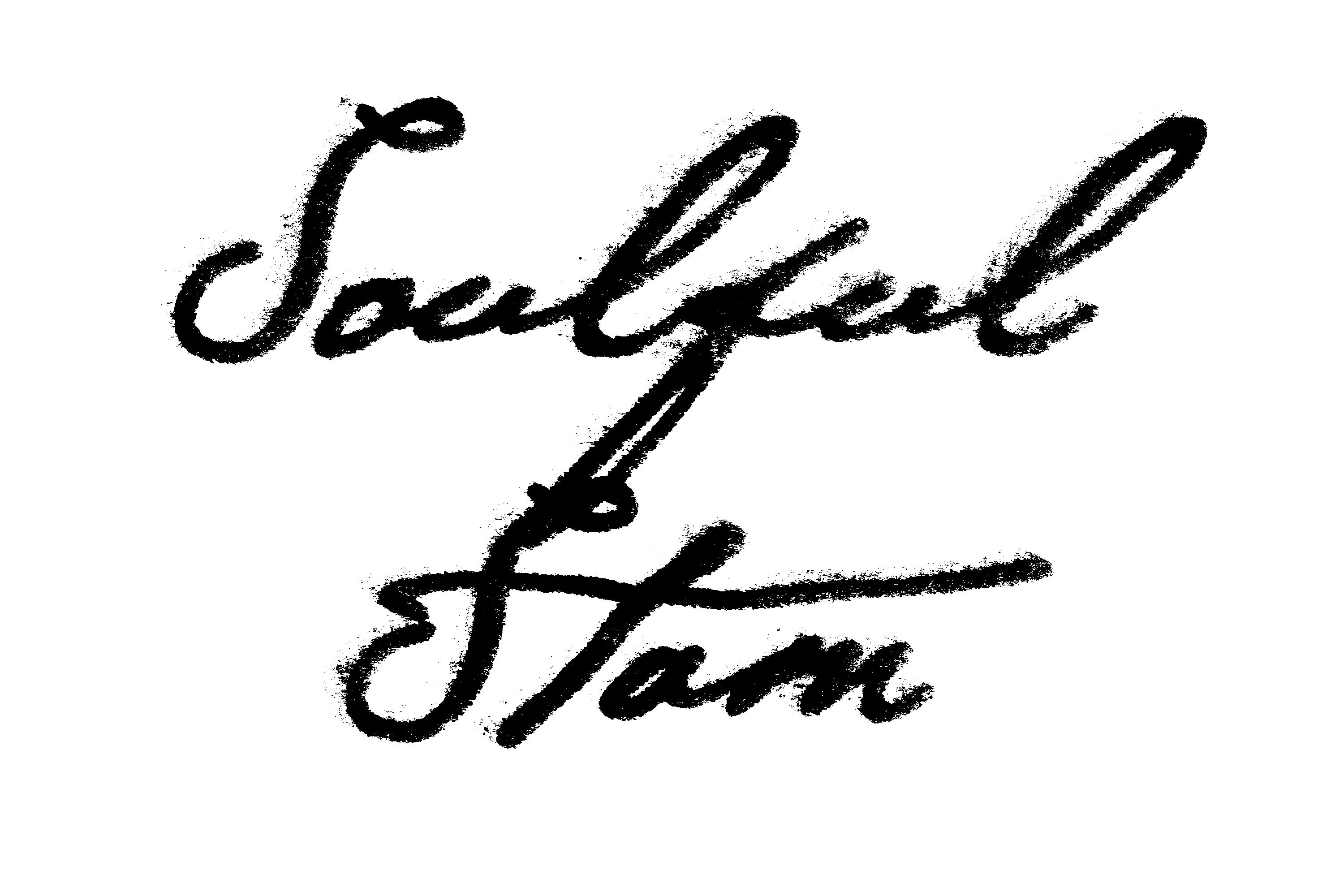

 By Dovid Zaklikowski
By Dovid Zaklikowski




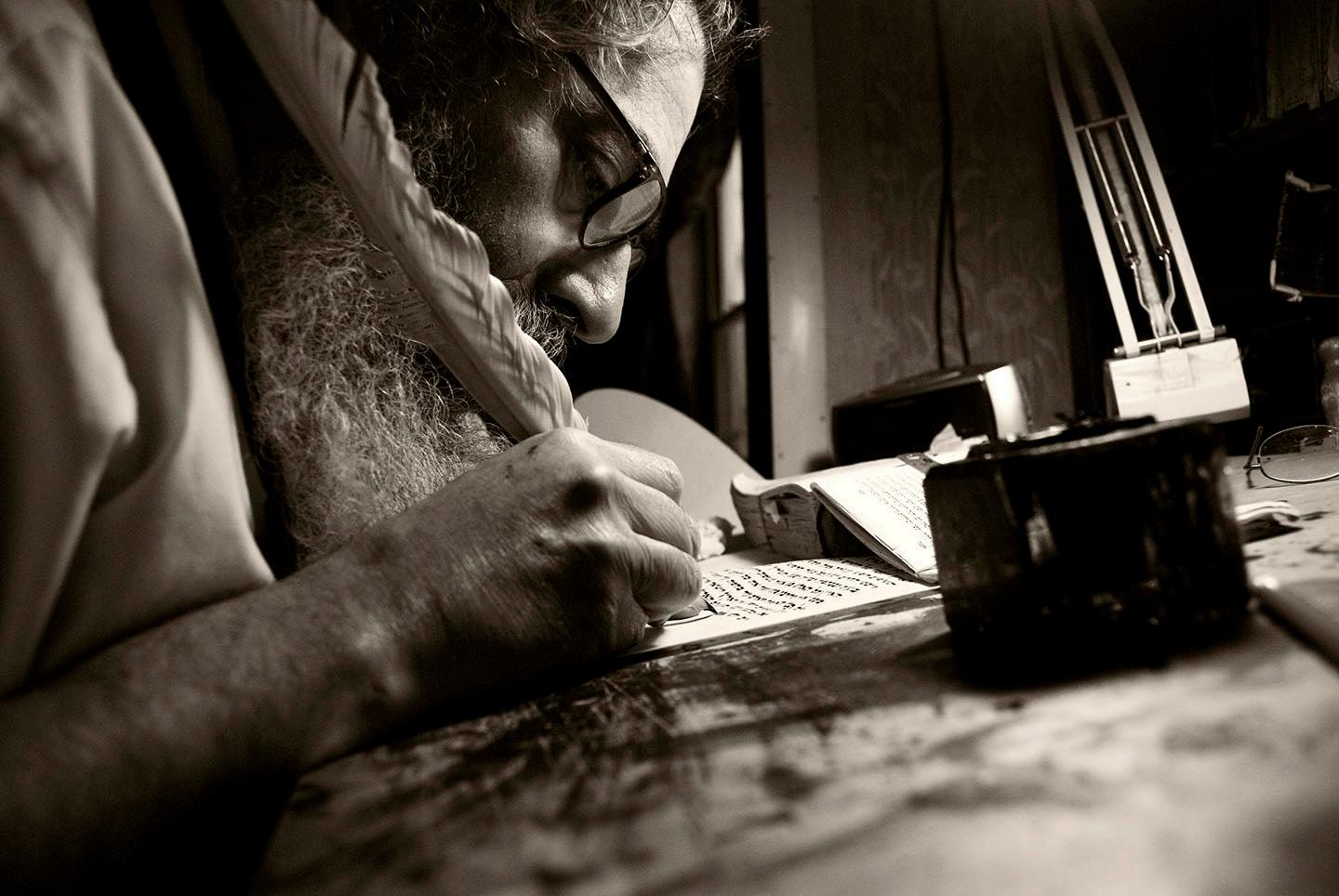
Rabbi Yehuda Clapman was five years old when his father grabbed him by the wrist at the Ahavas Achim shul in East Flatbush. His father told him to watch as the Torah was rolled to the correct place. “Every one of those columns,” he was told, “every line, every word, was written by hand.” He thought to himself: It is so perfect; how was that even possible? “I was fascinated, and I wanted to learn more,” Rabbi Clapman, the longtime Crown Heights sofer, recalled. But his hopes were dashed when he asked a local sofer if he could learn the trade from him. The man sent a message through his son that he was not interested.
Rabbi Clapman, 17 at the time, then met a new sofer who had moved into town: Rabbi Eliezer Zirkind.
Upon hearing that the young bochur wished to be a sofer, Rabbi Zirkind asked why he was not. “No one wants to teach me,” the bochur answered.
Instantaneously, Rabbi Zirkind jumped up from his chair and left the room. Rabbi Clapman did not know what to do. Should he stay and wait, or was that just another way the sofer was hinting that he did not want to teach him?
He decided to stay, and Rabbi Zirkind soon returned with ink and parchment paper and said he would teach him. “Every time I had time off from yeshivah, I went to his house,” Rabbi Clapman said. “I didn’t go to ball games; I didn’t know from any of that stuff. I had no interest in it.”
Learning with Rabbi Zirkind would be a lifelong experience. “I was
like his child,” Rabbi Clapman said. Whenever the young Clapman could find time between his learning at the Mir Yeshivah, he went to learn safrus with Rabbi Zirkind.
Rabbi Zirkind’s Blood
In the Crown Heights community, perhaps most can detect a member of the Zirkind family. They have long payos, long jackets and up hats. For many, Rabbi Eliezer Zirkind is a legend. A legend, misunderstood and shrouded in mystery. For Rabbi Clapman, Rabbi Zirkind was a father, teacher and, in all of his humility, a chavrusah too.
Besides teaching him how to write sta”m, from the time he began to
COLLIVE MAGAZINE ADAR II 5784 47
Rabbi Clapman writing a mezuzah.
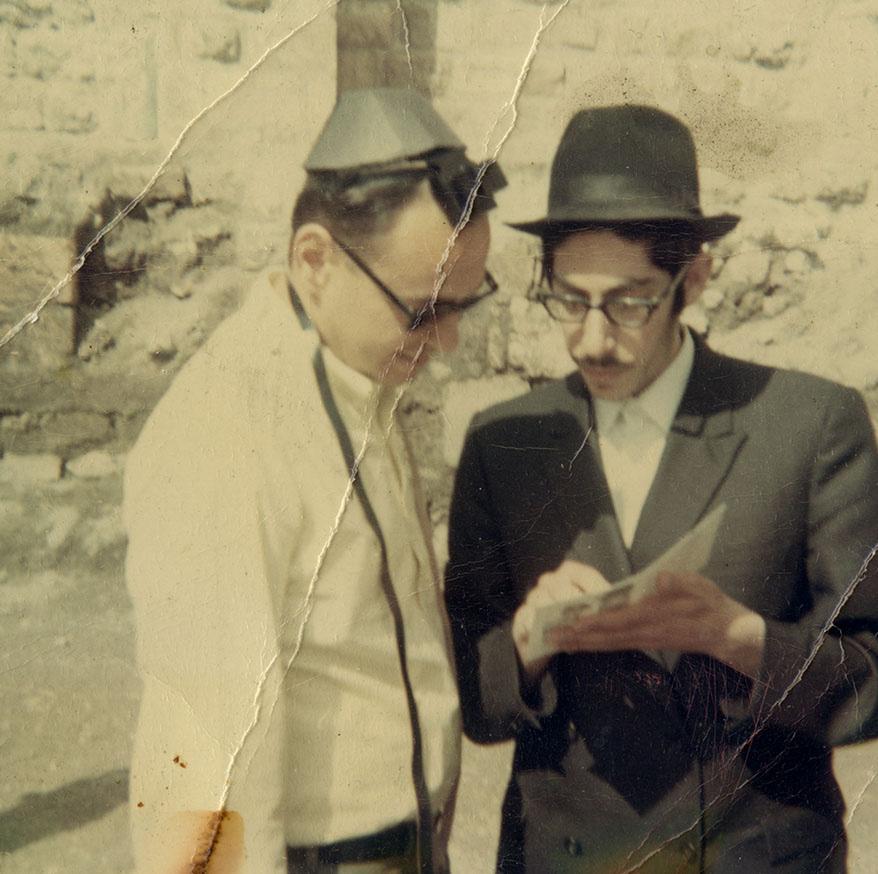
learn in 770, they learned together for six hours a day (later, after Rabbi Clapman married, for five). The learning happened while Rabbi Zirkind was preparing supper for his family (Mrs. Zirkind was a chemist at Kings County Medical Center and would come home around supper time).
They would learn at his home, but Rabbi Clapman still wanted to be considered part of the yeshivah so Rabbi Mentlick gave him permission and would check in with Rabbi Zirkind how the studies were going. He would also ask the young bochur how the learning was going.
Rabbi Clapman once asked Rabbi Mentlick whether the rosh yeshivah really did not want him to go learn with Rabbi Zirkind. Rabbi Mentlick responded that it was not the case, “If only I could have such a chavrusah for six hours a day,”
was his reply.
Being at the Zirkind home for so many hours a day, Rabbi Clapman learned about the family’s kindness and hospitality. He also learned of Rabbi Zirkind’s handiness, and how he held his wife in great respect, never infringing on her ability to work, or impose his hobbies on her. Before Shabbos, he recalled, they would bake all the challah and bake goods together. After Shabbos, Rabbi Zirkind would be there in the kitchen scrubbing the dishes with her.
People were afraid of him, Rabbi Clapman said, scared that he would look down on those who did not act like his family did. “I was like a child to him,” he said, “but he never mentioned hats, bekeshes, or payos. He only demanded stringencies from himself, and they had nothing to do with anyone else.”
But to Rabbi Clapman, his passion for sta”m was above all, “This was his life. If you would ‘cut his finger’, safrus would come out.”
When Rabbi Zirkind would be asked what the important details a sofer should know, Rabbi Zirkind would say one thing: You have to continue studying the halachos of sta”m. “You owe it to your customers to regularly sit and learn the halachos,” he would say.
In fact, for forty-eight years, Rabbi Zirkind would teach a weekly class, which is continued by his students until today.
The ssciial Soul
For years, Rabbi Clapman has been saying that people know little about what goes into the making of sta”m, the Hebrew acronym of sefer Torah, tefillin and mezuzah. “They really don’t have any idea how it’s made and what goes into it,” he said. “I think they should have a deeper understanding of what it is all about.”
What a person usually sees is just the end result, but he explained there is much more to it. It is like a person’s body and soul; what you see is the body, the physical sta”m However, the soul of sta”m are things like the kind of parchment and ink used and the thoughts and intentions the sofer had while writing it. “The behind the scenes,” as he likes to refer to it.
There is a long list of what would make sta”m more mehudar, he said, though he hates to use that word when it comes to sta”m. There is the intention when creating the parchment. Or whether it is from an animal that was shechted, or even better, if it was in the womb of the animal that was shechted. Another factor can
48 COLLIVE MAGAZINE ADAR II 5784
Rabbi Clapman, 17, while still learning at the Mir yeshivah, doing Mivtzah Tefillin.
be if a goose feather is used to write.
Most of that which would make it “mehudar,” he said, cannot be seen with the ordinary eye. “It has nothing to do with the writing and can only be known if you had a conversation with the sofer who wrote it,” he said. Of course, if you trust the sofer
A sofer, he said, needs four things when they begin to write: Hashem’s assistance, good parchment, ink and a feather. “Then the writing is like physical therapy,” he said. “However, if one of them is off-key, then forget it.”
As someone who enjoys talking, Rabbi Clapman wished that writing sta”m would be as easy as having conversations. But conversations—another aspect that cannot be detected when you do not know the sofer—are something he does not have while writing. “My kids used to love when I was writing a mezuzah or tefillin,” he said selfeffacingly, “because I didn’t talk during that time.”
Someone once angrily called him, saying they were trying to reach him all day, “I am going to go to someone else for my tefillin.” But then, he said, “On second thought, the same way you didn’t talk when you wrote someone else’s tefillin, you also won’t when you write mine. That is a person I should get my tefillin from.”
Every person, he said, should have this “no talking policy” when it comes to sta”m every day. He asks parents to bring their bar mitzvah boys to his home. He tells them a story he heard from Rabbi Zirkind: There was once a rabbinical convention in Europe. Each person who spoke said, “My heilege father
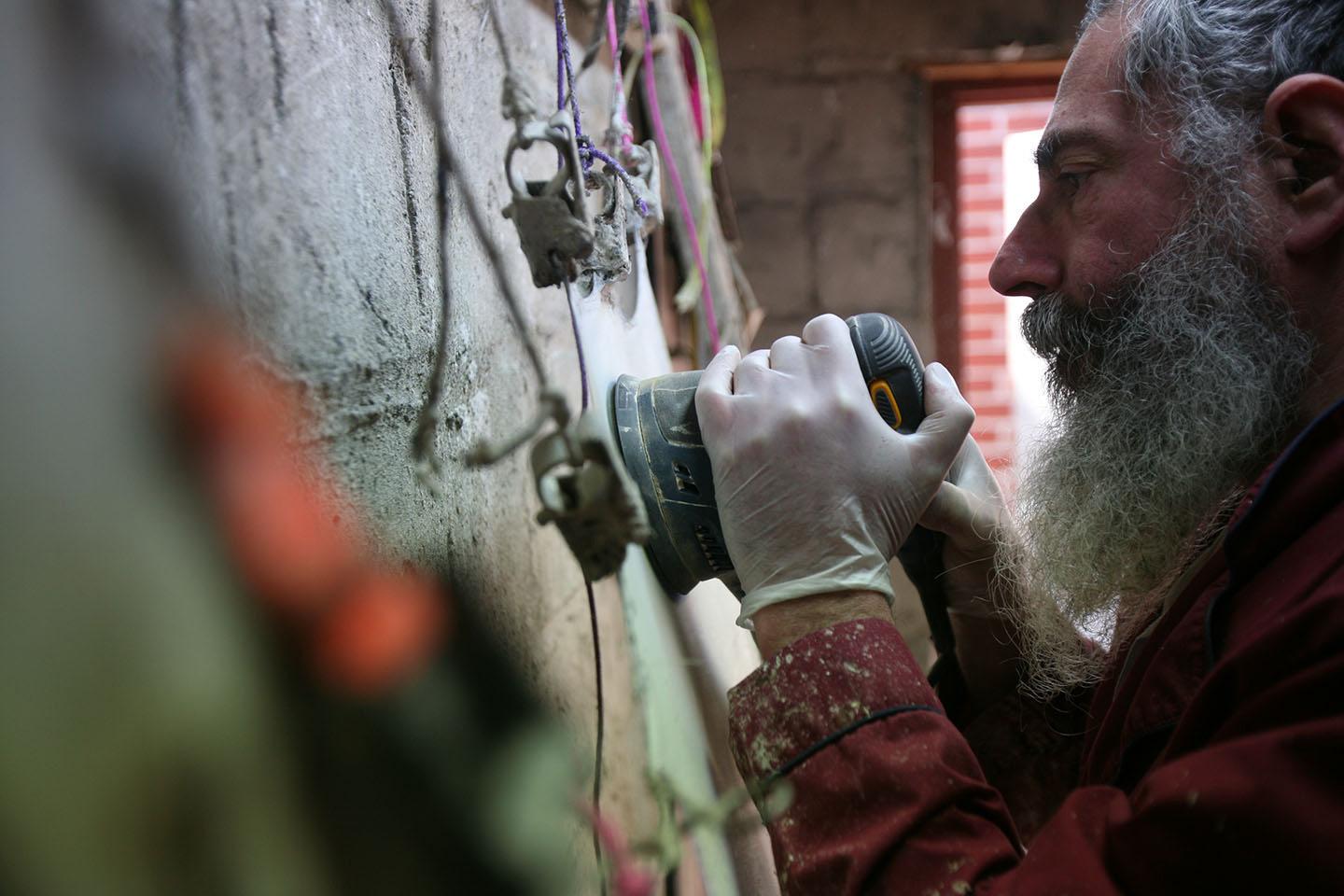

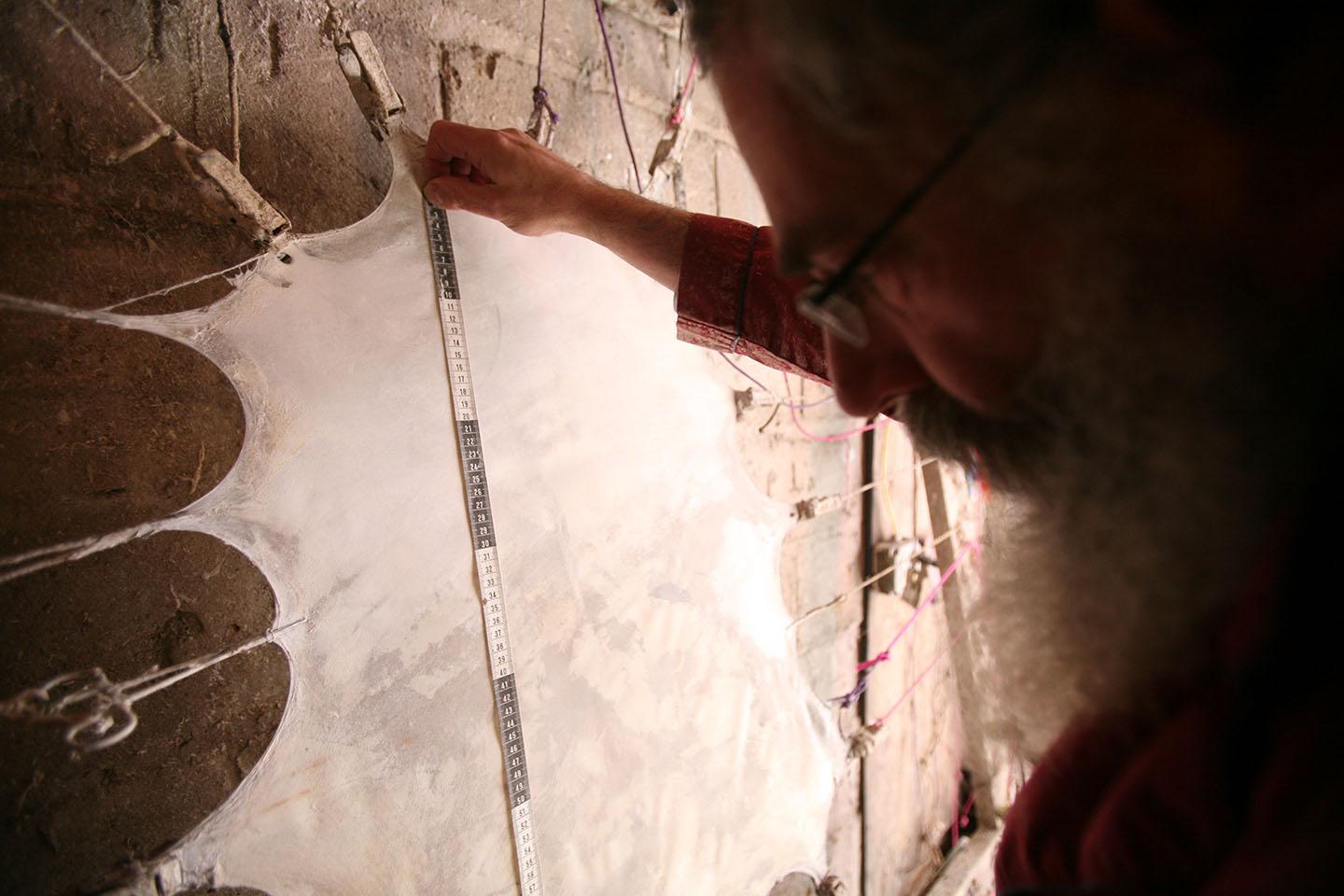
COLLIVE MAGAZINE ADAR II 5784 49
Rabbi Clapman makes the parchment to be used in Stam.
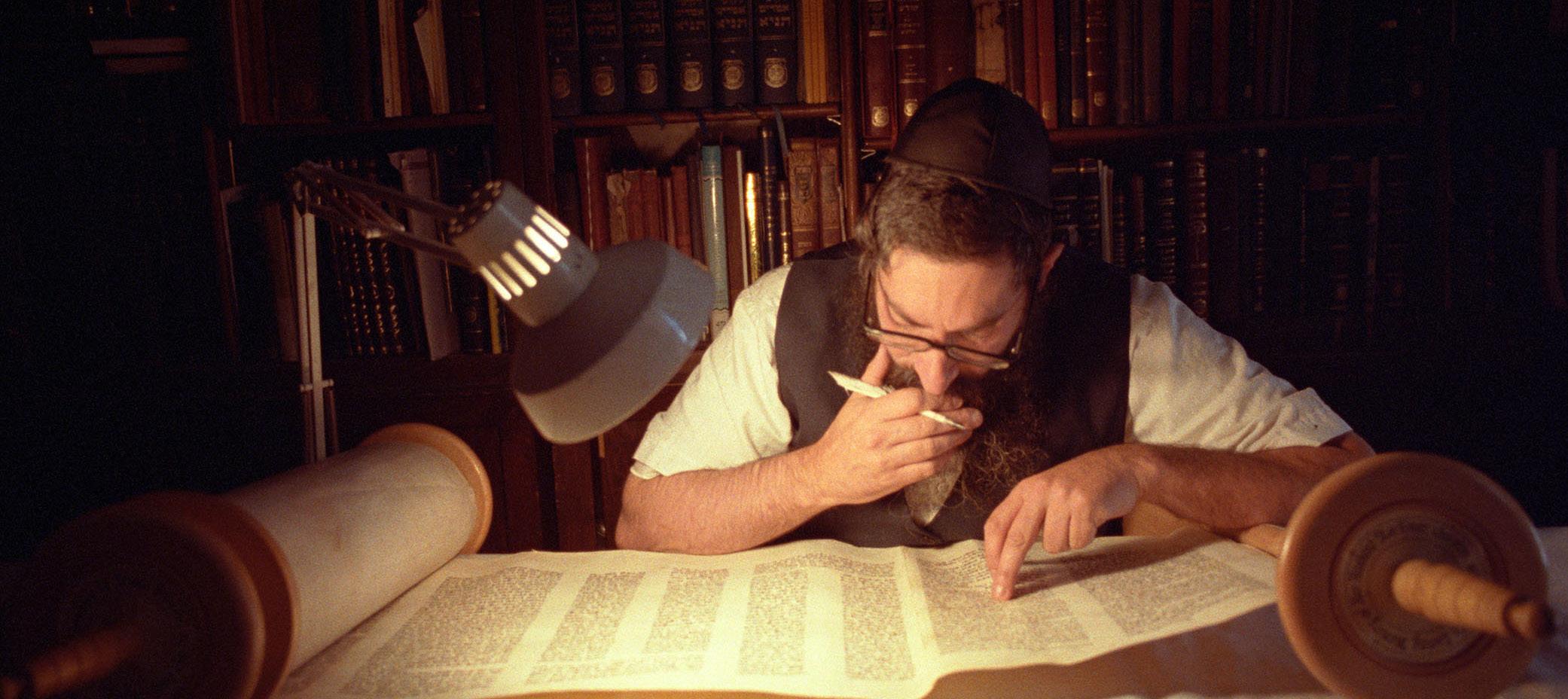
said,” this and this. Then one brilliant scholar stood up and said, “I would like to tell you a teaching from my father the tailor: ‘The old things you have to fix, the new ones don’t spoil.’”
He points to the new pair of tefillin, and tells them, “Now you have a new pair of tefillin, the new ones don’t spoil. Your job is not to speak during davening while you are wearing your tefillin.”
A PSilent cayec
Rabbi Clapman credits his parents with the possibility of even entering the world of safrus. “They never mentioned the word money in front of me,” Rabbi Clapman said. Without talking about finances, he never thought about how he was going to make a livelihood and whether being a sofer was a viable profession.
Today, he said, if you are going to become a sofer purely for the money and not because it is your calling, it should not be pursued. “There is a good reason why not so many people become sofrim,” he said. He added that for him, it
is very rewarding. “Each time you finish sta”m, it is like you had a new baby,” he said. “It is a great feeling.”
Now writing for over five decades, Rabbi Clapman said that the downside of writing sta”m, is the great responsibility. With all the precautions, he said, you still make mistakes. For this reason, before giving it to a client, he always gives all of his sta”m to another sofer to check. (A computer check is a good idea, he explained, but it should always be coupled with a sofer looking it over too.)
Once, two teenagers came to his house to speak to him. He was in the middle of writing and could not talk. The two watched him, and one told the other, “Should we tell him?” Rabbi Clapman looked up and motioned to them what the issue was. They said he had missed a letter.
When it comes to certain situations, the sta”m can be fixed. But in this case, it could not, and he had to place the mezuzah into sheimos. He was glad they did not let him continue, “And write Hashem’s complete name a few more times, when I would have to place it in sheimos anyway.”
For this reason, he said, he has
a silent tefilla that he says or thinks before starting to write: “If it is bashert for it to be passul, it should stay on my desk, and not go further. True Hashem, you may have wanted the ink, klaf and my time to be wasted, but at least no one should be nichshal in having a passul mezuzah.”
Rabbi Clapman, who also makes his own parchment, said that seeing people wear his tefillin, and knowing a home he passes has the mezuzahs he wrote, brings him a tremendous feeling of gratitude that he was able to assist another person do a mitzvah
Sitting in his home, surrounded by seforim, family pictures and artwork his son is selling, he said that he tries to learn a lesson from everything he sees in life. In safrus too, there is a lesson to be learned: “The letters must stand all by themselves and not touch one another. That teaches us how important every person is and that we can’t lean on any other person to do what we’re supposed to do ourselves.”
Dovid Zaklikowski is a biographer and historian. His books are available at www.HasidicArchives. com. He can be reached at DovidZak@Gmail.com

50 COLLIVE MAGAZINE ADAR II 5784



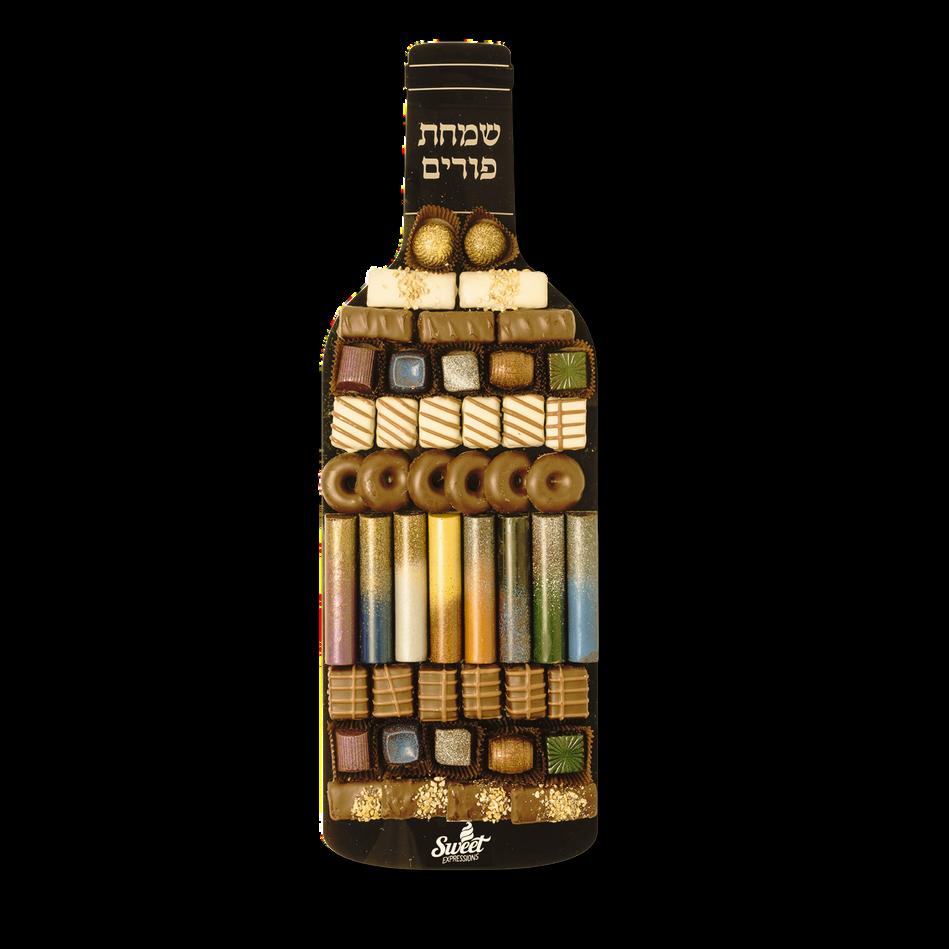




Your one stop shop for all your Purim needs! sweetexpressionsch com 718-613-0188 310 Kingston Ave / 351 Troy Ave Brooklyn We do corporate and custom orders! s q u a r e d e s i g n 0 4 @ g m a i l c o m GOTTESMAN MEDICAL PC DR. ABIE GOTTESMAN Tel: 646.757.8751 Fax: 877.885.5991 Telemedicine Whatsapp 718.594.0503 gottesmanmedicalpc@gmail.com
PURIM WITH THE REBBE
14 Adar 5749
Presented by JEM
It is a well-established minhag that children dress up on Purim in all sorts of costumes and outfits. Besides being a fun way to enhance the simcha of Purim, the Rebbe explained that the custom conveys a deep, spiritual message: That the sins which a Jew commits, such as the ones committed by the yidden in the Purim story, are merely an external layer covering over their true identity which is to be connected to Hashem and aligned with His will.
While the Rebbe encouraged children to embrace this minhag, he also cautioned against dressing up in costumes that embody a negative character or personality.
On Ta’anis Esther 5743, the Rebbe elaborated on this point in a sicha. In it, he highlighted the point that children try to imitate the person or idea that they are dressed up to complete the look and garner attention. For this reason, it’s important that the characters that they dress up as are appropriate role models for a Jewish child. The Rebbe later asked for the sicha to be printed and publicized.
52 COLLIVE MAGAZINE ADAR II 5784
1


54 COLLIVE MAGAZINE ADAR II 5784



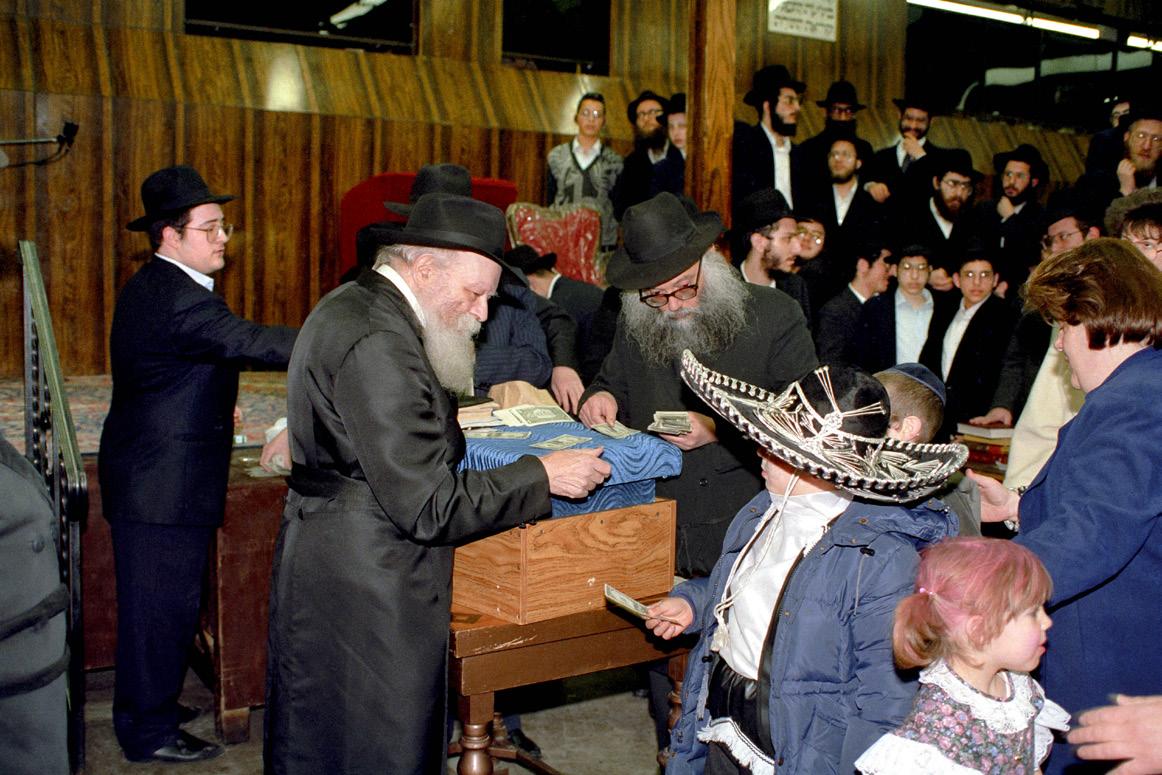
COLLIVE MAGAZINE ADAR II 5784 55
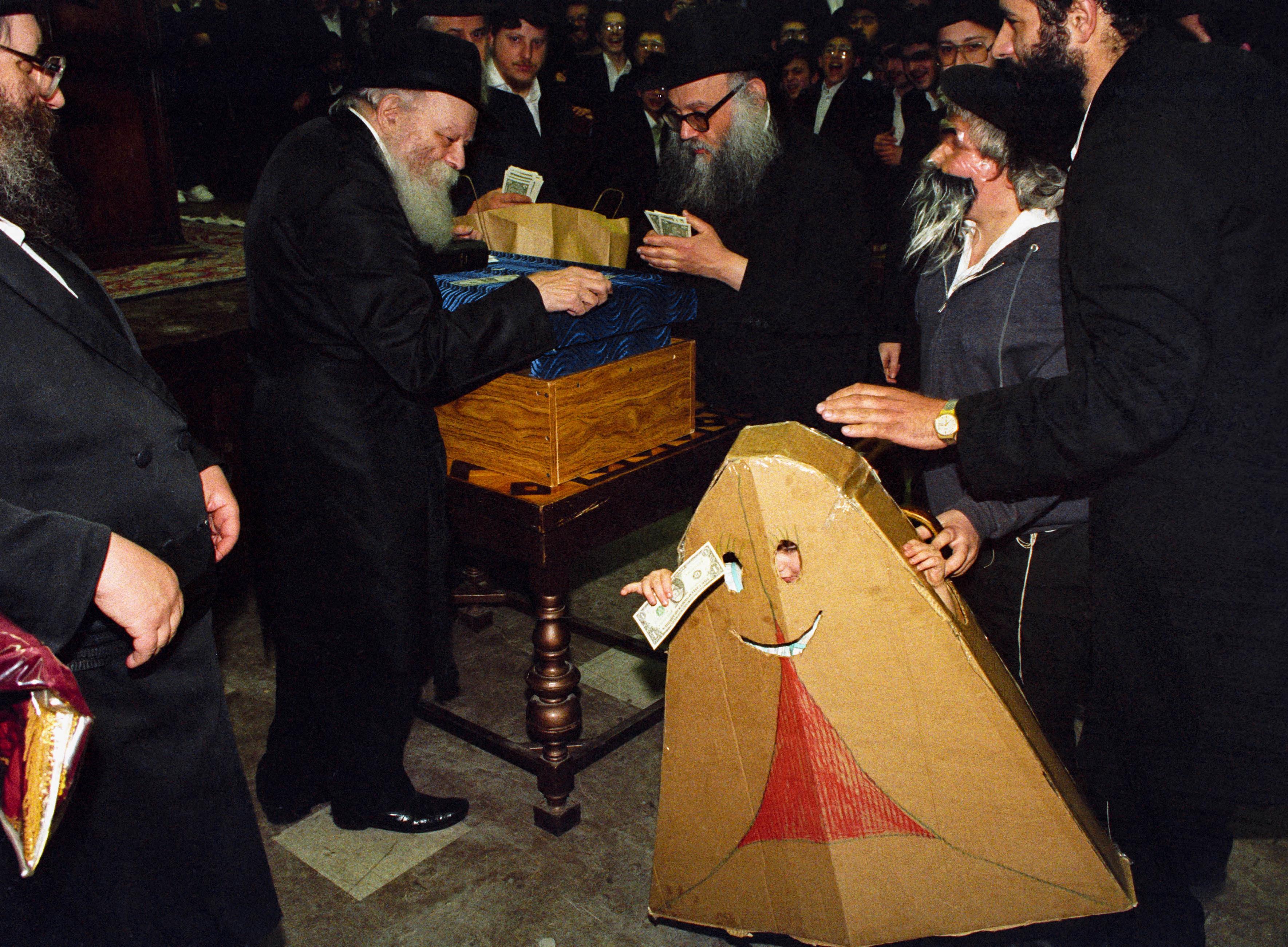
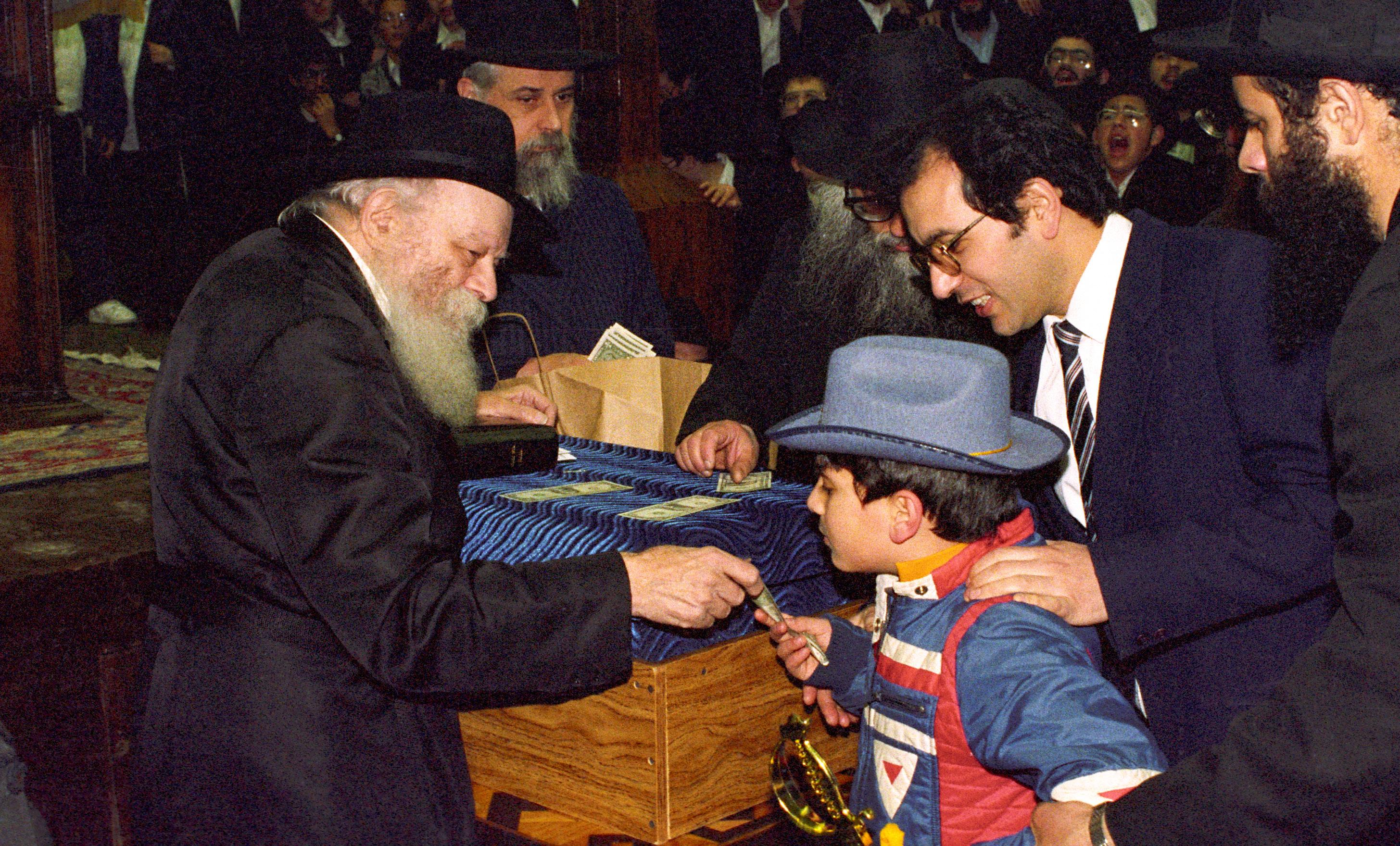
56 COLLIVE MAGAZINE ADAR II 5784
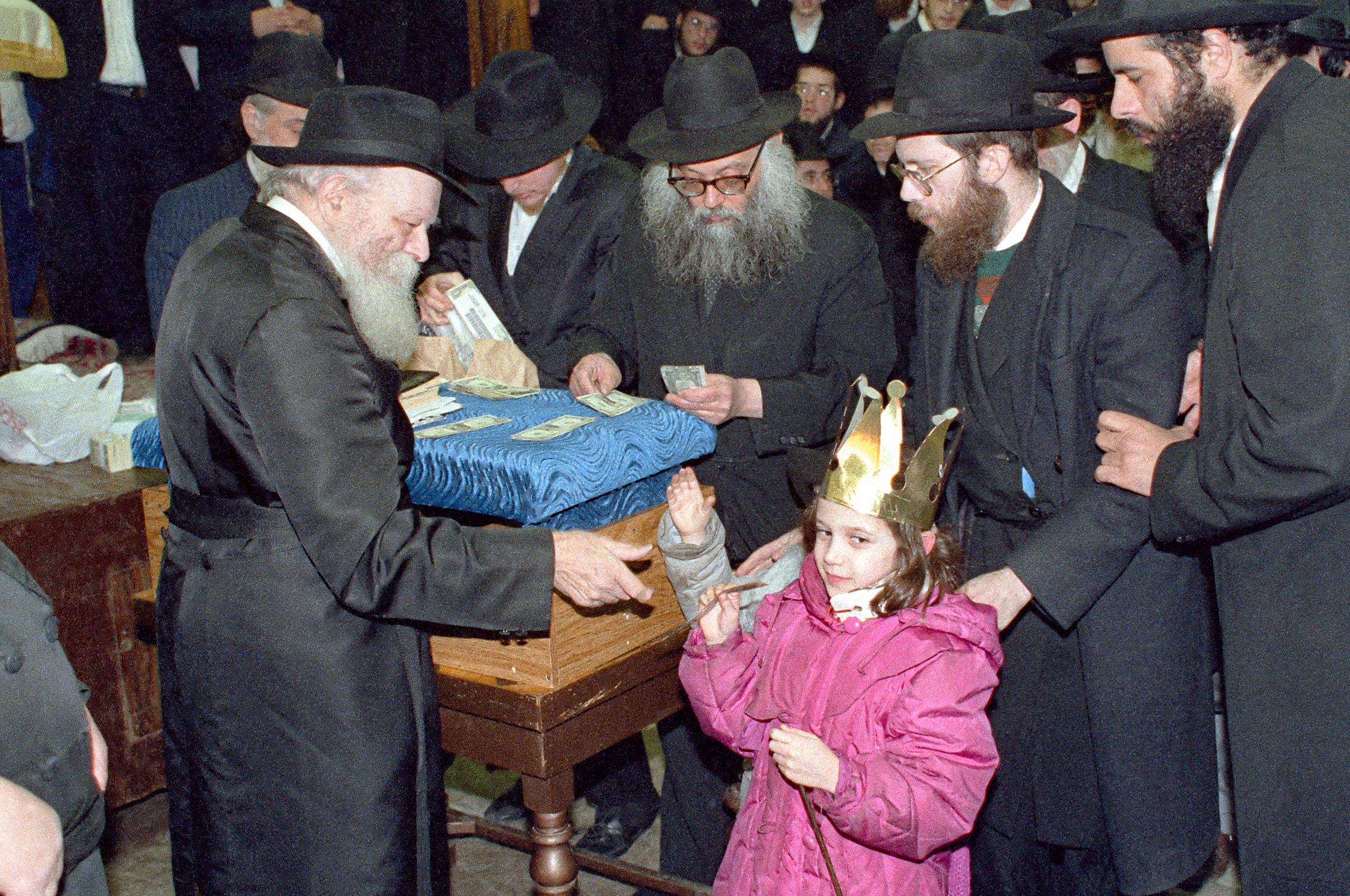

COLLIVE MAGAZINE ADAR II 5784 57
Chinuch Matters
PRESENTED B Y COLLIVE AND THE MENACHEM EDUCATION FOUNDATION (MEF)

Rabbi Shmuly Ceitlin Torah Day School in Houston, Texas
Tell us about your childhood.
I grew up in Toronto, Canada, which was a relatively small community at that time. Both of my parents were teachers, which influenced my upbringing significantly. As a child, my siblings and I often played school together, creating worksheets, writing late notes, and organizing files as if we were the teachers.
Some of my fondest memories are from school. One particular memory that stands out is when my teacher asked me to assist him with a surprise for the class, which involved taking the entire class to his house to make doughnuts together. To this day, I vividly remember how special and valued I felt during that time.
Which teacher inspired you?
My 8th-grade teacher. We would have conversations during recess and after school despite it being break time for him. I used to take his handwritten worksheets, type them, and send them back to him. I believe he still uses those revised versions today.
Did you always want to be a teacher?
I don't remember ever wanting to be a teacher while growing up. After being a Shliach in the Yeshiva in New Haven, I stayed the next year as an Alter Bachur and stayed a third year as a teacher of Shiur Alef. During this time, I realized teaching was something I wanted to pursue. About five years ago, I decided to move to Houston to teach in the Torah Day School and run the pre-mesivta program and community programs.
What is your favorite part of teaching?
Seeing the students understand the information you are teaching and get excited from it, as well as when I see the students implementing things that I taught them during their own time. When you see a child turn around in their learning and behavior, the nachas is unbelievable.
Can you share advice for new teachers?
Enter the classroom with a wellthought-out plan on how you want
to manage your classroom. Each month, go in with a game plan of what you want to accomplish. The material being taught can be used as a springboard for meaningful discussions on values and hashkafa. What a student will remember, both in terms of positive experiences and the opposite, is truly unpredictable.
What is something you think parents should know?
That a child's education primarily lies in the hands of the parents. Parents should display curiosity about their child's learning, review the work they bring home, and most importantly, collaborate with teachers. When parents attend parent-teacher conferences, it conveys a lot to the teacher. As educators, we genuinely appreciate appreciation as it helps keep us motivated.
58 COLLIVE MAGAZINE ADAR II 5784
Chinuch News
New program for postseminary girls
Teach for Lubavitch will offer aspiring mechanchos a year-long teaching job in Chabad schools across North America. Along with on-site mentorship and support, the program provides a comprehensive online teacher training program, empowering participants to make a meaningful impact in Chabad schools. For more: mymef.org/tfl
Torah Day School of Houston expands
Established in 1977, the school has experienced remarkable growth thanks to a migration of families seeking affordable housing and a vibrant community. The school recently acquired an 8-acre property for expansion. The new ChabadLubavitch Shmuel and Michele Amber Educational Campus will house a separate girls' school and an expanded Early Childhood Center, with plans to open by the 5785 school year.
Mechanchos convention
Save the date for the 9th Annual International Chabad Chinuch Convention & Retreat for Mechanchos to be held on July 17-18, 2024.


Teaching Tip
BY MUSHKIE LIPSKER, @EVERGROWINGEDUCATOR
9 minutes
According to Dr. Panksepp, the most important 9 minutes of a child's day are: the first 3 minutes when they wake up, the first 3 minutes after school and the last 3 minutes before bedtime.
Applying this logic to the classroom, this would be the first three minutes of the school day, the three minutes after lunch (or the longest break), and the last three minutes before dismissal. These 9 minutes are a great time to connect with the students and give them that life-long love for learning.
Things you can say the first three minutes of the day:
“Wow! I’m so glad the whole class is here today. Our classroom really feels complete this way.”
“I wonder why _______ is out. Did anyone reach out? Our classroom family really misses them.”
“I'm excited to see what we can achieve together today.”
Things you can say the first three minutes after break:
“I’m so lucky to teach such a….. Class”
“It's so great to have you back and ready to learn."
"Thank you for showing up ready to learn and giving your best effort.”
Things you can say the last three minutes of the day:
“I am grateful to be your teacher and learn from you every day.”
“I love how you asked such a great question today, ________.”
“I noticed your effort and commitment, ___________.”
ASK THE MECHANECHES
How can we ensure our teenagers who are counselors in camp have a productive summer that enhances their growth?
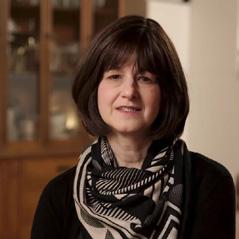 Mrs. Dena Gorkin Principal
Mrs. Dena Gorkin Principal
of Bnos Chomesh Academy high school for girls in Crown Heights
There are a few aspects to a healthy summer experience for teens:
1. Physical care:
It's important to have discussions with our teens about their physical wellbeing in general. Making healthy food choices, getting a form of exercise a few times a week, and getting sufficient sleep are all crucial for maintaining good health.
The one thing that is always an issue for teens working in camp is sleep. In overnight camps, counselors tend to stay up late, getting their campers to sleep, and then stay up even later having afterhours fun. Day camp counselors may be staying up, planning camp activities, and enjoying socializing late into the night. Parents should talk to their teens about the "every other night rule." Make sure to get 7 hours of sleep at least every other night. Lack of sleep can lead to physical illness, emotional dysregulation, and poor judgment in social situations.
2. Emotional wellbeing
Whatever emotional baggage teens have at home and school, they carry to camp. If your teenager is struggling emotionally in a severe

way, camp may not be the right choice for this summer. If your teen has more typical teenage angst that does not interfere with her dayto-day functioning, it's important to ensure that she has a support system she can access even while away. This might include a mashpia, a therapist, breathing exercises, medication, and healthy food choices. It is also extremely important to converse with your teenager about setting healthy boundaries between herself and, her campers and fellow counselors. The most important rule here is not to allow others to share things that make you uncomfortable. If someone is oversharing, let them know that as much as you would like to help them, this is a conversation that you would prefer they have with a trusted adult.
3. Ruchniyus
The Rebbe teaches us that summer is a time when it is easier, and therefore imperative, to work on 'neshama-matters.' Some teens are in touch with their mashpia regularly, while pthers don't have one. Finding a mashpia before the summer is a good idea, but one that can't be forced. Camps can be helpful in this area by asking applicants for counselor
positions to write down the name of a mashpia. Schools and parents should encourage teens to be in touch with their mashpi'im over the summer.
Regarding learning, most camp directors provide shiurim for counselors, and some camps even offer a mashpia-type person who is available to farbreng and speak with counselors. This is another way that camps can enhance our teens' summer experience. Parents can also set up FaceTime learning sessions with their teens. This provides both spiritual nourishment as well as being a creative and noninvasive way to connect with teens while they are away.
Most importantly, parents should stay connected with their teens over the summer, whether by phone, WhatsApp or other means. This, of course, should be done with sensitivity so as not to encroach on the independence we are trying to foster by giving our teens the responsibility of being counselors. By keeping in touch in warm, friendly, and non-intrusive ways, parents can be aware if any issues have come up that need intervention by camp staff, and our teens will experience a wholesome and growth-filled summer!
60 COLLIVE MAGAZINE ADAR II 5784
Teaching With Joy
FROM CHINUCH WITH THE TIMES, M Y MEF.ORG/STORE
To teach with החמש is a tradition that was handed down all the way from אבר, the ארומא who opened each lesson with a joke – a אתוחידבד אתלימ. Humor opens the heart and mind so that subsequent learning has a clear pathway to enter.
In The Educator’s Handbook, Rabbi Hodakov emphasizes the importance of החמש, creating a festive atmosphere in school on special occasions and infusing joy whenever possible. Educational studies reflect this truth: the emotional climate in the classroom is a primary factor in student success.
While infusing a sense of fun and lightheartedness in the classroom community is a valuable goal, a further challenge is bringing החמש into the learning itself. The most effective way of doing this is by demonstrating how much the teacher him or herself enjoys teaching and learning this subject matter, sharing an authentic sense of "קאמשעג" with their students.
How can I add more joy in one of these 3 ways: by sharing lighthearted moments, creating a festive and joyous atmosphere, and conveying my own delight in what I am teaching?
Job Opportunities
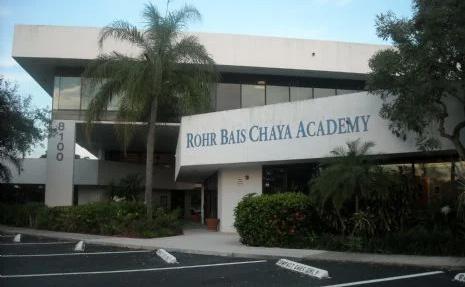
Rohr Bais Chaya Academy in Florida: Teachers to fill a mechaneches role in a warm, Chassidishe high school in Tamarac near Coral Springs. Positions may be available for women and couples.

Cheder Menachem of Los Angeles: Rebbi for a Limudei Kodesh class in a warm and Chassidishe environment and a large Anash community. Some experience is preferred. Very competitive pay. Opportunities for the spouse.
For more information on each job opportunity visit mymef.org/shlichus.

Torah Day School of Houston, TX: Co-director for early childhood. Requirements: Experience in managing staff, passion for early childhood education, and a master's degree in early childhood education or extensive knowledge and experience in early childhood development.
COLLIVE MAGAZINE ADAR II 5784 61
BY ASHARON BALTAZAR

The simple Jewish innkeeper felt out of place in the opulent study yet continued to face his nonJewish landlord, straining to keep his back stiff with attention. The landlord had suddenly demanded his presence, and he couldn’t think of a single reason for the order. He paid the rent, albeit not always on time, and his guests received the best service in the province. The landlord, oblivious to his tenant’s discomfort, reclined in his chair, lost in thought. Finally, he leaned towards the innkeeper.
“Have you ever seen your G-d?”
The innkeeper momentarily lost his bearing. He tilted his head to the side and spoke slowly. “Our G-d cannot be seen.”
As though expecting the answer, the landlord grinned at the bewildered innkeeper. “But I have seen him. And allow me to tell you how.
“You’re probably familiar with the river running through the other duke’s property not far from here. Well, the duke rents a plot of the riverbank to a Jew, too. Because the river is teeming with fish and perfect for fishing, the two have an arrangement requiring the Jew to split his catch with the duke. However, if the Jew lands only a single fish, it belongs to the duke. Think of it as a fishing tax.
“One day during the winter, the Jew secured some bait onto a hook, cast his line into the water, and began to wait. And wait was all he did that day. Perhaps it was the season or the weather, but fish refused to bite. The stubborn Jew stood by the riverbank and watched the gurgling water. As the sun inched closer to the horizon and red and yellow clouds streaked the sky, a mighty tug on the Jew’s pole nearly pulled the rod into the
water. Despite his numb hands, the Jew held on and – heart pounding from excitement – yanked out an enormous fish from the water. It landed on the wet grass, thrashing violently.
“With wide eyes, the Jew beheld its colossal size, dwarfing anything else he had ever caught. He held back giddy laughter. Moving swiftly in the vanishing light, the Jew secured the fish in a basket, packed his things, and raced home. He never did relinquish his sole catch of the day to the duke.
“But this secret was never his alone. Most likely shared by a witness wishing to ingratiate himself to the duke, word eventually found its way to the duke’s ears. Enraged, the duke immediately called for the Jew.
“As soon as the Jew stepped inside the office, the duke rounded on him, spittle flying from his mouth.
62 COLLIVE MAGAZINE ADAR II 5784
PURIM STORY
A

“Did you really think your betrayal would slip by me?! That fish, the largest ever caught in that river from what it sounds, belongs to me, yet you stole it for yourself. I thought we had an arrangement. How dare you violate it?”
“‘Please consider this,’ said the Jew quietly. ‘Have I ever done anything like this to you?’
“‘No,’ gruffed the duke.
“‘There’s a reason. Allow me to explain,’ said the Jew. ‘Surely, you know that we Jews have a holiday called Purim. Our leaders established the holiday after an individual named Haman sought to exterminate every Jew but was then miraculously thwarted…’
The Jew described the origins of Purim in detail, punctuated every so often with a nod from the duke.
“‘Yes, yes, I’m familiar with that story,’ said the duke, waving an
exasperated hand. ‘What is your point with all this?’
“‘Well, this story happened on Purim eve. I spent the whole day attempting to catch something for this important holiday, but nothing was biting. Around sunset, just as I thought about heading home empty-handed, I managed to hook this fish. Put yourself in my shoes. Per our agreement, the fish belonged to you, but commemorating our holiday was my burning desire. And so I took the fish for myself–’ the Jew added quickly as the duke’s nostrils flared without warning ‘– but not without reimbursement! I vow to double –no, triple! – whatever I catch in the future…’
“And so the Jew attempted to mollify the duke, pinning the rationale of his rash decision on Purim’s significance. The duke, unimpressed by the Jew’s justifications and promises of more fish, remained stony-faced.
“‘Get out of my sight,’ spat the duke suddenly.
“The Jew scampered for the door, leaving behind the duke to simmer in irritated anger.
“Now,” continued the landlord to his Jewish innkeeper, who leaned ever closer, “you must be familiar with our annual summit. In a large hall, dukes from all over the province confer on the latest issues. Topics vary from year to year and typically center around business, but this time, the question of Jews, specifically the Jewish innkeepers, uncovered a festering resentment.
“One stood and described his innkeeper’s antics in dastardly terms. The crowd recoiled in disgust. Another fellow followed with a similar story, painting his Jewish tenant as a conniving wretch whose only purpose in life was swindling dukes. At some point, our duke felt it necessary to convince
the whole group how a Jew robbed him of a beautiful fish and instead cooked it to honor his holiday. It was all obvious exaggerations, but no one cared. An avalanche of distorted stories buried the summit’s original ambitions in acidic hatred. Slandering Jews was the only agenda now.
“Their crimes demand retribution! Banish the Jews from all properties and never allow them to return! Some of the dukes with legal knowhow drafted a legislative document calling for an immediate expulsion of the Jews, reserving ample blank space for everyone present to embellish it with an elaborate signature. An inkwell was prepared alongside a collection of recently sharpened quills. Within the dukes’ esteemed circles, the signing process began with the highestranking members and proceeded in descending order of importance.
“The ornate doors of the hall swung open, and the sudden appearance of a man prompted the sound of chairs scraping across the floor. A thick silence enveloped the crowd. Everyone had stood out of respect for the stranger marching across the room. He was dressed in expensive clothing and adorned with exotic accessories. His face shone like burnished copper. He made his way to the head of the table, where the dukes promptly vacated a seat for him, and settled in a plush chair. He radiated authority.
“Several dukes exchanged nervous looks and leaned over to speak to the man in undertones. They recounted the crimes of their Jewish innkeepers and outlined their plan to exile every one of them. After a bit more discussion, someone snapped their fingers, and the official document quickly exchanged several hands before finally being placed in front of the guest. The inkwell then followed, and lastly, a fancy quill. One of the dukes
COLLIVE MAGAZINE ADAR II 5784 63

gestured at the paper, inviting the man to be the first to sign the document.
“The man studied the proposal on the table. As his eyes ran back and forth along the page, the faintest shadow of annoyance appeared on his face and gradually deepened into a scowl. The air of anticipation in the room, so electrifying just minutes ago, shriveled up like a dying plant.
“‘What do you think this is? Some sort of a game?’ he boomed at the pale faces around him, jolting everyone into the air. He shook the document in an angry fist. ‘These crimes have never happened, at least, not as you describe them, and at the very worst, like the story with the fish. It’s worth mentioning the uncomfortable but indisputable truth that we will never succeed in punishing them! If we slap them with decrees, the Jews only benefit from it. Miracles continue to save them. History repeats itself, you fools, and instead of one Purim to celebrate, they’ll have two!
“‘My suggestion is not to sign this document at all!’
“The man picked up the document and, ignoring the gasps and the dukes’ bulging eyes, tore it in a few swift motions. The pieces fluttered from his hands. Meeting the aghast expressions around him with an impatient glare, the man stood up and exited the hall.”
The landlord paused his story to
catch his breath.
“As a witness of the events from beginning to end, I was left speechless. Such a strong response from such a distinguished summit member! He spoke with such compelling vindication. Incredible. After recovering somewhat from the shock, I allowed myself to admit I had no idea who this individual was. The whole room rose to its feet when he entered, so he was obviously well-known by everyone except for me. I didn’t dare ask anyone around me, feeling too embarrassed to stand out as the odd one. Would I risk being labeled as an ignoramus living under some rock?
“My curiosity refused to relent and pushed me through the chattering crowd, where I hoped to find one of my close friends. Thankfully, I was relieved to see someone particularly trustworthy and made a quick beeline for him. I muttered my question out of the corner of my mouth.
“But he just sighed! Affording me a meek smile, my friend muttered back that he didn’t recognize the summit’s mysterious guest either. Nor did he have the gall to ask anyone. I felt a modicum of relief, but now, my curiosity burned ever stronger. We met each other’s eyes and set out to find a third acquaintance. I assumed we’d have our answer before long, though, well, things only became
increasingly strange. People responded to our question with a blank stare or a small shrug. When pressed, they admitted to wanting an answer but didn’t wish to appear foolish, so they suppressed the thought. I felt the onset of madness. Who was this man? My absurd obsession with pride no longer mattered, replaced by a desperate urge to find the slightest lead. Within a short time, we uncovered nothing but a frightening reality!
“No one, not a single living soul in the room, knew the man or anything about him. He was a stranger, and, perhaps, with some prodding from one of the dukes, his ruse would’ve been exposed. Our fragile egos granted this mysterious guest the highest honors and provided a platform for him to tear our document to shreds before our faces!”
The landlord’s voice shook with emotion, but he wore smug satisfaction on his face, convinced he had presented his Jewish tenant with irrefutable evidence.
“Answer me this one thing. Is this not your G-d? If it is indeed, well, I have seen him with my own eyes!”
No doubt, the merit of serving the finest fish for Purim, even under the threat of punishment, protected the Jews that year.
(Likkutei Sipurim, Page 474)

64 COLLIVE MAGAZINE ADAR II 5784

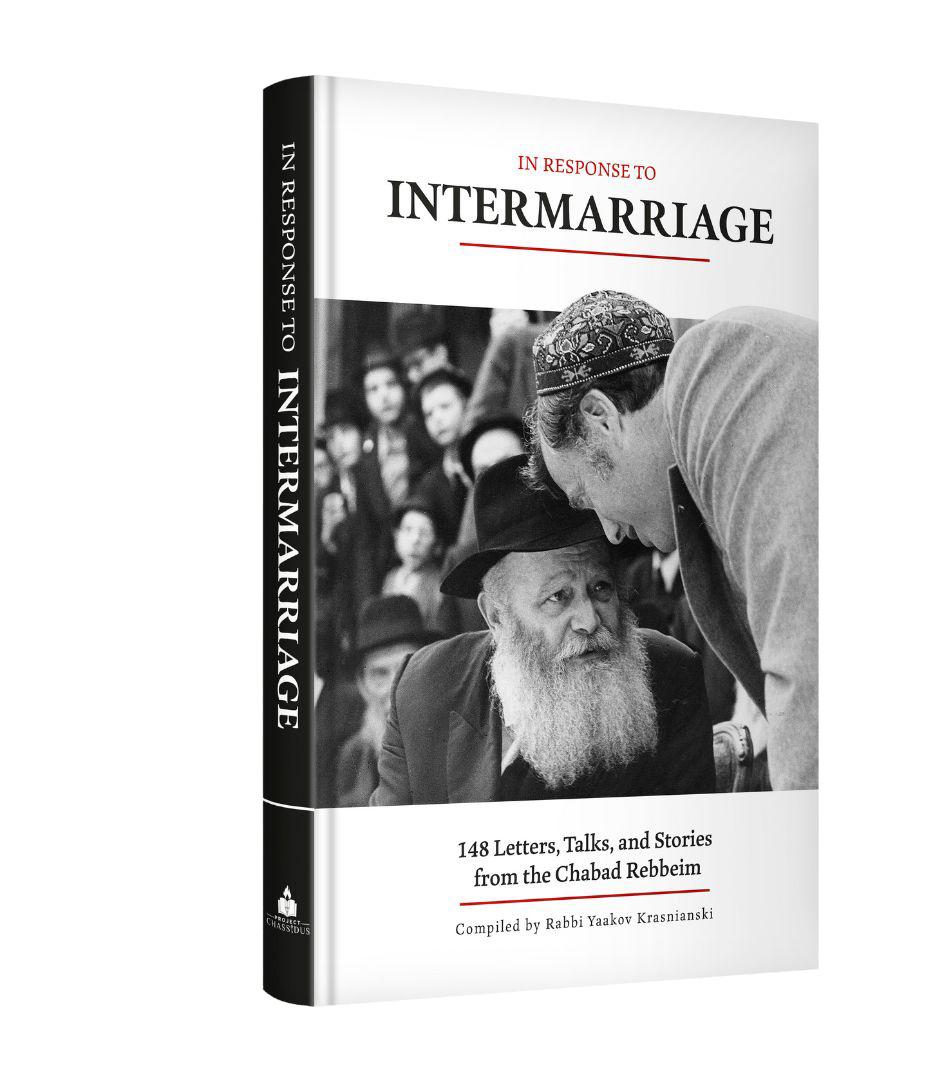
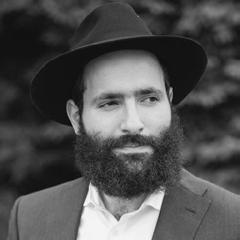
Meet the Author RABBI YAAKOV KRASNIANSKI
In response to Intermarriage: The Rebbeim’s stance on the critical subject of intermarriage
By Esther Rodal
Can you give us a brief description of what the book is about?
The book is a comprehensive compilation of everything we have from the Rebbeim on intermarriage. It consists mainly of letters with a section of stories as well as sichos on the subject.
What inspired you to write this book?
It was a combination of a few things. It began when I was giving a class on intermarriage and was struck by how little content there is available. With intermarriage being a major issue facing am yisrael - over seventy percent of Jewish marriages are intermarriages - the lack of information was startling!
Another big influence is the fact that I grew up on shlichus and therefore saw this issue up close and frequently.
Around the time I decided to go ahead and write the book, there was a guy who started coming to the Chabad house. He grew up totally secular, in a very left-wing secular Kibbutz in Israel, which had no Jewish influences. Then, he met a non-
Jewish American woman, married her, and had two kids. Only recently, he started coming to Chabad, where he fell in love with yiddishekit and started coming closer and closer. Now he’s stuck in a very difficult predicament, because his wife has no interest in converting.
One thing he kept saying to me was that no one in his community or family had ever warned him against intermarriage. As was the case with this individual, many intermarriages happen out of ignorance of the seriousness of the matter. If we properly educate people about it, there is the potential to prevent countless intermarriages.
What was the process of writing the book?
It all came together piece by piece. I have always enjoyed researching and compiling information, so I did some preliminary research on the topic and what I found was really striking, with things I had never seen before. As I exhausted one source, I became aware of another whole swath of information and continued to explore that.
From start to finish the whole process took a year and a half. Is there a specific part of the book that stands out to you?
A few points come to mind.
The Rebbe was talking at a time when the intermarriage rates were much lower than they are today, and yet he spoke about intermarriage like it was an emergency crisis. He referred to it as a war, saying that those who are in a position to fight the battle are like soldiers who are forbidden to abandon their posts. Just as we must protect our physical borders to preserve the safety of our land, so too every person has an obligation to man the frontiers of the Jewish people.
After a terrorist attack occurred in Israel in which terrorists had crossed through a tunnel from Lebanon, the Rebbe said something extremely jarring; that the crisis of Mihu Yehudi had undermined the border that exists between Jews and non-Jews, and that physically manifested in our enemies being able to infiltrate our borders.
Definitely, the most recurring point in the book is the perspective from which the Rebbe argues against intermarriage. He doesn’t make the same philosophical arguments that most people do about Jewish continuity and the golden chain. Rather, he makes the point again and again about jeopardizing the current and future happiness of the intermarried couple.
What has the response to the book been like so far?
It’s been quite incredible, and b”h it’s already almost sold out.
I intended the book to be a resource for shluchim to fight intermarriage in their communities and there has been amazing feedback on that end.
Recently, the book reached the renowned philanthropist Mr. George Rohr who liked it so much that he wrote an endorsement letter and sponsored 300 copies to be sent to all the campus shluchim.
One of the shluchim in Manhattan chose this book as his annual gift and handed out about 200 copies to his donors - secular individuals - who were very positive about the book. It goes to show how the Rebbe’s words can resonate with all people and we shouldn’t be scared to say the truth.
What are you hoping the book will achieve?
I’m hoping this will awaken a fire in people and open their eyes as to how important fighting intermarriage has to be. I’m hoping it will give people strength and courage to take a more active stand against intermarriage and not look the other way.
Down the road, I hope to do similar things in the future: Explore various topics with difficult subject matters; gather all the information available and present it in a clear, unbiased form. Many people don’t have the means to find this material on their own and this should not stop them from accessing the truth.
Rabbi Yaakov Krasnianski was born and raised in the Upper East Side of Manhattan. He is a Cheder teacher, and spends the rest of his time writing and researching. In Response To Intermarriage is his first published book.

COLLIVE MAGAZINE ADAR II 5784 67
If There�s a Will...
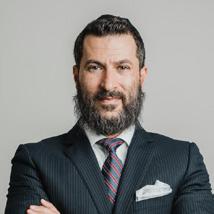
Zaki Tamir, Esq. leads the way in hassle-free estate planning
By Libby Herz

Imagine a scenario where a family, already grappling with the emotional toll of losing a loved one, is further burdened by legal battles that stretch over the years. This is an unfortunate reality for many families who neglect to plan their estates. Zaki Tamir, Esq. has witnessed firsthand the emotional and financial toll it takes on each family member.
The absence of a comprehensive estate plan can lead to legal chaos, exorbitant fees, and crucial omissions like a medical proxy.
Tamir, a tax lawyer and long-serving chairman of the Crown Heights Va'ad Hakohol, is committed to clarifying the process of a kosher will, trust, power of attorney, and medical proxy.
Tamir and his team at Cambridge Tax and Estate Corp. aim to empower families, ensuring that their legacies and values are safeguarded through kosher wills, trusts, and estate planning, preserving Jewish families for generations. Not only that, he does it in a way that is easy and hasslefree. "Our services offer relief and a straightforward process at a very low cost," Tamir says.
A Family Priority
"Estate planning isn't just a luxury for the wealthy; it's crucial to ensure your assets are handled according to your wishes," Tamir
says. "Estate planning secures your legacy and spares your loved ones unnecessary financial burdens. The different experiences of the two families below underscore the significant impact that estate planning, or the lack thereof, can have on their financial outcomes."
As an example, he cites Howard Hughes, a towering figure in aviation, filmmaking, and business during the mid-20th century.
Hughes amassed a fortune estimated between $1.5 billion and $2 billion at the peak of his career. Hughes had one critical oversight despite his immense wealth – the absence of a clear estate plan.
When Hughes died in 1976 without a valid will or specific instructions regarding the distribution of his assets, his family faced many challenges. The lack of comprehensive estate planning resulted in prolonged court proceedings, substantial legal fees, and a significant reduction in the family's inheritance. His multibillion-dollar fortune became entangled in legal complexities, leaving his heirs with a fraction of the wealth Hughes had accumulated over his lifetime.
On the flip side, Tamir gives the example of a well-known musician who had a well-structured estate, including trusts, ensuring minimal taxes and legal hassles. The bulk of his wealth smoothly transitioned
to his wife and heirs without the public scrutiny of probate court. Every cent he earned during his lifetime went directly to his family.
He says that the result of an uncertain plan for passing on wealth leads to legal issues, fees, and less inheritance. Conversely, a solid plan minimizes taxes and legal problems, making it easier to pass on wealth to the family.
Kosher Wills
Unfortunately, the sudden demise of the head of the household often thrusts a family into legal battles that can last years when family members see eye-to-eye and even longer when there are disputes. Without a comprehensive estate plan, families find themselves entangled in legal complexities, leading to prolonged court battles and exorbitant legal fees. Often, this causes strained relationships among family members. Fortunately, trusts and kosher wills avoid this mayhem and provide immediate clarity for loved ones.
Tamir, together with Rabbi Moshe Bogomilsky of Crown Heights, delved into the Rebbe's letter about wills and discovered that specific wording nuances can have a tremendous impact on making the will kosher and halachically sound.
Tamir says that once such a letter from the Rebbe formed the
68 COLLIVE MAGAZINE ADAR II 5784
foundation of his endeavor. "The Rebbe's wisdom emphasizes providing for all children - boys and girls - equally and outlines a halachically sound approach to eliminate potential issues," he says.
Building upon this concept, Tamir's expertise in crafting a halachically sound plan distributes assets and provides clear guidance on managing various holdings, bringing peace of mind and financial security when families face uncertainties about the future. This approach ensures that the document aligns with legal requirements and halacha under the Rebbe's guidance.
A Brief Guide for Beginners
A trust is essential to help manage money and pass it on to the heirs smoothly once a family has accrued $2 million in assets. Trusts eliminate the complicated court process with wills, making the process faster and less costly. Trusts save on taxes, protect assets, and ensure that the assets go to the intended beneficiaries according to the grantor's wishes. Without a trust, a person's inheriting descendants might have to pay a lot of taxes—up to 40% of what they receive, depending on the state.
Trusts transfer out of your name during your lifetime, so the transition is seamless when you've passed on. Wills, on the other hand, keep everything in the name of the person who passed away, so heirs are forced to deal with the courts. Trusts also keep things private, while wills can be viewed by anyone who views court records.
A trust lets you plan things just the way you want for your family's future. Each trust can be personalized with specific
instructions, conditions, and contributions to your desired tzedakah causes.
Trusts not only protect assets but also let people plan their wealth and legacy in a way that suits them best. Zaki Tamir helps find an expert attorney for each individualized trust - depending on the state and jurisdiction - and you can add special instructions or conditions in the plan.
The Importance of Medical Proxy
Cambridge Tax and Estate Corp. also assists in preparing a vital document known as the medical proxy. A medical proxy designates an individual to make medical decisions on behalf of an incapacitated person. Without this document, doctors are free to make any decision without the consent of family members. They do not need to consider the incapacitated person's known wishes or best interests unless otherwise recorded or through the court's authority.
A medical proxy ensures family members can legally make important medical decisions for their loved ones. It takes their instructions and preferences into account. Unfortunately, this document is often overlooked, and its absence can cause much otherwise avoidable difficulty.
"Creating a kosher will is not a unilateral decision; it's a collaborative process that begins with understanding your unique vision for your estate," Tamir says. He guides each client through consultations, delving into the specifics of their financial holdings, family dynamics, and overarching goals. His role as a guide is about understanding each family's unique dynamics and providing solutions
that resonate with their values and goals.
Exploring family values forms the foundation for each estate plan. By assessing finances and addressing family dynamics, Tamir tailors solutions to ensure a seamless transfer while fostering family harmony. Questions are welcomed, and understanding is paramount. In the end, your kosher trust will stand as a testament to your foresight and commitment to the well-being of your loved ones.
Cost Structure
Given the uniqueness of each case, costs may vary. Estate planning documents are priced reasonably, with wills available for as low as $950. Depending on the type, trusts range from $2,600 to $3,200. Essential documents like Powers of Attorney and Medical Proxies are priced between $100 to $200 each.
Considering the importance of these documents in securing one's financial future and ensuring a smooth transition of assets, these costs underscore the simplicity of effective estate planning.
Cambridge Tax and Estate Corp. currently serves New York, New Jersey, Connecticut, Massachusetts, Florida, and California, and Tamir envisions taking this campaign nationwide. He says he is dedicated to minimizing conflicts and legal expenses, and his vision empowers families, fostering financial security and harmony. As families contemplate securing their future, Tamir invites them to embark on this transformative journey, ensuring economic security and harmony.
For more, call 1.855.GET.A.WILL, or visit www.855GetAWill.com.
COLLIVE MAGAZINE ADAR II 5784 69
Business Digest
PRESENTED B Y COLLIVE & CROWN HEIGHTS Y OUNG ENTREPRENEURS (CH Y E)
By Zev Gotkin
TOP BOTTLES IN CROWN HEIGHTS








Smirnoff
Glenlivet
Casamigos
Don Julio
Barcadi
Tito's
Ketel One
Hennessy
What is your best-selling bottle of liquor?

W INE BY
THE CASE Glenlivet scotch

EBER’S Smirnoff Vodka

PROHIBITION WINE AND LIQUOR
Don Julio Reposado Tequila
“It is only natural that when a business is (1) successful and (2) expands to new locations, others are motivated to do the same and compete, etc. The only person who has no competitors is a shlimazel, may Hashem preserve us.”
THE REBBE HEICHAL MENACHEM VOL.
Mark your calendars
These are some business and networking events in the New York area and the Jewish world you do not want to miss.
CHYE Webinar: Customer-Centric Design presented by Shaul Nemtzov of Who & What Design Classes start Wednesday, March 13 at 2 pm on Zoom WWW.CH Y E.INFO
Monthly Marketing Meetup
Wednesday, March 13th, 5:00 pm ON ZOOM
Intentional Networking hosted by Living L’chaim, ERN, & BYND
Keynote Speaker: Mitchell Eisenberger, President & Founder ECH Ventures
Tuesday, March 5th, 2024 at 7:30 pm in the 5 Towns of Long Island at Bais of Inwood, 259 Doughty Blvd, Inwood, NY 11096
EVENTS.HUMANITIX.COM/INTENTIONAL-NETWORKING
70 COLLIVE MAGAZINE ADAR II 5784
2, P. 88
 Nussi Sternberg Owner of Greenhill Trading
Nussi Sternberg Owner of Greenhill Trading
Competition or Opportunity?
A QUESTION TO THE MENTORS
How do you view competition in business and what are some things you do to remain competitive in your industry?
COMPETITION IN BUSINESS ACTS AS A catalyst for innovation. To stay ahead, we place a strong emphasis on hiring top-notch talent, making wise investments, keeping up with the latest technology trends, focussing on what we do best, and always putting our customers' needs first. These strategies enable us to tackle industry challenges head-on and maintain our commitment to excellence.
Gabe Guilis Managing Member at United Pacific Brands
Sometimes the right way to handle competition is not to try to beat them, but to join them!
We often explore strategic partnerships and find ways to collaborate with some of our competitors. For example, a big brand in my industry recently gave us exclusive rights to sell their brand on Amazon. Being the only Amazon seller carrying this in-demand brand now gives my company a competitive advantage.
Some people try to beat their competition. Others shy away from competition because they think they can’t compete. I say, look for creative ways to collaborate with your competitors when you can and explore mutually beneficial opportunities such as white-label or wholesale/retail partnerships.
Yitzy Geisinsky Founder & President of Alacrity Energy
COMPETITION IS A CLEAR INDICATOR THAT there's a demand for your product or service. Embrace this competition and carve out your unique space in the market. For instance, competing with giants like Amazon and Walmart on price and variety might be impossible, but you can excel by offering a more personalized shopping experience, strategically locating your business closer to your clientele, or specializing in niche products. These principles apply equally to service businesses.
Effective competition isn't about mirroring what others are doing; it's about focusing on what they are NOT doing. Just make sure that your business model caters to a broad enough market segment to remain relevant and profitable.
Staying on top of industry trends and adjusting accordingly is crucial. Yet, as you navigate these changes, it's important to continually preserve the unique qualities that differentiate your business from your competitors.
Remember, competition usually means you're offering a product or service that is in demand. So embrace competition. Differentiate yourself as much as possible by focusing on specific subsections within your industry yet keep it broad enough to remain relevant and profitable.
Interested in getting more business advice like this? Level Eight Mentorship provides mentorship for founders in their business journey. Visit level8.org
COLLIVE MAGAZINE ADAR II 5784 71
My take on PSY
CHEDELICS
A therapist shares his view on a hot topic in today’s world: the use of psychedelics for treatment
Are psychedelics a good idea?
By Rabbi Daniel Schonbuch, LMFT
That’s a question many of my clients who are 30 years or younger often ask me in my office. I understand why. This is a very hot topic that one cannot avoid listening about it on countless podcasts and by social media influencers. Psychedelic drugs are also an enticing topic since many of these substances are illegal but are now touted as “cures” for mental illness. The answer to my clients, and one which I will share with you is a bit complicated, so give
me a few paragraphs to explain my position.
Around seven years ago before the psychedelic craze began, I was dealing with two different clients, one a 50 year-old w who had suffered depression most of her life and was in a terrible marriage. She did not respond to most of the medication she had tried, including drugs like Lexapro, Abilify, and even Risperdal. These drugs range from “light,” to what I would consider quite “heavy” which are usually reserved for more serious cases.
Unfortunately for her, nothing seemed to work. I consulted a physician who I worked with who suggested that she try a drug called Ketamine. At first I was suspicious, but I recommended it based upon my colleague's suggestion. The suggestion also came in the backdrop of the FDA allowing Ketamine to be used via a nasal spray as a treatment for depression.
The client could only find one place in New York that would give her the Ketamine. This clinic was run by an
72 COLLIVE MAGAZINE ADAR II 5784
anesthesiologist who found a new niche in his practice. She went in for around six treatments, and that was it. During the treatments she went into semi-conscious states as the anesthesiologist delivered it to her intravenously.
Around the same time, I was seeing another client of mine who was 40 years old and suffering from what I would deem as long-term resistant depression, had trouble getting married, and also had debilitating social anxiety. I recommended to him to try Ketamine as well. At first he was resistant, but in the end he tried it for four or five treatments that were recommended by the anesthesiologist.
After about one month I was amazed to see that both of these clients started to feel much better, and for the first time, their long-term conditions seemed to improve. Not only that, but both their relationships improved and my male client got engaged. From my perspective, these were therapeutic breakthroughs.
I had been trained that the only real medical treatments for conditions like depression, or PTSD, were SSRIs, or what are commonly known as antidepressants. So my client’s reported gains truly dispelled my misperception of these types of drugs. and overtime I became more willing to recommend drugs like Ketamine to my clients.
Here is the big “however”. When I speak about the legitimate use of drugs like Ketamine, I’m referring to treating more severe forms of depression or to the levels of trauma that we are seeing in the war in Israel, or someone who experienced significant physical, emotional or sexual abuse. However, what I have seen over the last five or so years is that drugs like Ketamine, mushrooms,
LSD, and Ayahuasca have become trendy. They are no longer being suggested just for individuals who truly need, but for those who struggle with problems of less intensity. This would include individuals who struggle with minor anxiety, ADHD, boredom, or what Viktor Frankl would call an existential crisis (not knowing who they are).
What I find most interesting, and the public would not know this, is that over the last few years there has been a tremendous push for therapists like myself to assist people in administering Ketamine therapy. One such company whose training I attended and certified with was willing to give ketamine lozenges to just about anyone who I felt needed them.
My suspicions arose when I received an email from this company asking me if I would like to try Ketamine! That would be like a cardiologist being asked to just “try” a heart medication that they give to their clients. I don’t think anyone trained in cardiology would ever try drugs they prescribe, unless they would need them. From my perspective, traditional pharmaceutical companies that are criticized for caring about their profit margin have just been replaced by new pharmaceutical companies and organizations who see the potential of massive profits from psychedelics.
I’m also concerned that there are many people who may suffer from much less severe forms of depression anxiety that could be helped if they would see the right psychiatrist who knew how to prescribe medication tailored to specific to their needs, or a well-trained therapist who could help. There are many powerful treatments that I use that can help conditions like depression, anxiety, or PTSD such as
Somatic Experiencing, IFS, or the Logotherapy of Viktor Frankl. I also believe that there are certain spiritual therapies, where a person could experience different levels of elation without using any drugs whatsoever.
Finally, readers need to know that there can be serious effects related to the use of psychedelics including:
Bad trips – Psychedelic drugs can cause users to have terrifying experiences. These bad trips can lead to anxiety, paranoia, and even suicide.
Flashbacks – Some people who take psychedelic drugs can have flashbacks. This effect means that they will suddenly and unexpectedly experience the effects of the drug again, even if they are not taking it.
Psychotic episodes – Longterm use of psychedelic drugs can cause psychotic episodes. Psychotic episodes cause users to experience delusions, hallucinations, and paranoia.
Before trying any psychedelics, I highly recommend first trying a few rounds of therapy, to see if your therapist is your “shaliach” for healing. If that is not successful, I would then progress to trying more serious medications such as antidepressants, antipsychotics, or psychedelics.
Rabbi Daniel Schonbuch, LMFT, is a licensed therapist and the owner and director of MyTalkPlace. com that offers therapy with frum therapists for the Jewish community. He is the author of several books on therapy including: Think Good and It Will Be Good: Spiritually-Based Therapy Inspired by Viktor Frankl and Jewish Wisdom available on amazon.com.
COLLIVE MAGAZINE ADAR II 5784 73

Baby bites
Tips for navigating your toddler's transition to solid foods
By Dr. Avraham Gottesman
Starting to feed your baby real food is one of the great joys of parenting; watching them respond to new flavors and textures with surprise and delight is a treasure to behold. Nearly all babies are ready to start eating "solids" at around 4-6 months of age. Doctors nevertheless recommend waiting until closer to 6 months, particularly in babies who are exclusively breastfed. At first, eating is "just for fun" and makes up an insignificant part of the baby's diet. Little by little, as they start eating more, it begins to take over the bulk of the diet.
Usually, making the transition from breastmilk or formula to a typical toddler diet is smooth and uneventful. However, there are two areas that deserve special attention: choking hazards and food sensitivities.
Almost all foods are safe to feed little children, but sometimes, they can pose a choking hazard. For example, pureed fruits and veggies are okay, but pieces of apple can be a problem. Nuts and raisins are also not ideal foods to start with. On the other hand, a baby might gag even on pureed sweet potatoes. As long as caution and common sense are used, you should be okay.
With regard to food allergies, the guidelines have been loosened over the past few years. In the past, it was thought that dairy or peanut products could lead to an increased risk of developing allergies for children under one year old. More recently, it has been established that the opposite is true; early exposure to peanuts, dairy, and other allergenic foods actually decreases the risk of allergies. (From personal experience, I've seen the number of children with severe allergies or eczema decrease dramatically over the past 10 years.)
The one important exception to this rule is "atopic" infants who have a high risk of allergies, eczema, and asthma. Babies with a family history of allergies or babies who show a sensitivity towards eczema are also included in this exception. In these cases, a pediatrician should be consulted, and allergy testing may be necessary. The only food to absolutely stay away from until one year old is honey.
The amount of nursing or formula stays the same as the amount of food increases, but the frequency of feedings is less. At about 10-12 months, the volume of nursing and formula can be lessened, and once
a baby turns one year old, formula is rarely necessary, and nursing can become secondary to real food. While some mothers nurse beyond a year, it is unlikely to replace three meals daily. Baby formula is almost never needed after a year and is not recommended.
Parents often ask which drink should replace formula or breast milk after a baby turns one. The truth is that plain water is just fine, but if cow's milk is used, it should be limited to 16 oz a day. Fruit juice should be given in small amounts and preferably watered down.
As always, every rule has exceptions, and a pediatric practitioner should be consulted for individual recommendations.

Dr. Avraham Gottesman received his MD from Albert Einstein College of Medicine and trained in pediatrics at LIJ. He has been serving the Crown Heights community for the past 15 years. He leads an experienced team of PAs and nurses at his office at 555 Lefferts Ave. He is available for questions or suggestions for future articles on WhatsApp at 718-794-0503

74 COLLIVE MAGAZINE ADAR II 5784




INTEREST-FRE E SMAL L BUSINES S LOAN S FOR NE W YORK CITY Startups • Expanding Businesses • Storefronts • Home-Based • Men/ Women Owned Get a loan up to $50,000 No Interest. No Fees. Ever. Restrictions apply. TWO GUARANTORS MAY BE REQUIRED. The Hebrew Free Loan Society provides interest-free business loans to low-and moderate-income residents of New York City. Find out what HFLS can do for you: 212.692.9023 • biz@hfls.org WWW.HFLS.ORG SOMETIMES ALL A BUSINESS OWNER NEEDS TO SUCCEED IS A HELPING HAND LET US LEND YOU A HAND. An initiative of the Hebrew Free Loan Society in partnership with Crown Heights Young Entrepreneurs

A Purim’dikeh Niggun Yaakov
by Rabbi Yossi Lipskier – Sherman Oaks, CA

Purim is an especially joyous Yom Tov. The megillah itself describes the day as החמשו התשמ םוי, a day of feasting and joy1. This was true always, but was especially so in Chabad, where Purim was marked as an extra special day. It was one of the few days a year when every Rebbe would farbreng with his Chassidim, with many tremendous giluyim taking place at these farbrengens.
This festive mood is also reflected in the Chabad niggunim connected to Purim. The tunes are especially joyous and communicate the spirit
of עדי אלד דע
Throughout the generations, a number of Purim’dikeh niggunim were set to the words of Shoshanas Yaakov, the paragraph we recite after reading the megillah:
The rose of Jacob thrilled with joy
and exulted when they beheld Mordechai garbed in royal blue. You have always been their salvation, their hope in every generation, to make known that all who place their hope in You shall not be put to shame, nor shall all those who trust in You be disgraced forever. Cursed be Haman who sought to destroy me; blessed be Mordechai the Jew. Cursed be Zeresh the wife of [Haman] who terrified me; blessed be Esther who [interceded] on my behalf. Cursed be all the wicked; blessed be all the righteous; and may Charvonah also be remembered favorably.
76 COLLIVE MAGAZINE ADAR II 5784
Niggun ofthe Month
The first part of the paragraph is the end of a longer poem known as אינה רשא, which was written by the Anshei Knesses Hagedolah (of which Mordechai Hatzaddik was a member). Like most piyyutim, it follows the order of the Alef-Beis, summarizing the megillah in poetic style. The beginning of Shoshanas Yaakov makes up the last two stanzas of the piyyut (תנשוש begins with a shin, and םתעושת is the tav). The end of the paragraph is not part of the poem and was added based on the ruling of Chazal2 that we should mention these curses and blessings on Purim.
The First Niggun
The earliest composition on Shoshanas Yaakov is attributed to the Chassidim of the Alter Rebbe. Some say3 that the niggun was originally composed during the celebrations following the geulah of the Alter Rebbe on Yud Tes Kislev. At the time, the words were changed to match the occasion, דחי םתוארב החמשו הלהצ םידיסח תנשוש ר”ומדא תלכת etc., and later it was adapted to fit the regular nusach as well. R’ Shmuel Zalmanov writes4 that a choir of bochurim would sing this niggun in Tomchei Temimim every Purim and Yud Tes Kislev.
At5 the end of the farbrengen on Shabbos Tetzaveh (Zachor) 5740, the Rebbe instructed the Chazzan R’ Moshe Teleshevsky to lead the crowd in singing Shoshanas Yaakov. Rabbi Teleshevsky didn’t know any niggun to those words, so the Rebbe asked “where is his םוקמ אלממ?”, and then turned to R’ Yoel Kahn and instructed him to sing. R’ Yoel sang this version of the niggun from the Alter Rebbe’s Chassidim. The Rebbe sang along with the Chassidim while looking at the words inside his siddur.
The next day, at the end of the Purim farbrengen, the Rebbe again
asked that the Chassidim sing Shoshanas Yaakov. This time, R’ Yoel Kahn began the niggun right away, and the Rebbe again sang along6 .
The Victory March
A second Niggun to these words7 was composed by R’ Sholom Charitonov8. In 5733 (1973), R’ Sholom’s son R’ Shamshon9, released a record called “Niggunei Sholom”, where he recorded many of his father’s niggunim, including his Shoshanas Yaakov. On the record jacket, there appears a brief explanation for each niggun (written anonymously). The following is a quote from the explanation to Shoshanas Yaakov: “The theme represents a victory march from the battlefield. The triumph is manifest in two opposite areas: Freedom of the innocent, and destruction of the guilty. As the Chassid chants this melody, he “relives” and recognizes the content of the “Shoshanas Yaakov” hymn. The exuberant joy over the total Jewish conquest (in the Purim saga) is due to “their seeing the blue cloak of Mordechai (the Tzadik)”, “who confide in you” (Hashem; representing their attachment to the Spiritual Leader of the generation, and their confidence in Hashem), which ultimately resulted in “cursed be Haman” and his associates, and “blessed be Mordechai” and his associates.”
The Niggun from Eretz Yisroel
There is a third niggun to the words of Shoshanas Yaakov, which was first heard in Kfar Chabad from R’ Moshe Baitsch10, during a Purim farbrengen at the home of R’ Shneur Zalman Garelik11 .
R’ Elye Rivkin12 was present at that farbrengen, he learned the niggun and later publicized it. It’s a very complex tune, and begins with the text of v’al hanissim for Purim, concluding with Shoshanas Yaakov13
1. Esther 9:18, 22.
2. Yerushalmi Megillah 3:7. Maseches Soferim 14:6. See Tur and Shulchan Aruch Orach Chaim 690:16.
3. Heichal Neginah – Introduction to this niggun. I was unable to find another source for this.
4. Sefer Haniggunim Niggun 54.
5. The material in this paragraph was compiled from the ונייח תיב ןושדח (Adar 5740) and the diaries of R’ Michoel Seligson and R’ Hirshel Raskin, who were present at the Farbrengen.
6. Watch here: https://videos.jem.tv/video-player?clip=1883. As far as I was able to research, the Rebbe asked for Shoshanas Yaakov to be sung only one other time, at the beginning of the farbrengen on Shabbos Shushan Purim 5737 (Sichos Kodesh 5737 vol. 1 p. 508). It’s unclear which version of the niggun was sung on that occasion.
7. Printed in Sefer Haniggunim Niggun 231.
8. R’ Sholom Charitonov of Nikolayev (56465695; 1886-1935) was a devout Chossid and a talented Baal Menagen. He was beloved by the Rebbe Rashab and the Frierdiker Rebbe, and many times he would lead the Niggunim at their Farbrengens.
9. R’ Shamshon Charitonov (5679-5770; 19182009) was a tremendous Baal Menagen. After escaping from Russian in 5707 (1947), he settled in Crown Heights. He merited to lead Niggunim by the Rebbe’s Farbrengens, and to play an integral role in the production of the Nichoach records.
10. R’ Moshe Baitsch (5677-5759; 1917-1998) was a Chabad shochet, and one of the earliest Chassidim to settle in Kfar Chabad.
11. R’ Shneur Zalman Garelik (5640-5734; 18801974) was one of the first students in Tomchei Temimim and the first Rov of Kfar Chabad.
12. R’ Eliyahu Leib Rivkin (5686-5743; 1925-1982) was a well known Baal Menagen who lived in Kfar Chabad.
13. In recent years this niggun gained popularity when it was recorded by the “Kapelye” choir in Crown Heights.
COLLIVE MAGAZINE ADAR II 5784 77
Bby sruly meyer
the inside track..,..
Mach a Shmueli
Shmueli Ungar is looking to reintroduce himself to the Jewish music world with his newest album, the fourth of his career, “Shalom Aleichem Shmueli”. COLLive sat down with him for a conversation about what fans can expect to hear in this exciting new release.
Sruly: When we began to discuss marketing for this new album a few months ago, you suggested that we delete all of your previous social media posts ahead of its release. What did you want to accomplish by doing this?

Shmueli: My goal with the album is to introduce myself to the world as if it was their first time hearing me. Of course, I’m very proud of everything that I’ve done until now, but I’m also here to say Shalom Aleichem - nice to meet you. I wanted that message to also come through on my social media.
Sruly: Were people surprised by this?
Shmueli: I got a lot of messages from people asking me if I was hacked, but I just sent them a handshake emoji, as if to say, Shalom Aleichem. Of course I was trying to be silly, but in a way, it’s the truth - we’re starting something new.
Sruly: What is something really special that you want people to know about this album?
Shmueli: I’m excited to share that this album is the first one that I produced entirely by myself. It was a big change for me, as I have worked with many talented producers in the past, including my good friend Naftali Schnitzler who produced my previous albums.
What prompted you to make that move?
It had nothing to do with the music producers, and everything to do with how I wanted my music to be expressed; not just in my vocals, but in the sound, pitch and pace of it all. Making this change was about
truly finding my voice as a creative artist and allowing it to express itself in every aspect of the music. Shalom Aleichem is all about saying hello, and this album is my way of saying hello as a creative artist.
Sruly: Did this outlook affect which songs were chosen for the album?
Shmueli: As opposed to previous albums where I was just giving my opinion on which songs to be chosen, here I made the final call; If I connected deeply to a song and felt that it spoke to my strengths, I chose it. Interestingly, many of the songs are actually ones that were sidelined from previous albums because they didn’t match the producer’s style, but which I personally felt strongly connected to and wanted to share with the world.
Sruly: What style would you say this album is?
Shmueli: I’ll be very honest; I am drawn to high-energy songs. We all love a good, slow song but if Shalom Aleichem was about expressing my true self, it meant acknowledging that I connect to high-energy songs. This album has a higher ratio of fast songs than slow. I would say a little over 70% of the album is fast-paced or high-energy. There are 12 tracks; 6 of them are very upbeat, and 2 of them are high energy but what we call “mid-tempo” songs.
I want this album to make people happy and get them dancing; it’s so important, especially in our times!
Shalom Aleichem Shmueli is available on the 24/6 Music App and on all music streaming platforms.
78 COLLIVE MAGAZINE ADAR II 5784


setting the rRecord.
The classic “Purim MiX” album
One of the original Purim albums was called Purim MiX.
Back in the mid-80s, collection albums were almost exclusively based around weddings and yomim noraim. But with his popular X series albums, producer Yochi Briskman reinvented the compilation genre, first with the original Project X and then Project Relax and others. It was toward the end of the 90’s that Briskman, together with Gideon Levine, came up with Purim MiX.
Purim MiX was the result of an epic combination of top quality music, the kind used for the Project X series, and good-natured Purim fun. It was jampacked with humor and silly tweaks to songs and until today, many Purim playlists include some of its popular hits.
The album didn’t just feature Purim related content,
it also had a lot of upbeat songs. Some examples include: the classic Sameach by Mendy Wald, Piamenta’s Asher Bara, Yeedle’s Chaverim, Avraham Fried’s Adom Doag, and Mordechai Ben David’s (MBD) Moshiach. One of the endearing things about the album was the mystery behind who was actually singing on it! For years, people debated who had imitated MBD, a secret later revealed to be someone by the name of Ori Rotterman, who had his own album released in 1989 and whose voice has eerily similar in tone to Mordechai Ben David.
There is plenty of humor throughout the album including several sketches that start off and come back throughout the album that are very reminiscent of the classic Rechnitzer Rejects records, so understanding even basic Yiddish will certainly elevate this album for you. We’d be remiss if we didn’t mention that the album also featured, appropriately, the African Whistle, played by our very own Avremi G from Crown Heights.
The Purim MiX album is available online at MostlyMusic.com. If you have a classic album you’d like us to delve into, contact us at srulycooks@gmail.com.
COLLIVE MAGAZINE ADAR II 5784 79
Committed to Inspiring Joy
The latest on the concert scene
The Benny Friedman Am Yisroel Chai Tour!
Benny Friedman just completed a whirlwind tour, singing in multiple cities, including Atlanta, Boston, Las Vegas, and even Sao Paulo, Brazil. Two of the cities on the tour were completely sold out within 36 hours of opening ticket sales, underscoring the important role that music plays in bringing simcha during these difficult times.
“It was a tremendous achrayus and zechus to bring achdus and chizuk to thousands of yidden at a time when they need it the most,” said Friedman.
Preliminary talks are underway for concerts in additional cities.
Famed Israeli cantor and performer Dudu Fisher is in the middle of a U.S. tour titled “Standing for Israel.” It began in Boca Raton on January 24, then continued to Miami and then New York. Future stops will be in Los Angeles on April 2nd and Orange County on May 2nd, concluding in Palm Beach, Florida on December 2nd.
A powerful new show, intertwined with inspiring stories about Israel and the Jewish people, was written especially for the tour to help strengthen and encourage support for Israel. Indeed, the tour has motivated many to donate to Israeli causes that need extra support due to the war.


 Dudu Fisher wrapping up a successful tour
Dudu Fisher wrapping up a successful tour
80 COLLIVE MAGAZINE ADAR II 5784
5 interesting facts about... Suki and Ding
Suki & Ding, the professional name of the producing team Suki Berry and David Golding, have been one of the most influential forces in Jewish music. Golding shared with us 5 interesting tidbits from his long career.
1 The ad-hoc choir. Working with Mordechai Ben David (MBD) on his V’chol Ma’aminim album, we needed a choir to accompany him. We went to the Agudah Camp in Toronto and met 8th-grade bochurim from Montreal. We rehearsed, went to an Expos game, got back to the studio, and recorded it. This was the first



and last performance of the Montreal Boys Choir.
2. The first Uncle Moishy album was done in record time. In 1979, we flew to Toronto to record it, and incredibly, we got the whole thing, including vocals and narration, done in just one day!
3. The “Around the Year” trilogy: This series initially featured MBD and later Avraham Fried. For the debut album, we aimed to emulate the classic chuppah melodies we had previously arranged with the London Philharmonic. Facing budget constraints, we synthesized the music - lacking even a live pianomaking it one of our earliest ventures into electronically produced music.
4. Encountering Dedi Graucher. We first encountered Dedi at the age of 17 and we became very close. During a challenging period following his mother’s passing,

we invited him to join us at Camp Agudah in Toronto. We asked him to take the stage, and literally, in that moment, a star was born.
5. A memorable time for music. As we were preparing the 10th HASC concert, we learned that MBD and Avraham Fried were unavailable. We needed someone, so we turned to Dedi. Until today, Time for Music 10 is remembered as one of the liveliest shows in the series. Dedi absolutely rocked the house.




Spanish Chickpeas and Rice
Shushy Turin-Shine is a full time nurse practitioner and mom of four. In her spare time, she enjoys developing recipes and experimenting with food on her Instagram page.
@cookinginheelss
Ingredients
2 tablespoons oil
1 onion, diced
1 cup rice, short grain preferred
2-3 cloves of garlic, grated
1 tablespoon smoked paprika
1/2 teaspoon chili flakes
1 teaspoon salt
1 cup tomato sauce
1 can chickpeas
2 cups broth
Lime and parsley for serving
Instructions
1. Preheat the oven to 375°F (190° C) and grease an 8x8-inch baking dish.
2. Heat vegetable oil in a skillet over medium heat. Stir in onion; cook and stir until softened and translucent, about 5 minutes.
3. Reduce heat to medium-low, continue cooking and stirring until onion is very tender and dark brown, 15 to 20 minutes. Set aside.
4. In a large bowl, beat eggs with mayonnaise, flour, salt, and pepper. Stir in broccoli and cooked onion. Pour the mixture into the prepared baking dish.
5. Bake in the preheated oven until broccoli is tender, about 90 minutes.
82 COLLIVE MAGAZINE ADAR II 5784
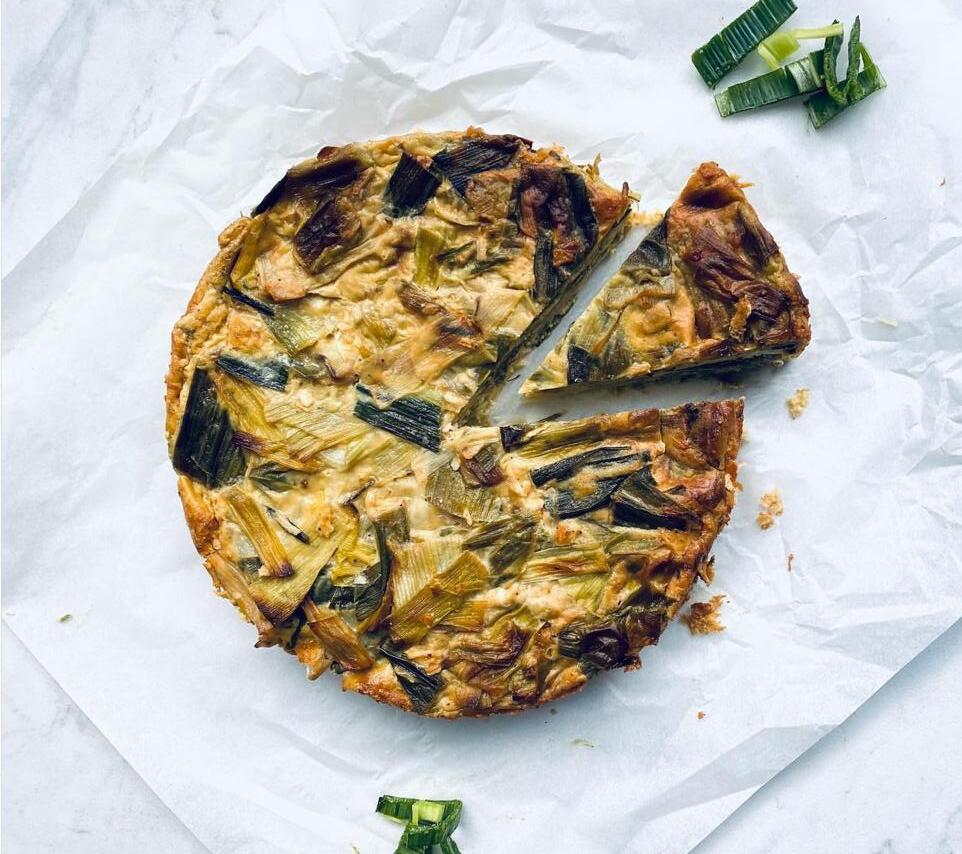
Amy’s Leek Pie
Amy Stopnicki is a mother, successful food writer and winner of the 2017 Gourmand Culinary Award for her book, Kosher Taste (Feldheim). She lives in Toronto with her husband and four children.
@amystopnicki
Ingredients
3 leeks cleaned and checked, sliced
4 eggs
1/2 cup flour
2 tablespoons oil
1/2 teaspoon baking powder
3 tablespoons dried onion flakes
Salt and pepper to taste
Instructions
1. Preheat oven to 350°F.
2. Heat oil in a large skillet and saute leeks until soft. Approx. 15 minutes.
3. Mix remaining ingredients in a mixing bowl.
4. Add leeks and combine well.
5. Pour into a greased 9 inch round baking dish and bake for 45-50 minutes or until thoroughly cooked.
COLLIVE MAGAZINE ADAR II 5784 83
Potato and Bone Marrow
I was working with another amazing chef, Bracha Serle, who was helping me with some catering, and we had a ton of marrow bones and potatoes left over after a long day of cooking. We decided to roast them together on a big baking sheet and the results were spectacular! This will make a perfect side dish on Shabbos and also impress your guests with its flavor.
Naomi Nachman is a world renowned cooking instructor, food columnist, recipe developer, and personal chef. Originally from Australia, she now lives in Woodmere, New York with her husband and children.
@NaomiNachman
Ingredients:
8 Yukon Gold potatoes, peeled and quartered 8 marrow bones
1 tablespoon kosher salt
1 teaspoon paprika
1 teaspoon garlic powder
1 teaspoon onion powder
2 tablespoons tomato paste
Instructions:
1. Preheat oven to 350°F. Line 2 baking sheets with parchment paper; set aside.
2. Place potatoes into a large bowl; add marrow bones. Season with spices and tomato paste; mix well to coat.
3. Divide potato mixture between prepared baking sheets. Cover with foil; bake for 1 hour.
4. Increase oven temperature to 400°F. Uncover baking sheets; bake 15 minutes, until golden brown. Remove from oven; allow to cool.

5. When cool, remove marrow from bones; discard bones. Toss marrow with potatoes; warm in oven before serving.
Broccoli Kugel
This issue's Shabbos sides include a lot of unique options, so here’s a more classic recipe for you. It might feel intimidating to make a good Broccoli Kugel but this one is foolproof. Every time I make it, it comes out perfect and takes less than 20 minutes of prep time.
Sruly Meyer, the writer behind our food and music sections, operates his own marketing agency in Hollywood, FL. He is also a home cook who runs a food and travel blog discussing fitness, local food scenes and daily life being a Jewish father and business owner.
@SrulyCooks
Ingredients:
1 tablespoon vegetable oil
1 onion, sliced.
4 eggs
1 cup mayonnaise
1/2 cup of all-purpose flour
Salt and pepper to taste
2 (16 ounce) bags frozen chopped broccoli, thawed
Instructions:

1. Preheat the oven to 375°F (190° C) and grease an 8x8-inch baking dish.
2. Heat vegetable oil in a skillet over medium heat. Stir in onion; cook and stir until softened and translucent, about 5 minutes.
3. Reduce heat to medium-low, continue cooking and stirring until onion is very tender and dark brown, 15 to 20 minutes. Set aside.
4. In a large bowl, beat eggs with mayonnaise, flour, salt, and pepper. Stir in broccoli and cooked onion. Pour the mixture into the prepared baking dish.
5. Bake in the preheated oven until broccoli is tender, about 90 minutes.
COLLIVE MAGAZINE ADAR II 5784 85
The Ancient Cherem s
That siddur you took from Shul might cost you more than you think
 Rabbi Shraga Homnick Sgan Rosh Kolel L’horaah Maasis
Rabbi Shraga Homnick Sgan Rosh Kolel L’horaah Maasis

With Pesach not too far off, you may have occasion to review the seforim on your shelf and take stock of your sefer inventory. As you do so, there’s a reasonable chance you may spot a sefer which, upon examination, will turn out to be stamped as being the property of a shul or similar institution. While the wording featured in the stamp may vary, there’s a reasonable chance it may read along the lines of: Assur l’hotzi bli reshus ha’gabbaim, it is forbidden to remove from the shul premises without permission. And in some bastions of tradition, the language may be even harsher: Cherem Ha’kadmonim shelo l’hotzi shum sefer mi’beis hamedrash, there’s an ancient ‘cherem’ against removing any sefer from a place of learning. Which raises the following question: if such a cherem actually exists, would having this sefer in your possession mean that you are now literally in cherem?1
While this outcome feels unlikely on an intuitive level, this query actually gets at a larger question regarding any of the well-known prohibitions described as a cherem; if there’s a ‘Cherem D’rabbeinu Gershom’ against reading someone’s mail, what exactly does ‘cherem’ mean here and what are its applications?2
The answer to these questions is actually not especially clear, but regardless, the consensus is that the label ‘Cherem D’rabbeinu Gershom’ or similar signals that these particular communal takanos should be taken extra seriously.
(Of course ‘Cherem D’rabbeinu Gershom’ has an especially powerful hold on how marriage and divorce are practiced within the Ashkenazi Jewish community, regardless of the underlying questions regarding the precise nature of the cherem).3
At any rate, if there was in fact a documented ‘cherem ha’kadmonim’ against taking seforim from shul, this would seem like a serious matter indeed, but there’s an intriguing question some ask which adds a new wrinkle to the discussion: What evidence is there that such a cherem ever existed?
Some point to a passage in Shulchan Aruch, Choshen Mishpat, towards the end of siman 163, where Rama writes: Nimtza b’takanos kedumos, there’s an entry in the historic takanos which states not to remove a tallis or a sefer from shul without the owner’s permission. Might this be the elusive source of the ‘cherem ha’kadmonim,’ as some have
understood?
Others have argued4 that this is all one big misunderstanding - in the manuscripts which enumerate these ancient takanos5 there is additional wording which clarifies that this is being stated specifically in reference to people embroiled in a financial dispute, when one party may be inclined or justified to seize the possessions of his adversary, which led the kadmonim to declare that personal religious items in shul should be ‘off-limits’ to acts of seizure and confiscation, a safe space if you will. This would have little to do then with the ordinary scenario of a sefer from a shul being borrowed or inadvertently removed from the premises. Some would therefore argue that these little cherem warnings invoke a nonexistent precedent and are therefore meaningless.
Whatever you think is the correct pshat in Rama with regards to the disputed existence of a ‘global’ takanah, however, there certainly is evidence of a more ‘localized’ phenomenon in cities and towns in Europe which had a cherem concerning seforim.
None other than the Tzemach Tzedek6 discusses a question he received from the nearby town of Rudnya, regarding the cherem
86 COLLIVE MAGAZINE ADAR II 5784

they had ‘mi’shanim kadmoniyos’ against removing seforim from the town beis medrash, with an exception made if a ‘moreh’ (someone who paskens for the community) needed to consult a particular sefer. Many prominent community members had since erected and moved to a newer beis medrash and felt they were justified in moving a significant portion of the town’s seforim library to the new site, but they were paralyzed by a lack of clarity regarding the scope of the town’s ancient cherem: Had it been enacted to ensure that the seforim would be kept in any local beis medrash, or did it go further and restrict the use of these seforim to that one particular beis medrash? There was no hard documentation from the enactment of the old cherem, so there was only one other means of resolving this: Was there a halachic path for them to be matir the cherem just to be sure? (The Tzemach Tzedek took this question very seriously7).
This (and related discussions in teshuvos written at the time) suggests that at least in some instances, there was understood to have been a local such ‘cherem ha’kadmonim.’
Be that as it may, are we to assume

that, accepting the premise that we are not bound by any such cherem today (and most Jewish communities including Chabad appear to no longer invoke it), we can declare open season on grabbing seforim from your nearest shul?
Not so fast. R. Shmuel Aboab, a prominent 17th century rav in Venice, Italy, wrote a teshuva8 to a question he received from the city of Split, Croatia (which was part of the Republic of Venice at the time), inquiring whether seforim which had been donated to be used at the shul could be taken home for personal use. In his response, he uses the term shinui mi’daas ha’baalim, diverging from the intent of the donors, which he says is prohibited.
In other words, even if (contrary to nabbing someone’s personal sefer) borrowing a sefer from shul feels like a victimless crime and somewhat still broadly in spirit with the sefer being placed out there for common use (and even if no one immediately misses it, and even if it’s returned in a timely fashion), it still runs afoul of the fact that this sefer is not hefker, and its use is governed by the intention of the individual who donated it, and/or the gabbaim who govern the use of

the shul and its property.9
And so, if you come across a sefer on your shelf with the shul’s stamp in it, do make an effort to return it promptly. Or act on the wording inscribed in the stamp and get reshus from the gabbaim.
1. The question is posed this way in Shaalos U’teshuvos Divrei Shalom vol. 2 (1973), siman 94.
2. See Shaalos U’teshuvos Bnei Banim vol. 3 (1997), siman 17.
3. On the topic generally see Encyclopedia Talmudis vol. 17, pgs. 378-454; see also adjacent entries relating to cherem; and see also fn. 5 below. For a spiritual perspective see the sicha of 12 Tamuz, 5727 (it is perhaps worth noting that it appears that the Rebbe avoids the word ‘cherem’ (which is evident elsewhere as well) and instead says ‘takanah’).<?>. Sefer Haniggunim Niggun 54.
4. See Kovetz Beis Vaad La’chachamim, no. 7 (5772), pgs. 340-354. It appears that the premise and much of the presentation and sourcing in the article is lifted without attribution from Mazkeres Immanuel (1947), pgs. 114-124.
5. See appendix of Encyclopedia Talmudis ibid. pgs. 757-772 for a full listing of charamim and takanos linked to Cherem D’rabbeinu Gershom as they appear in multiple early sources including manuscripts. In all there are 83 takanos listed there; the takanah under discussion here is #27.
6. Shaalos U’teshuvos, Yoreh Deah, siman 194.
7. In shiurim delivered two years ago, I explored this and related teshuvos of the Tzemach Tzedek that probe the limits of a communal takanah enacted by cherem.
8. Shaalos U’teshuvos Dvar Shmuel (1702), siman 91.
9. For another contemporary discussion of these halachic issues, see Vayomer Shmuel (5768), siman 7.

PLEASE G-D, SEND THEM A SIGN THAT I’M RIGHT. IT’S THREE OF US VS ONE OF YOU SO WE’RE RIGHT! SEE? G-D IS ON MY SIDE! EH, THAT’S JUST A PASSING STORM… PLEASE G-D, A BIGGER SIGN!! OKAY… BUT NOW IT’S JUST THREE TO TWO. WELL? HEIS RIGHT! DAFNE ZIVAN, ILLUSTRATOR - ELIE BENHIYOUN, EDITOR | GROMYBRAND.COM seriously?!
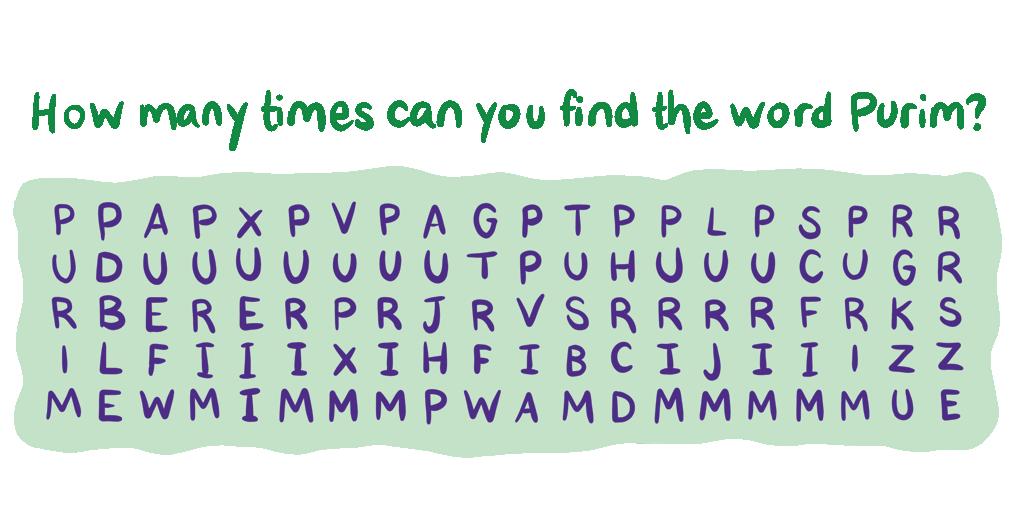
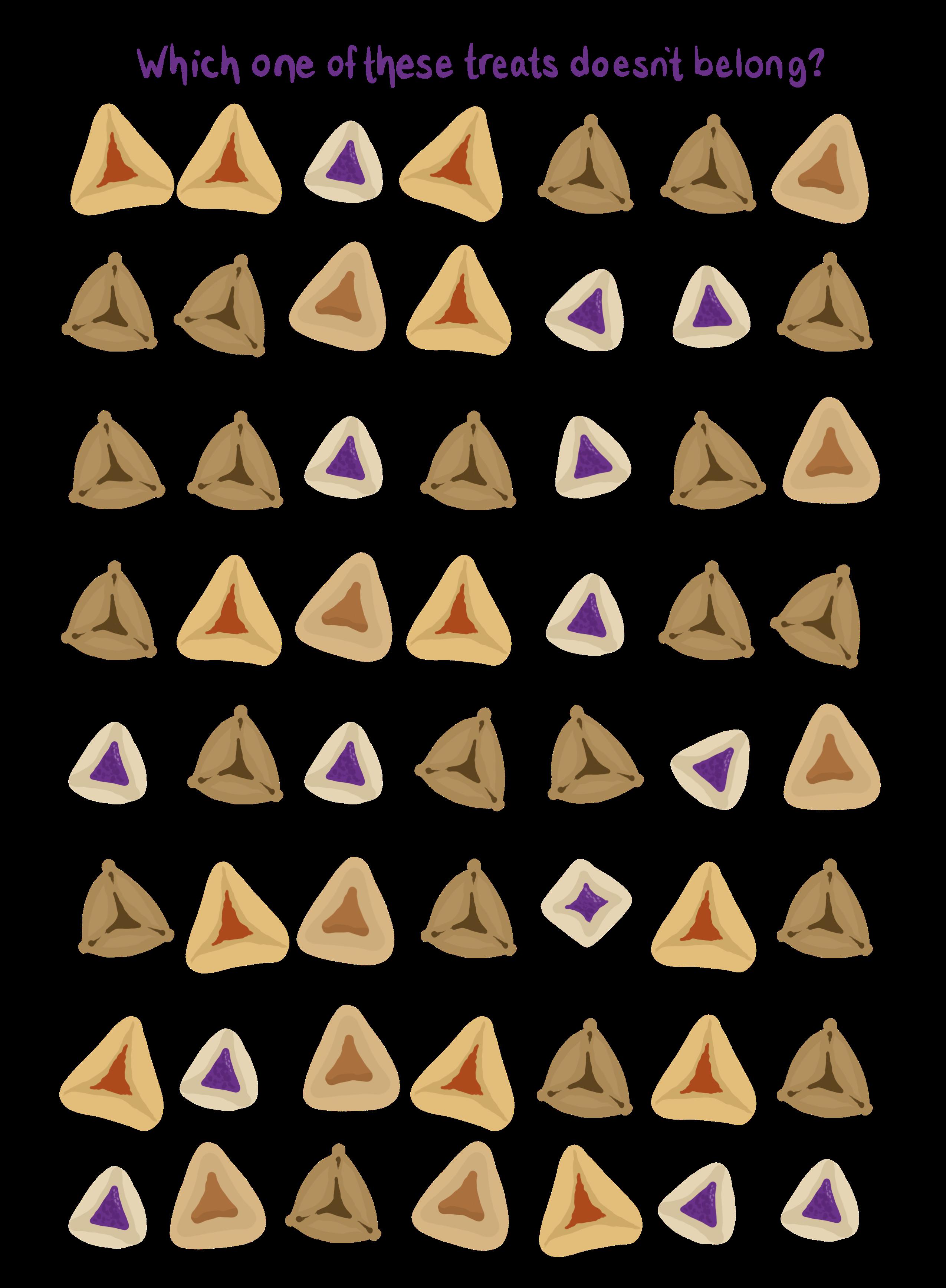





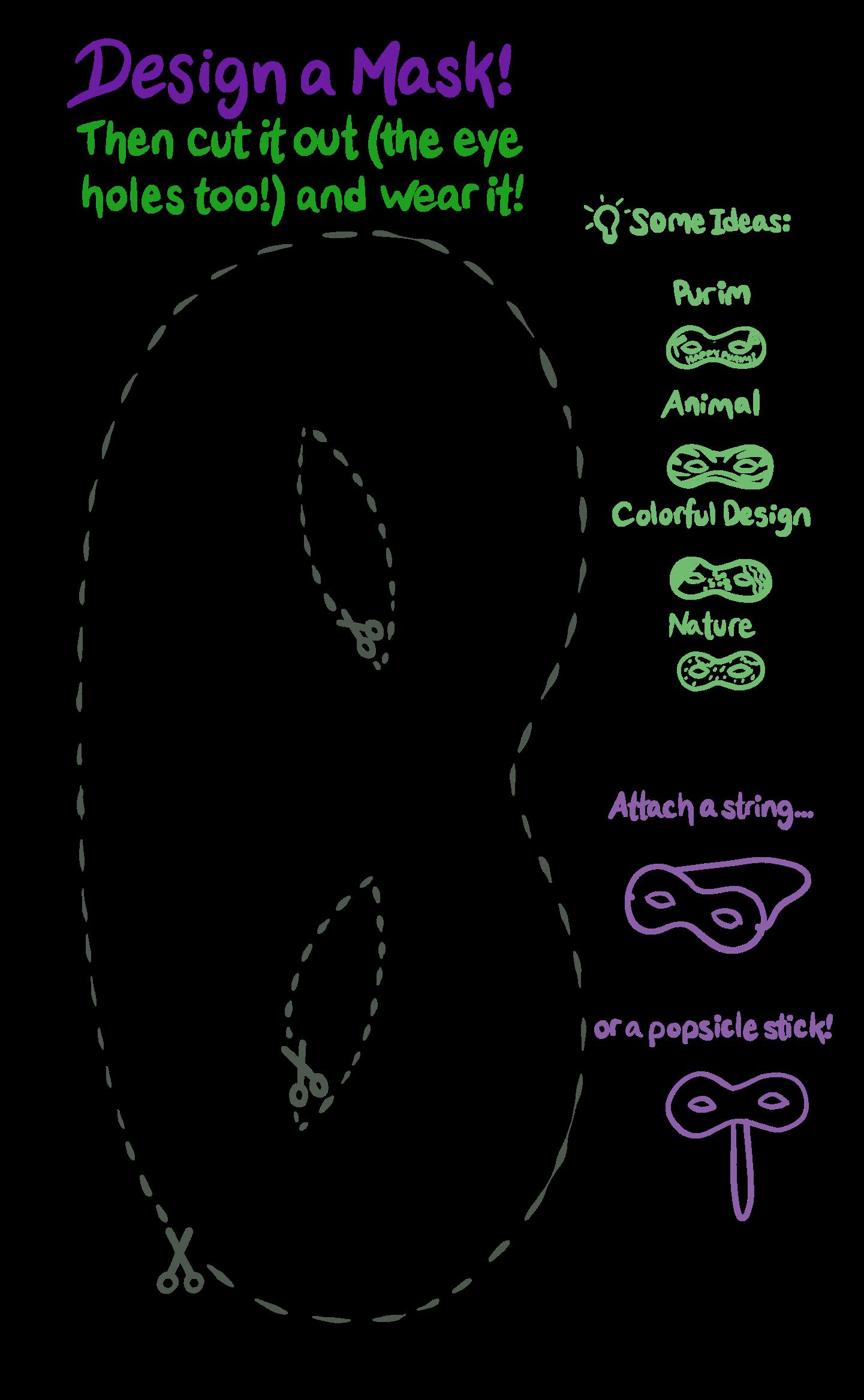

Purim
DID YOU KNOW? IMAGINE
Hamentashen teaches the hidden lessons of Purim, just like the delicious filling inside the pastry.

You are playing in your favorite park, enjoying every moment sliding down all the slides and swinging on the swings. Suddenly, while playing hopscotch with your friends, you trip and fall. Ouch! Unfortunately, you have hurt yourself and can no longer play with everyone else. Therefore, you have to sit on the side and watch the others play. Sitting on the side is boring & you start looking around at what else is happening in the park. Suddenly, you notice a little baby walking outside of the park all by herself! Without hesitation, you call out to her mother and alert her about the situation. The mother runs to pick up her baby and bring her back to the park. Afterwards, the mother comes over and thanks you for your help. She would have been so scared if the baby had gotten lost, and now, thanks to your alertness, the baby is safe. It’s amazing to think that if you weren’t hurt and sitting on the side, you wouldn’t have been able to catch the baby. I guess everything happens for a reason.
DELVING DEEPER
BRING IT HOME
How can the story of Purim and Hamantashen help us remember how to react when things don’t go well?
In the story of Purim, Esther was among the young girls who were taken to the palace. Eventually, she became the queen, but it was not something she had wanted. At first, Esther felt upset about her situation. However, when a plan to harm the Jews was discovered, Queen Esther found herself in the right place at the right time to help. Thanks to her efforts, all the Jews were saved. When we eat the delicious Purim pastry called Hamantashen, we can remember the story of Purim and remind ourselves that even in difficult situations, there is always some good to be found. We should trust that everything that happens is part of Hashem’s plan & for the good, even if we can’t always see it.
B”H
S’mores Hamentashen
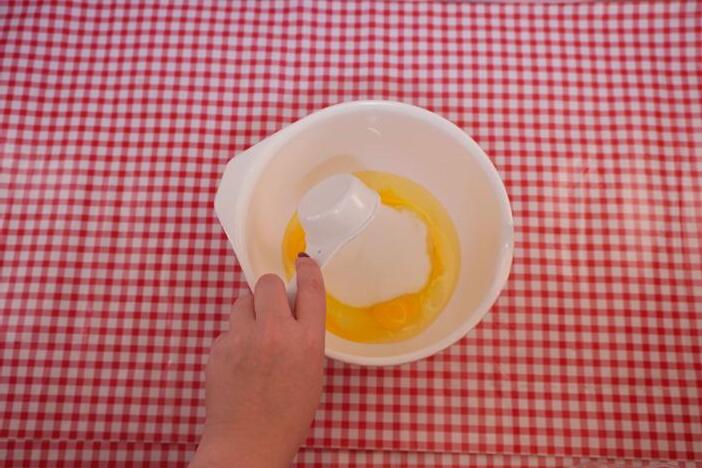
Preheat your oven to 350°F. In a large bowl, thoroughly mix together the eggs, sugar, and oil.

Press the cookie cutter into the dough to make circles and remove excess dough.

Re-pinch the corners of the hamentash to create a seal, place on a cookie sheet & ask an adult to bake for 14-16 minutes, until set, but not hard.
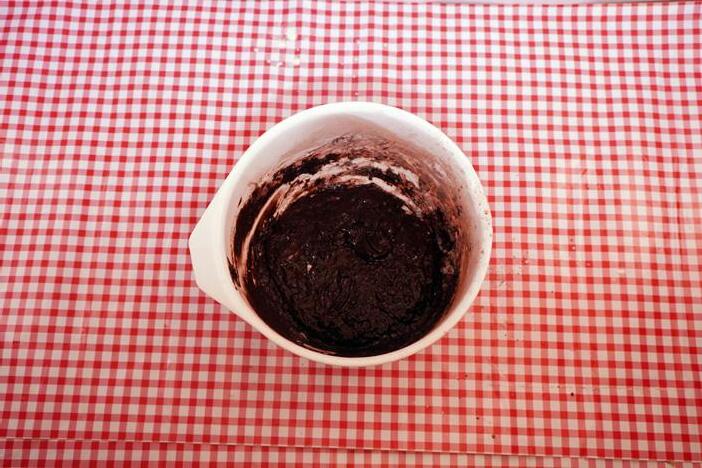
Add baking powder, flour, and cocoa. Mix until dough forms. Cover and chill for 45 minutes.

Place a small spoonful of marshmallow fluff in the center of the circle.


Take a large piece of dough and roll it out using a rolling pin until it is 1/8 inch thick.

To form the hamentash shape, tightly pinch together three corners of the dough to create a triangle. Repeat this process with the remaining dough,
Spoon Rolling Pin Mixing MeasuringBowlCups
Parchment Paper
3-inch Circle
3/4CupCocoaPowder 1TspBakingPowder Marshmallow Fluff 11/4CupsSugar 21/4CupsFlour 1/2CupOil 3Eggs
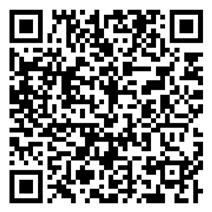
PARSHA
B”H
Cutter/GlassCookie Cup SUPPLIES
1.
2.
4.
5.
6.
7.
8.
3.
Your Hamentshen are ready! Make a Bracha & enjoy. A Freilechen Purim! INGREDIENTS
Costume Conundrums
A humorous take on why dressing up all year doesn’t work.
By Mordechai Schmutter

Purim costumes are a lot of fun. We should wear them all the time, right?
Wait, why DON'T we wear them all the time?
Well, I guess we'd get lots of sideways glances, especially at the DMV. And airports. And anywhere we have to show I.D.
There are also other reasons:
1. They fall apart over the day For example, one year, my daughter dressed up as a banana (complete with a hat that represented the top of the banana, the point of which kept flopping over so it looked like a combination banana hat/ shluff Koppel). But the hat kept falling off, so by the end of the day, she was just the bottom half of a banana, which was turning brown. My oldest son was a clown, and he ended the day with face paint all over his clothes, including his comically oversized tie, which we then had to wash, and shrunk it. So now it's just a regular tie, except that it's orange.
Another son, Heshy, was dressed as a video-game character and had a mustache made of black magic marker (80% of the mustaches you see on a regular basis are really just black magic marker), but he spent the whole day picking at his nose, and by the time we got to my
parents' house for the seudah, he had a beard. Meanwhile, both he and my third son had costumes that were one-piece flimsy jumpsuits with a zipper in the back that they couldn't get out of for pit stops. And they were drinking all day because every one of their friends put a can of soda in their mishloach manos.
2. Many costumes are inaccurate
People love dressing up like historical figures such as Mordechai HaTzaddik, which sounds like a good idea until they realize that they have no idea what he actually looked like. Sure, all the coloring books feel that he wore a shtreimel, but what kind of animal do you make a shtreimel out of if you live in Persia? Lizards? How do we communicate with people that we're dressed as Mordechai and not just another rabbi who, for some reason, is wearing an iguana shtreimel?
That was a huge question that I had growing up. But nowadays, according to an ad I saw, you can actually buy a bright red Mordechai HaTzaddik costume and also a Dovid Hamelech costume, and the two are totally identical except that their names are written on their respective capes. (Also, there are capes.) They did that on purpose so no one would mix them up, even
though they lived hundreds of years apart. Even though, if there's one thing we know about Mordechai's costume, it's that Haman's daughter couldn't tell it was him, which would be really strange if it said "Mordechai HaTzaddik" on his costume in huge letters.
There are also imahos costumes nowadays – you can be 2 of the 4 imahos. There's no Sara or Leah, but you can dress up as Rivka, for example. The way people know you're Rivka is that it says "Rivka Imeinu" on your shirt, even though the only way Rivka would ever own a shirt that said "Imeinu" on it is if Yaakov and Eisav went in together to buy it for her. The outfit also has pictures of camels on it, which I suppose is okay, even though there's really only one story in the Torah in which she interacted with camels, and I doubt she was so obsessed with them that her children would have them embroidered on her dress. I also saw a Goldilocks costume with the three bears embroidered on it by someone who clearly didn't understand the Goldilocks story. There's also a costume of Rochel Imeinu, which of course says "Rochel Imeinu" on it, even though she didn't actually have a second child until the day she was niftar. And to rub that in, it has a picture of
92 COLLIVE MAGAZINE ADAR II 5784


Kever Rochel. I can't say that I know what Rochel Imeinu wore in her day-to-day life, but I'm about 90% sure it wasn't a shirt with a picture of the place where she was going to be buried someday.
3. Many costumes are offensive Nowadays, you can't wear anything that is racially offensive. Even if you don't mean to offend.
"Look! I'm a Chinese person!"
You think Chinese people wear robes all the time? How do those not get caught on their bicycles? Or sometimes people put on a huge hat and a poncho and say that they're Mexican. I've seen many Mexicans in my life – stocking shelves in supermarkets, working

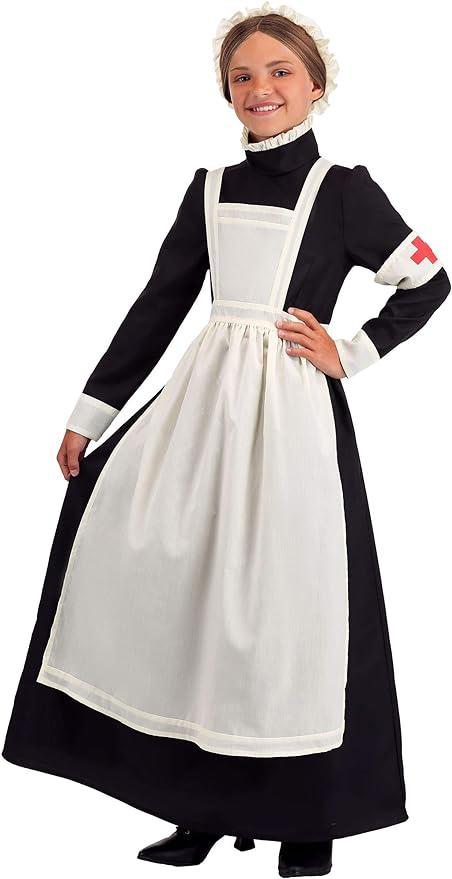
on my house – and not one of them has shown up in a poncho.
So the new rule is that you can't wear offensive ethnic costumes. You can offend a specific person, like President Obama, for instance. You can't dress up as an Arab terrorist; you have to dress up as a specific Arab terrorist. You have to do research.
"I'm not just an Arab. I'm Ayatollah Jones from 613 Dirt Street, Saudi Arabia. You know him? Then don't get offended. This is how he dresses. Sometimes."
4. There are certain costumes you can't even find at all Costumes I've never seen:
- Chosson
- Gabbai
- Shul candyman
- Charvonah
- Eisav
- Kohein hedyot

But if you think about it, we all wear costumes every day. Some day in the future, some kid will run around on Purim wearing exactly what you're wearing today and go, "Look! I'm an accountant from the olden days!"
And then someone will get offended.
COLLIVE MAGAZINE ADAR II 5784 93
Then Now AND
By Zev Gotkin


To most, 529 Empire Boulevard is just an ordinary kosher supermarket in Crown Heights where numerous families in the neighborhood shop for their daily needs. Many don’t realize that the large, white, two-story building between Balfour Place and Lamont Court was once a renowned theater.
Sitting on a 60-foot x 112.75-foot lot with 19,700 square feet, the building is 36,000 square feet and its dimensions are 150 feet x 100 feet. It possesses 4 units. Though it now has bold signage proclaiming it to be a kosher supermarket, the faded white paint with a red stripe, and the building’s tall, art deco facade with an arched window space belies its storied past as the Empress Theatre whose heyday was in the 1930s.
The Empress Theatre was built in late 1927. Designed by Charles A. Sandblom, an architect who designed many theaters throughout New York City, including the
Gramercy Theater in Manhattan, the Empress Theatre had a seating capacity of 1,595. In 1928 the theater was used for political gatherings. In 1931, the Jewish Center held a fundraiser there for the future state of Israel. And, in 1932, Talmud Torah of Crown Heights held a fundraiser at the Empress Theatre to help the needy obtain food for Pesach.
Originally part of the Century Circuit, the Empress Theatre became part of the RKO circuit in 1929 before closing in 1941. The theater re-opened in 1942 as the Crown Theatre, operated by Liggett-Florin Booking Service. According to After the Final Curtain, a website dedicated to preserving the memory of forgotten American theaters, the Crown Theatre switched to showing only Spanish language films in 1948. In 1951, the theater closed its doors for good. The former showplace has since undergone several uses,
529 BoulevardEmpire 94 COLLIVE MAGAZINE ADAR II 5784

including a stint as a dance hall, a furniture showroom, a banquet hall, and a nightclub.
Later, it became Associated Supermarket followed by Bravo Supermarket, and then Associated Supermarket once again. In 2007, the space became its current iteration, Empire Kosher Supermarket, owned and operated by Itzik Benabou, who also owns several other supermarkets in the neighborhood.
The ceiling on the second floor above the supermarket is all that remains of the former theater. Today, you can still see its gilded, golden proscenium arch and some intricate plasterwork featuring engravings that depict flowers, leaves, women’s faces, mandolins, and various lines and shapes. The former balcony is currently used for storage. Part of the space is used as an urgent care center.
Now as the site of Empire Kosher Supermarket, or
“Empire Kosher,” as it's known to locals, the space still draws a crowd as one of the most popular kosher supermarkets in the area. Often packed with parents and children wheeling carts full of groceries, especially on Fridays during the pre-Shabbos rush, it’s interesting to imagine that this building used to be filled with theater-goers.
The wheels of shopping carts now swiftly glide down aisles of kosher food where performers and speakers once dazzled audiences. 529 Empire is indeed a building that has undergone many acts over its lifetime and it remains a hub of activity in Crown Heights.
COLLIVE MAGAZINE ADAR II 5784 95


unitedrefuah.org
$199/ month
COUPLE:
$349/ month
FAMILY UP TO 6:
$499/ month
SAVE BIG ON MONTHLY HEALTHCARE COSTS AND JOIN THOUSANDS OF SATISFIED MEMBERS.
United Refuah is the only Jewish nonprofit healthsharing organization, unlike others that are deeply rooted in foreign religions and ideologies.
7
4
4
7
0 .
1 7 .
2 2 2
dartmedia.us
United Refuah is a non profit healthsharing organization. It is not insurance and doesn't offer insurance. See Sharing Guidelines for full details.
dartmedia.us









































 By Rabbi Yehuda Ceitlin
By Rabbi Yehuda Ceitlin



























 By Dovid Zaklikowski
By Dovid Zaklikowski


























 By Tzemach Feller
Dr. David Sclar turned a private collection into Yeshiva University’s landmark exhibit
By Tzemach Feller
Dr. David Sclar turned a private collection into Yeshiva University’s landmark exhibit









 By Dovid Zaklikowski
By Dovid Zaklikowski































 Mrs. Dena Gorkin Principal
Mrs. Dena Gorkin Principal
























 Nussi Sternberg Owner of Greenhill Trading
Nussi Sternberg Owner of Greenhill Trading













 Dudu Fisher wrapping up a successful tour
Dudu Fisher wrapping up a successful tour







 Rabbi Shraga Homnick Sgan Rosh Kolel L’horaah Maasis
Rabbi Shraga Homnick Sgan Rosh Kolel L’horaah Maasis































